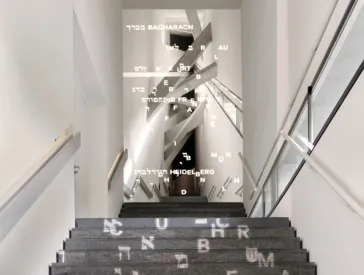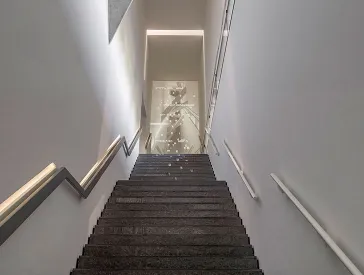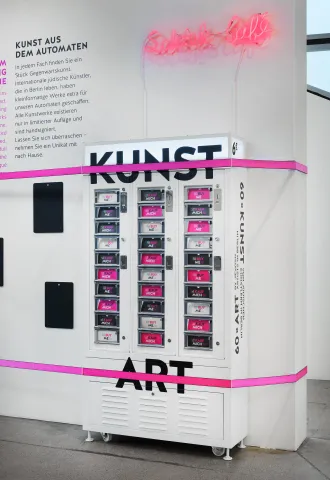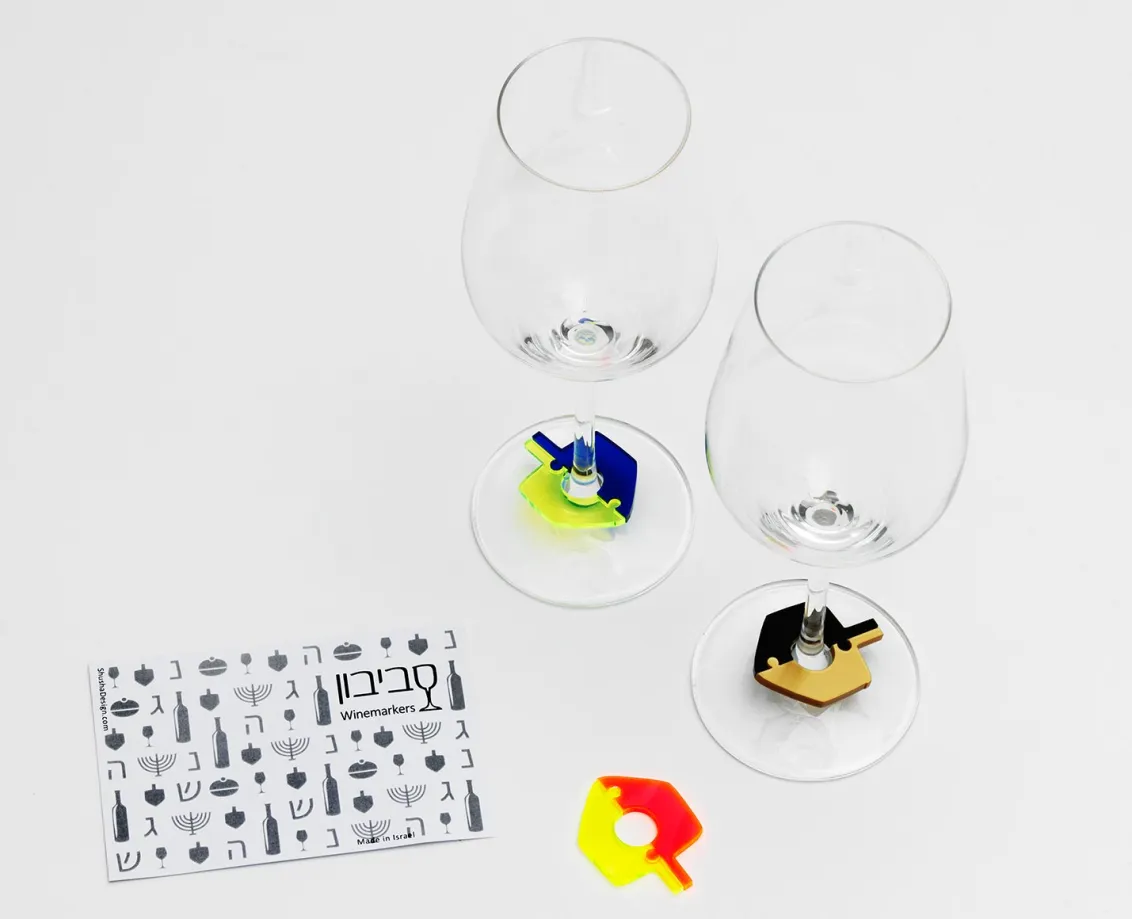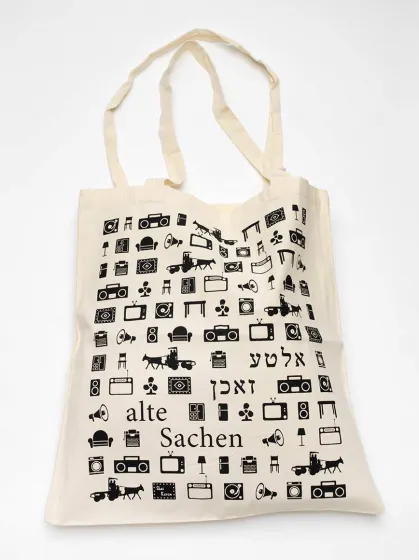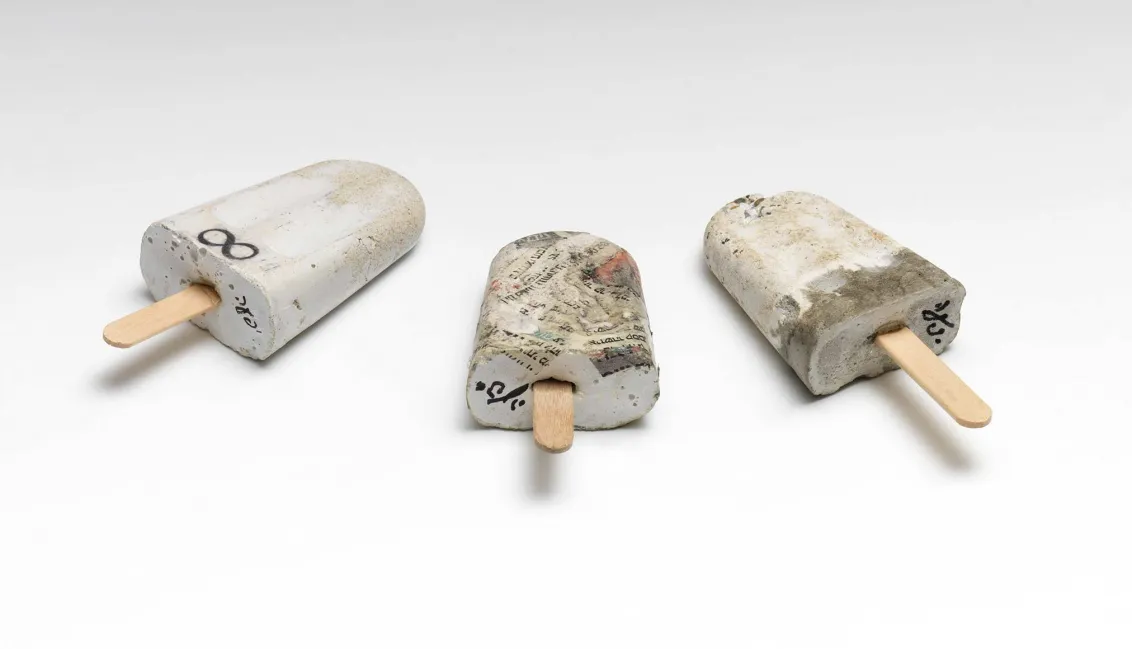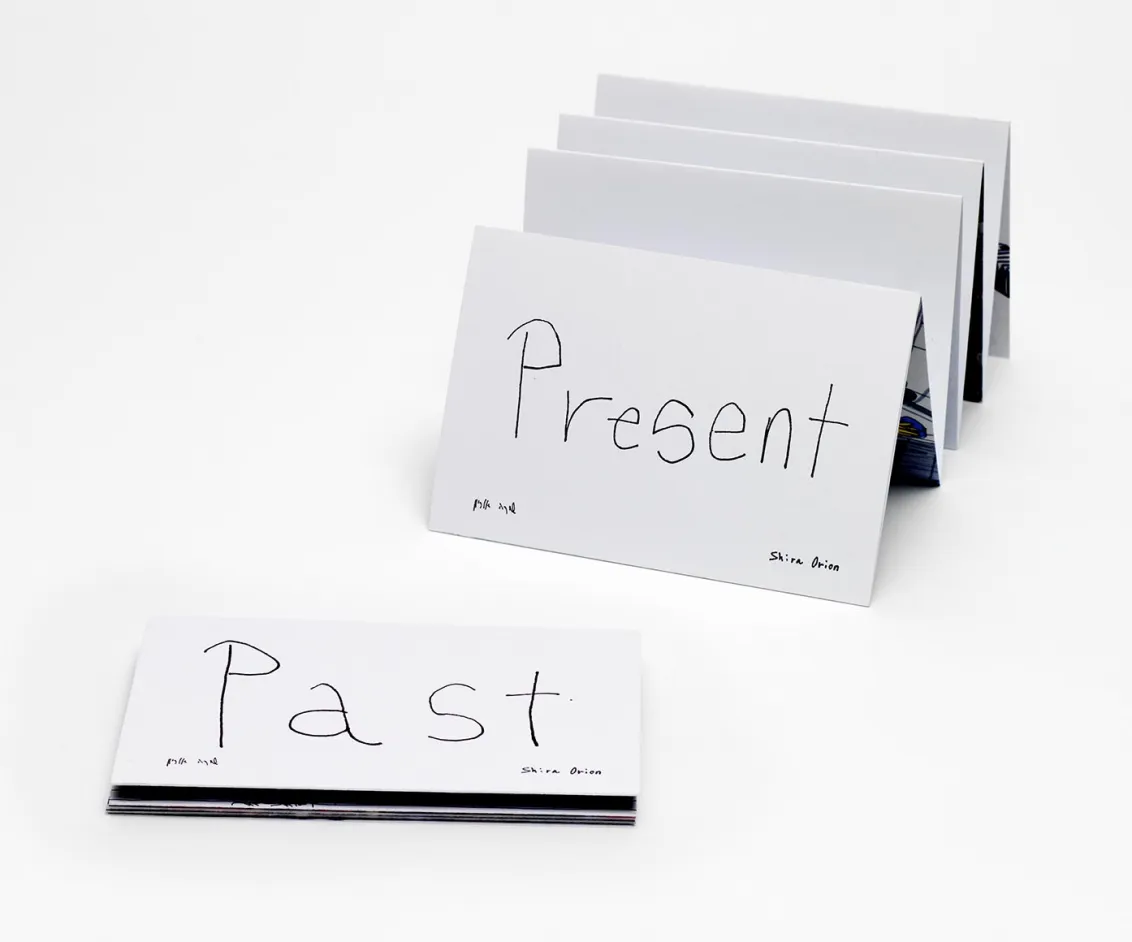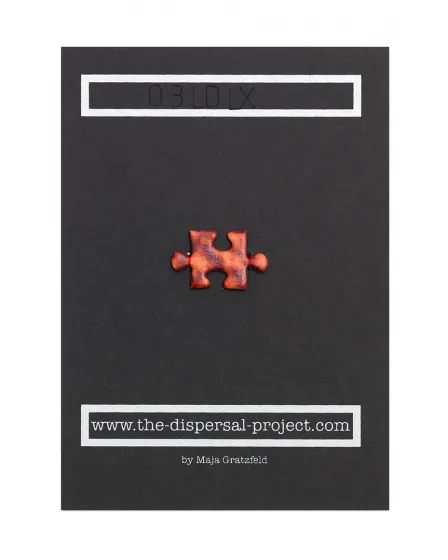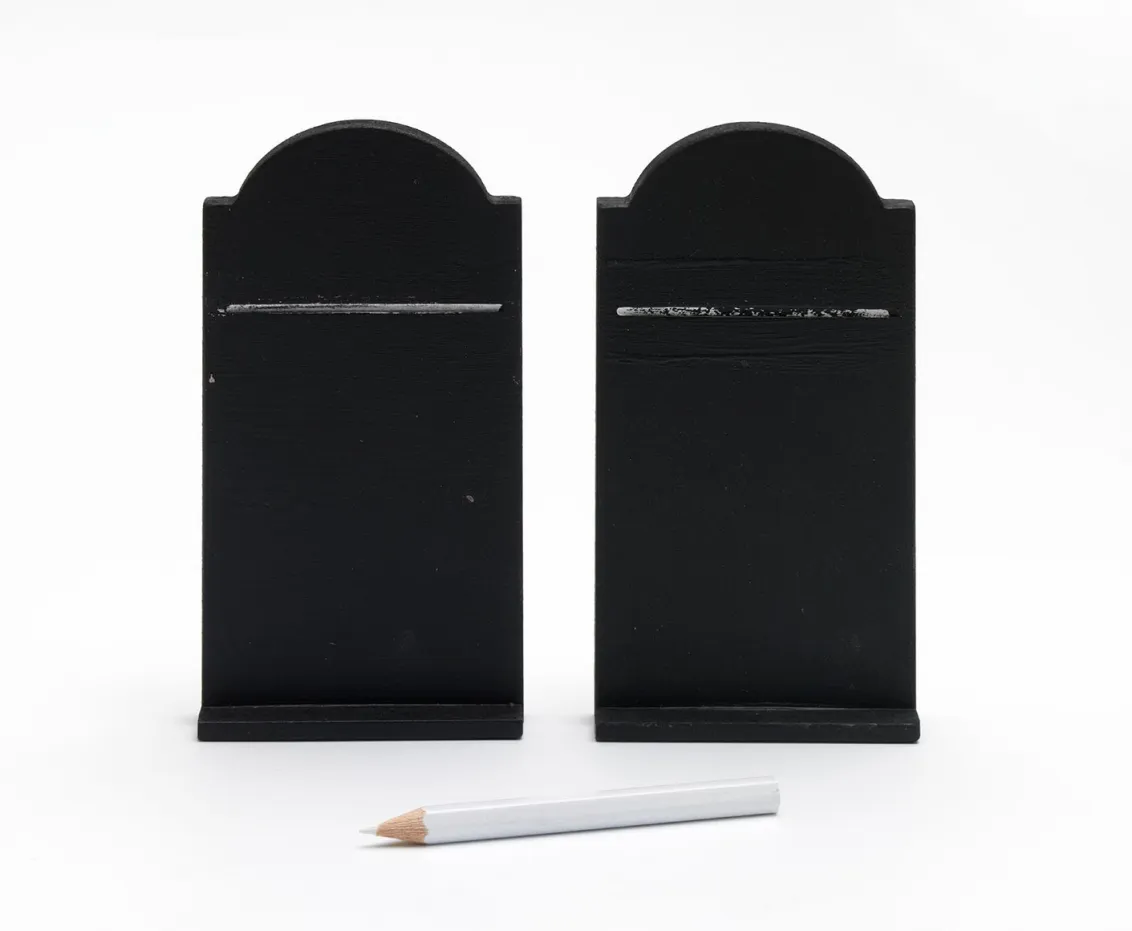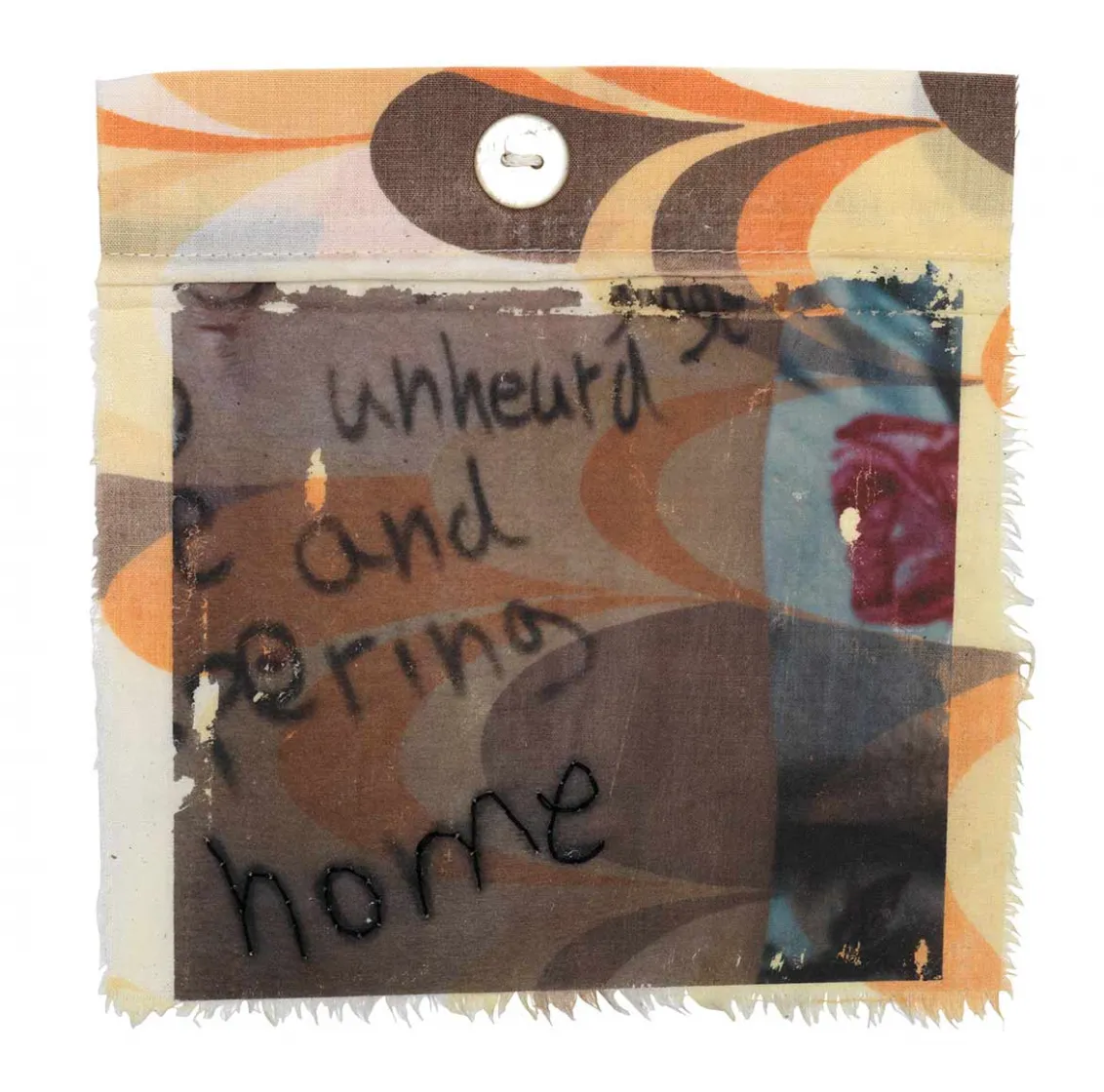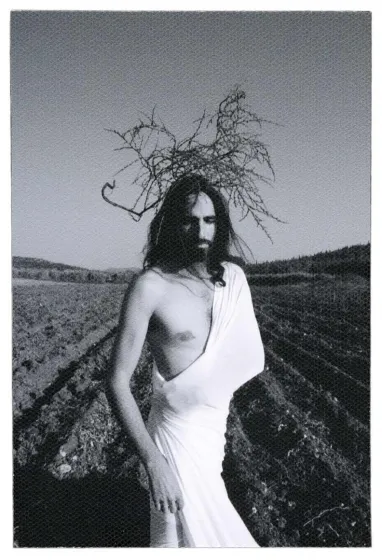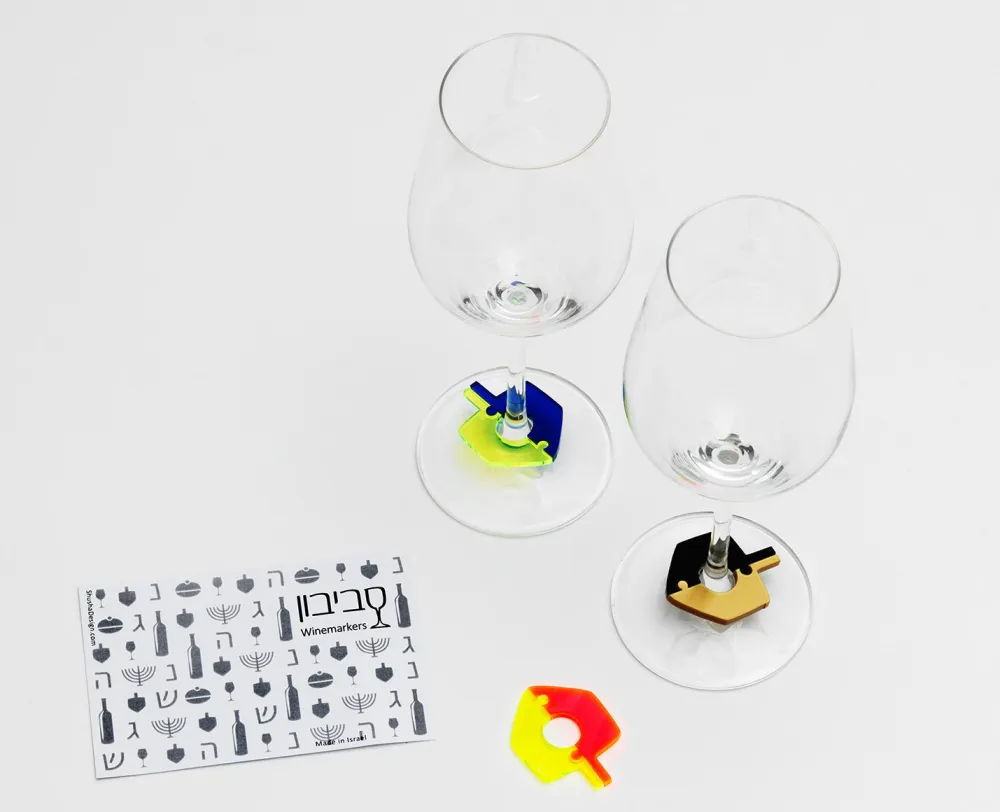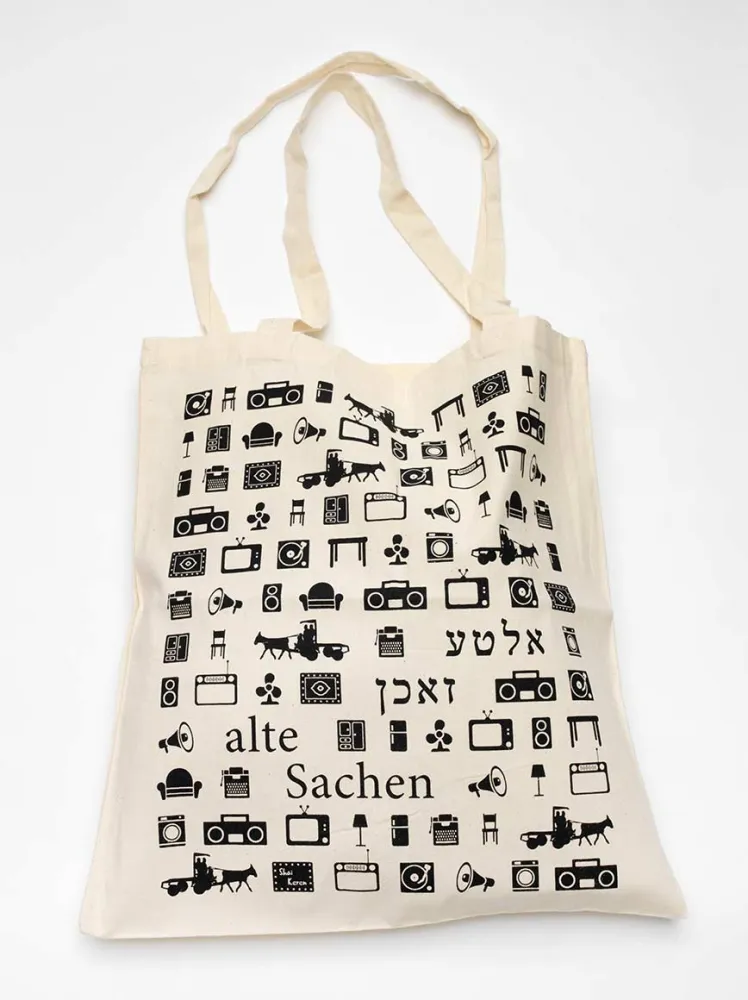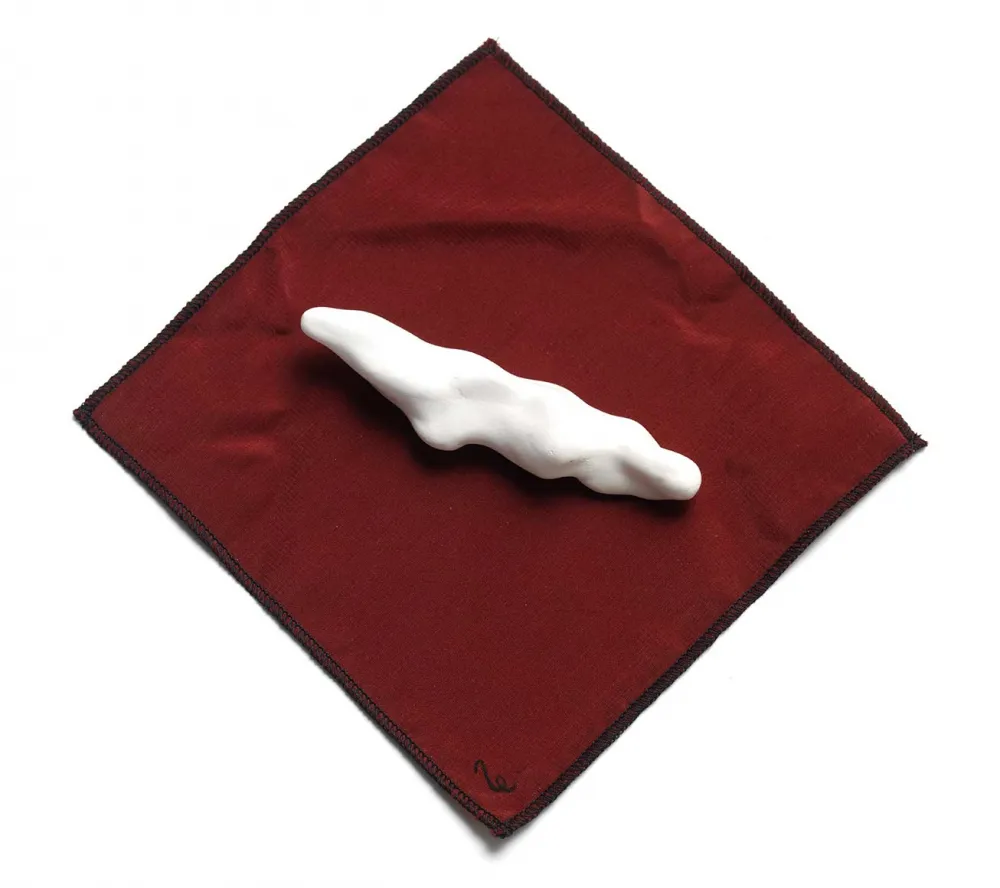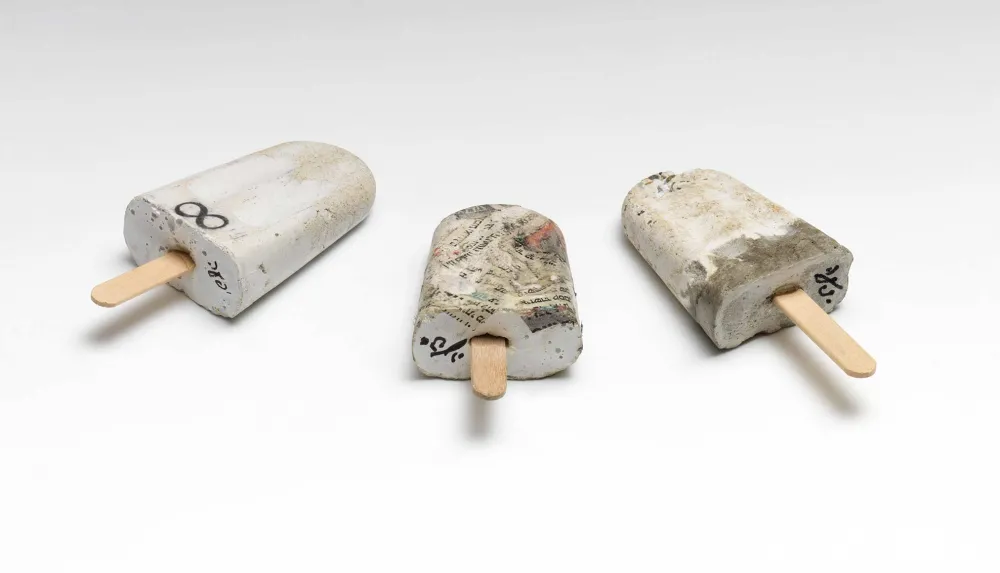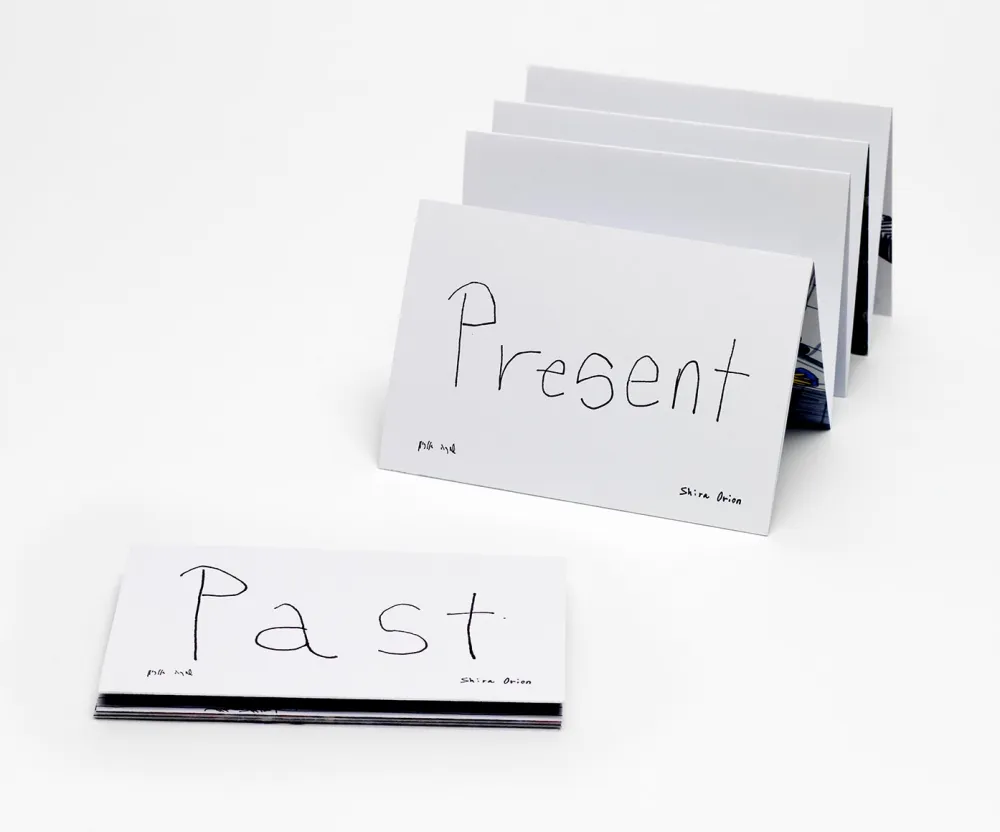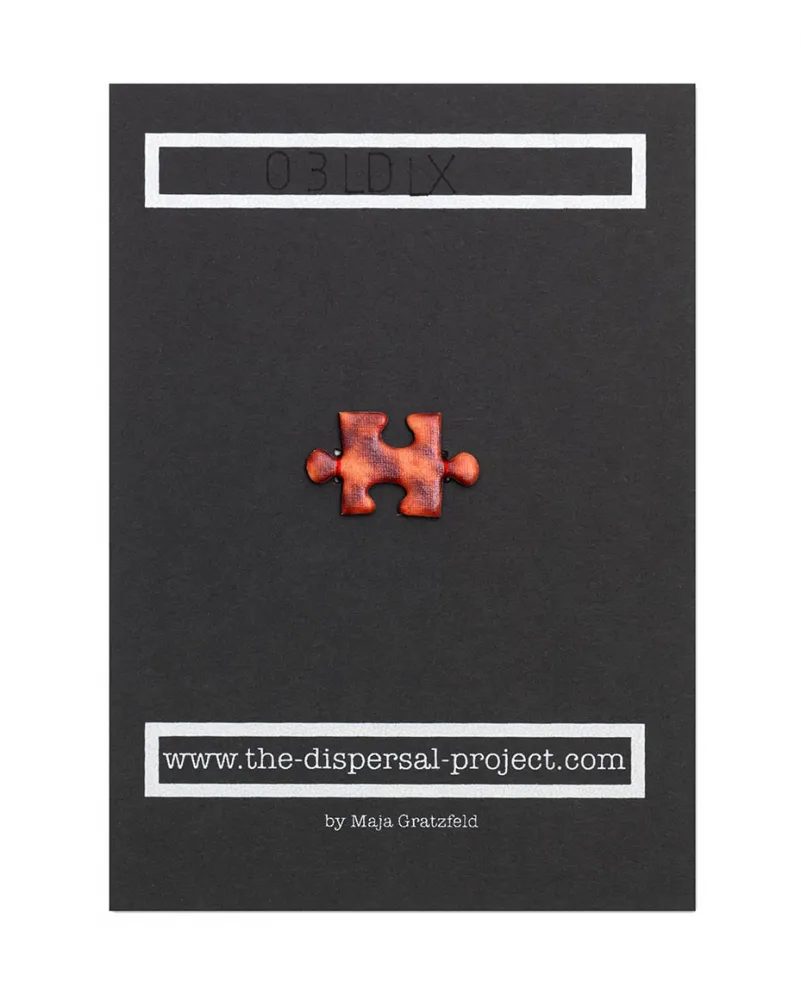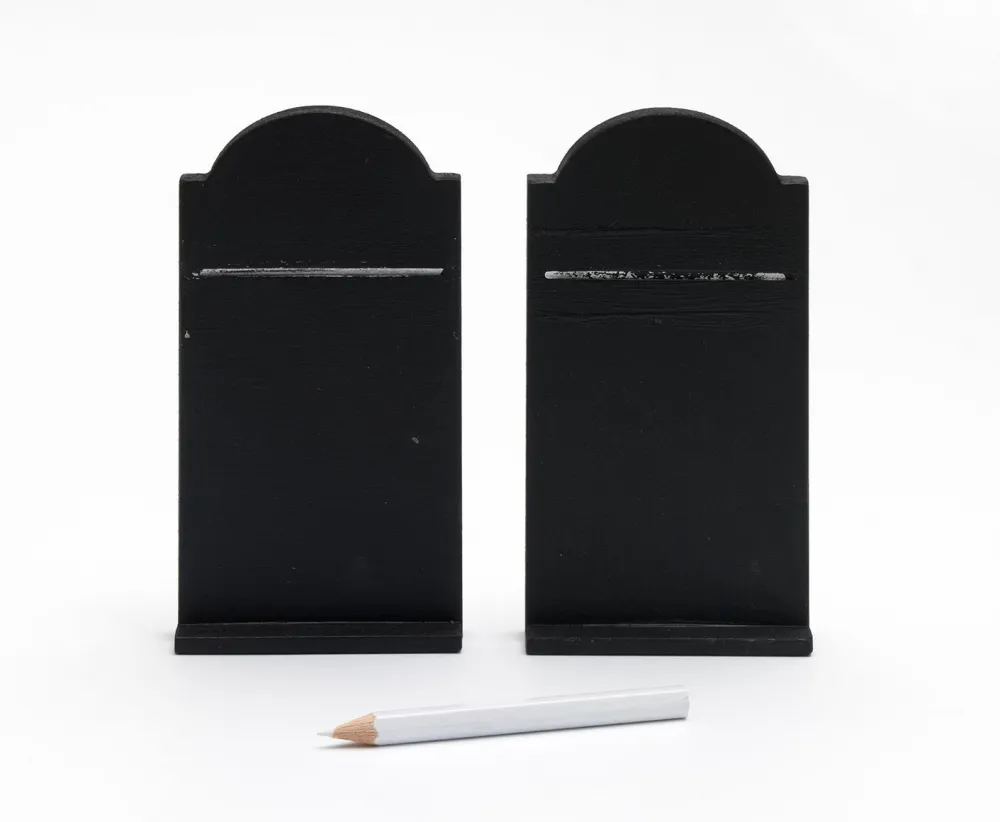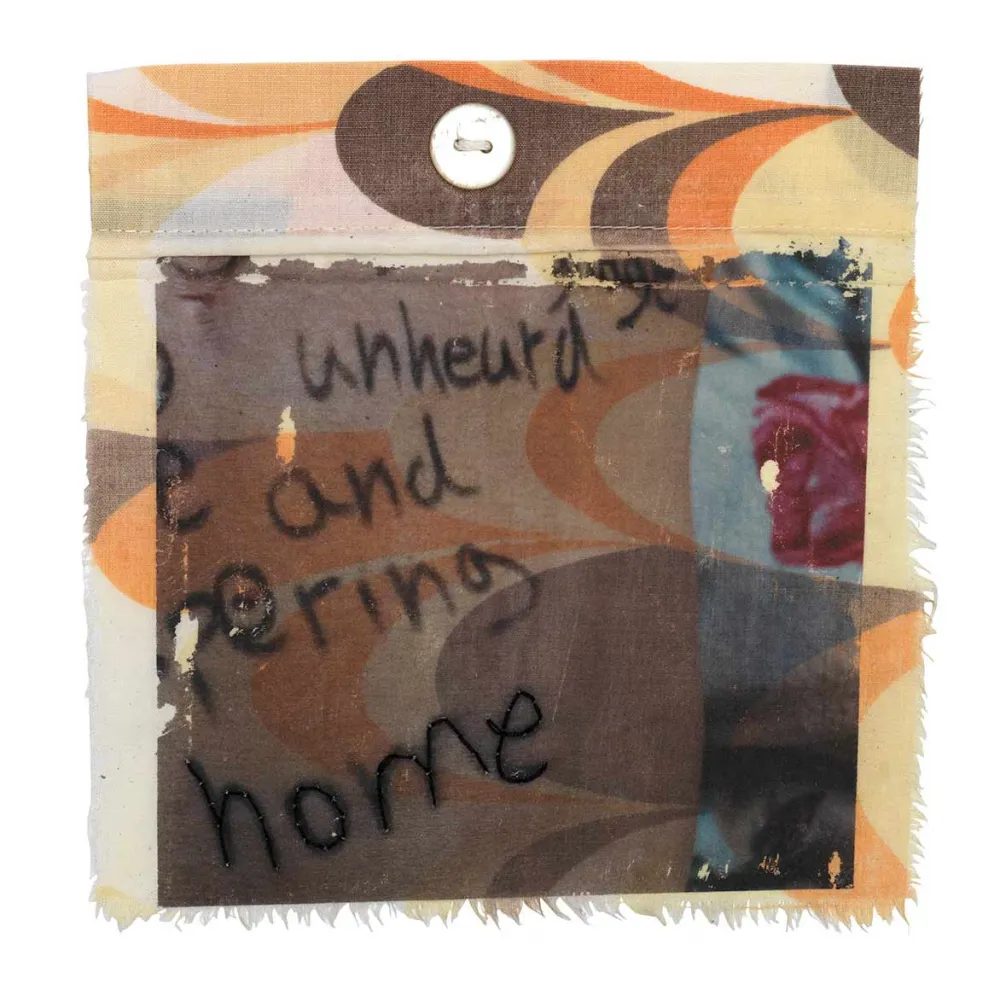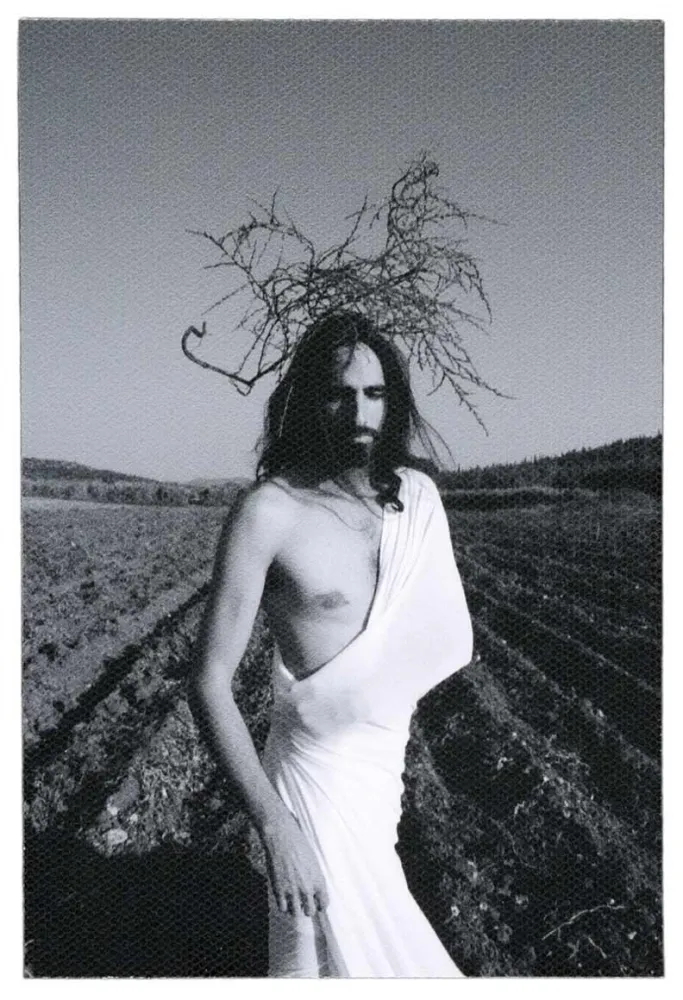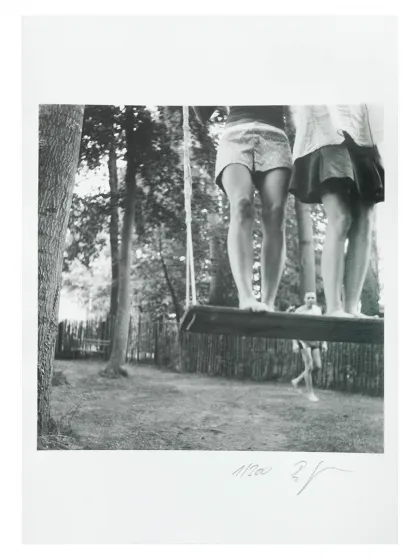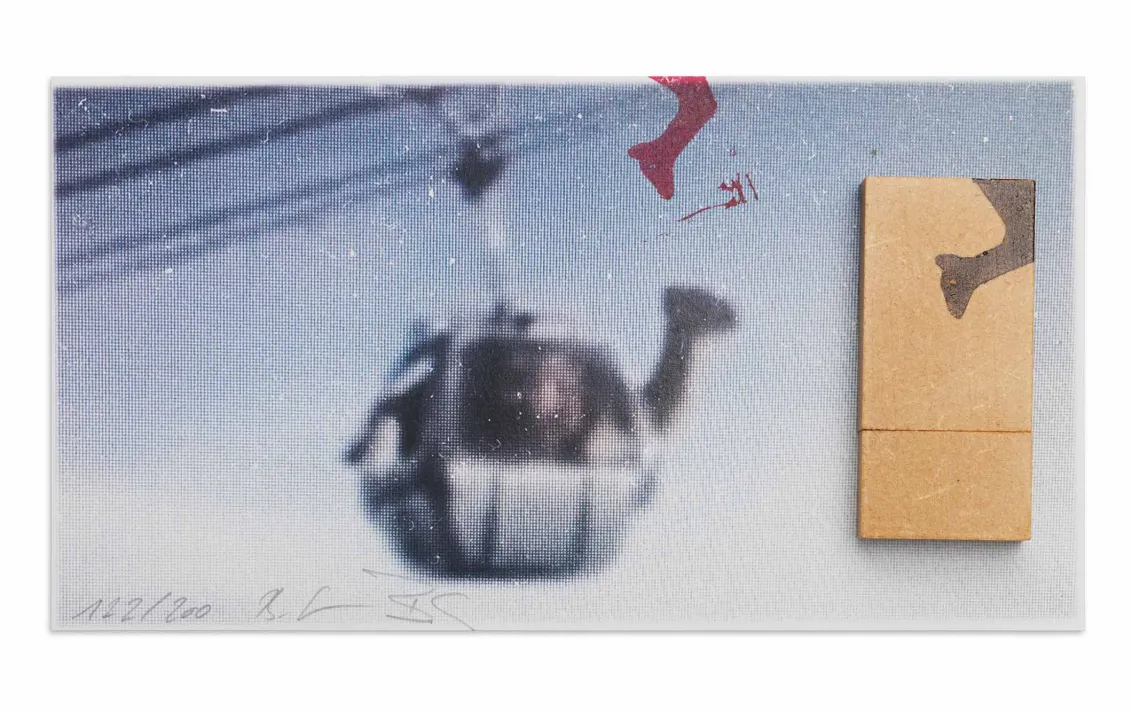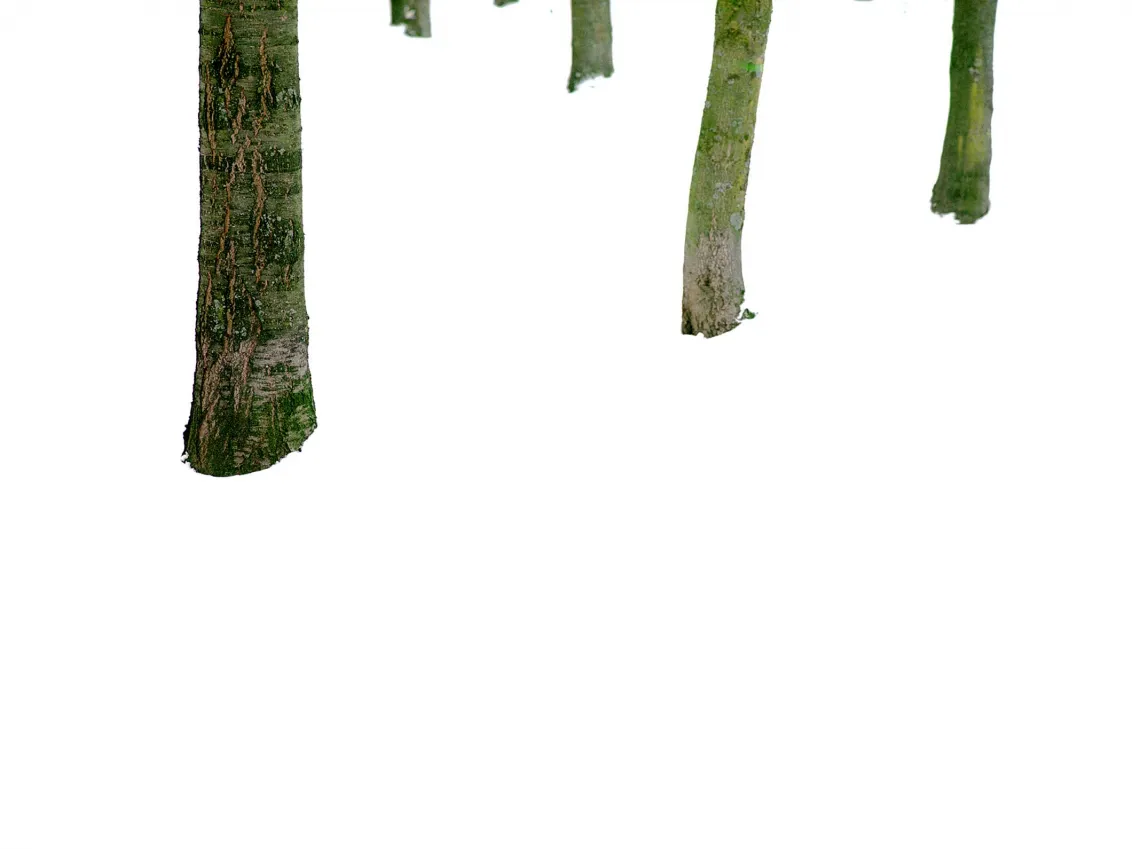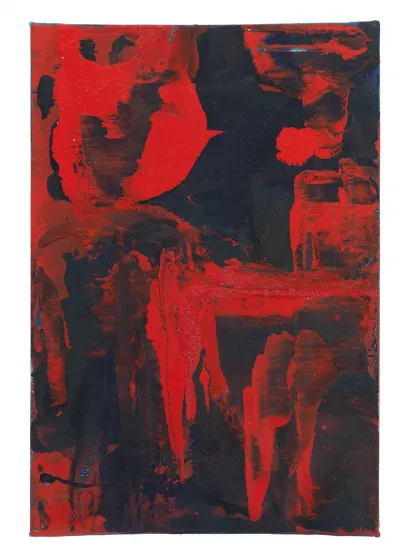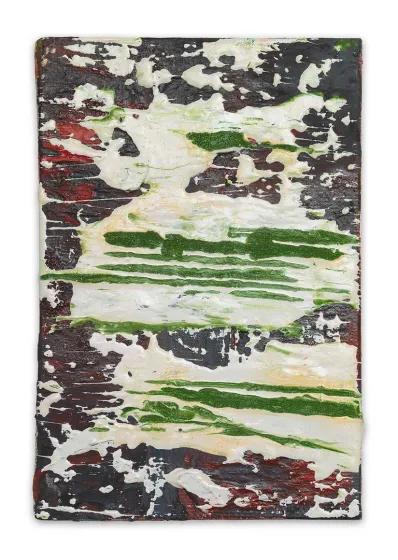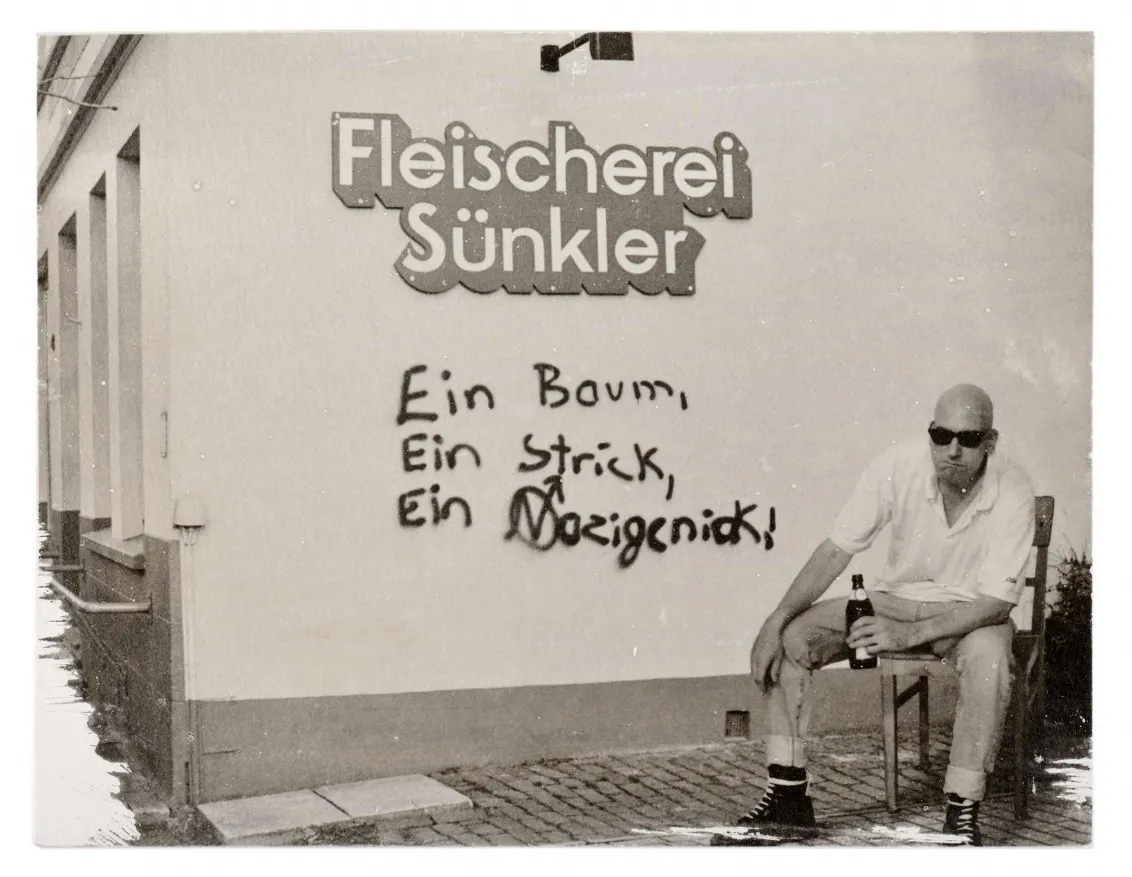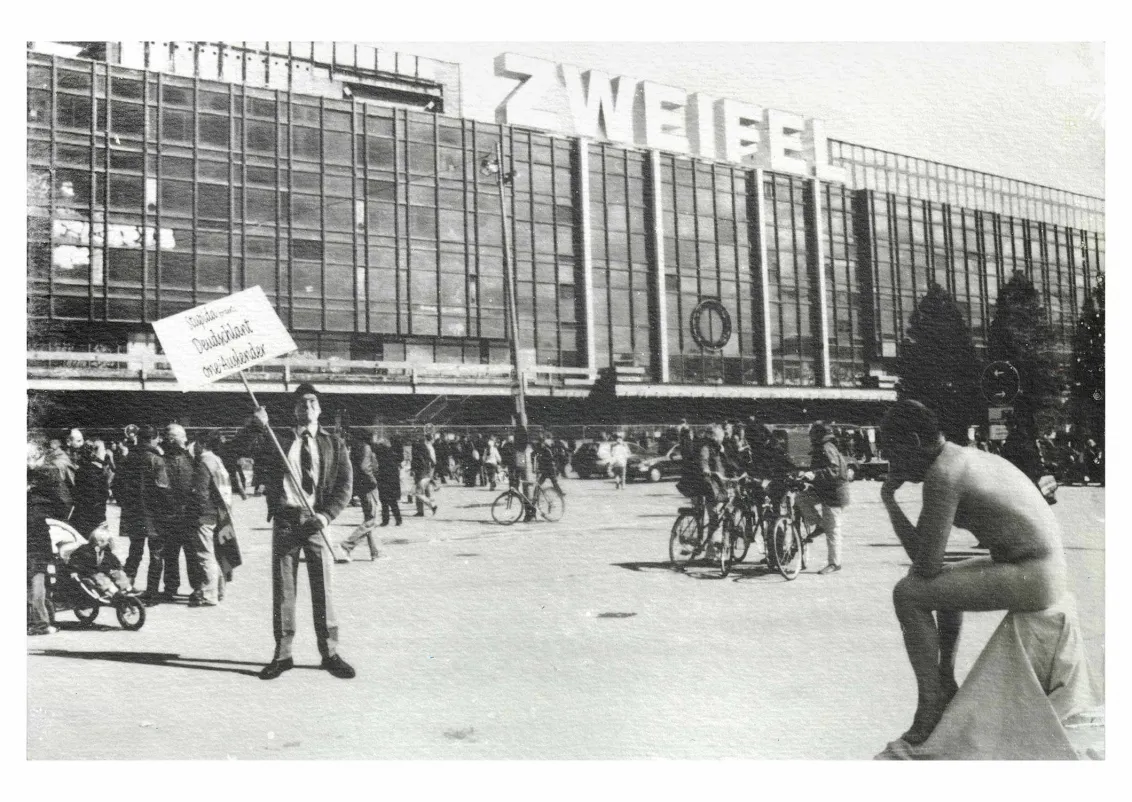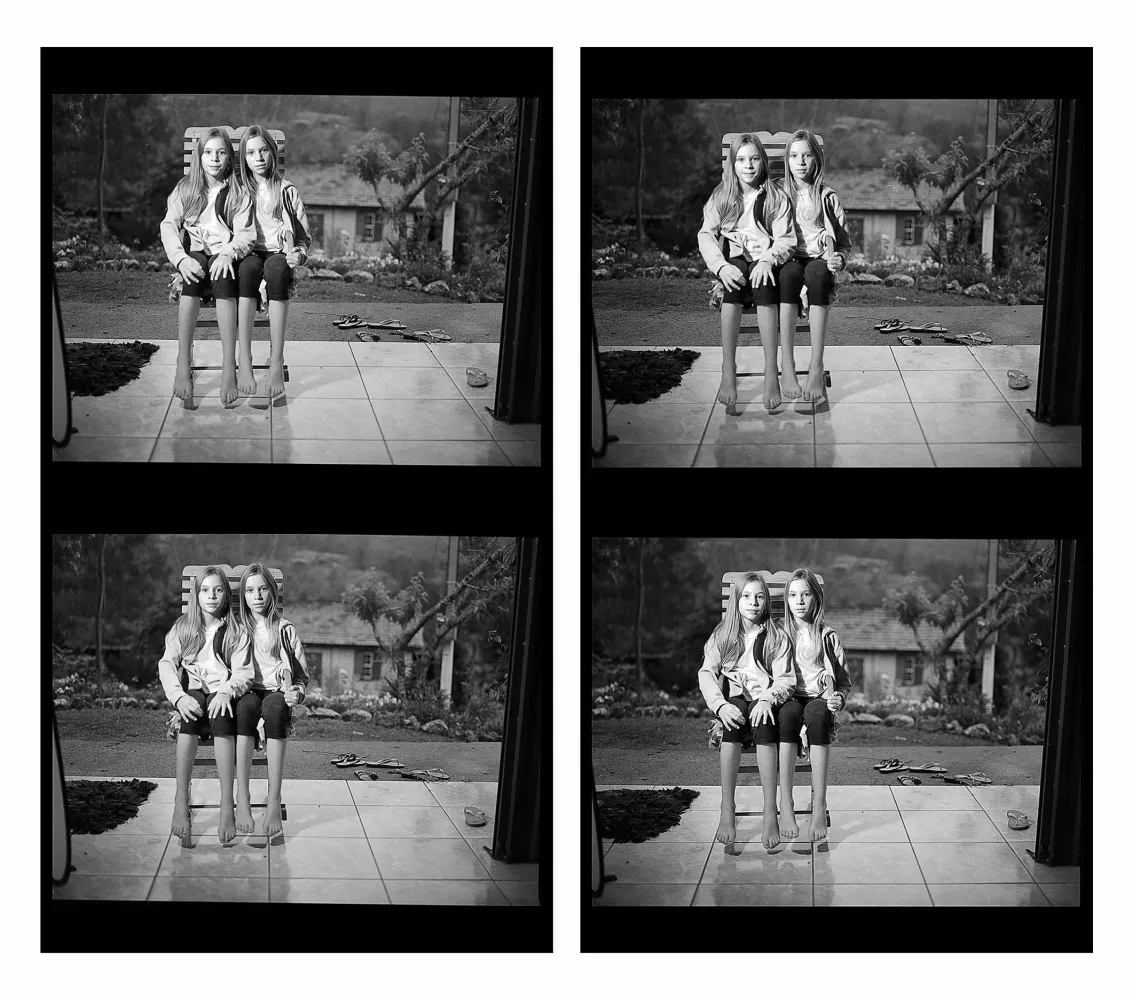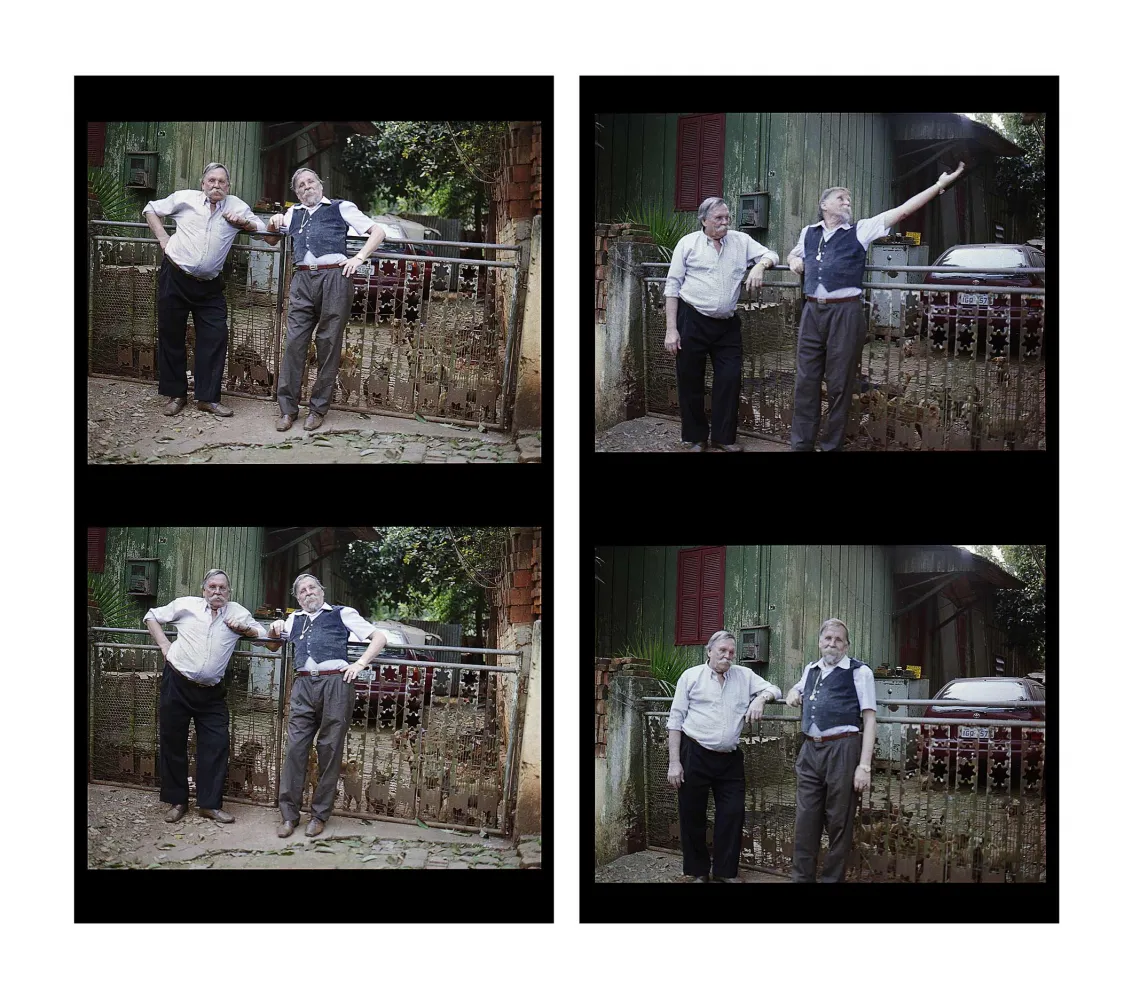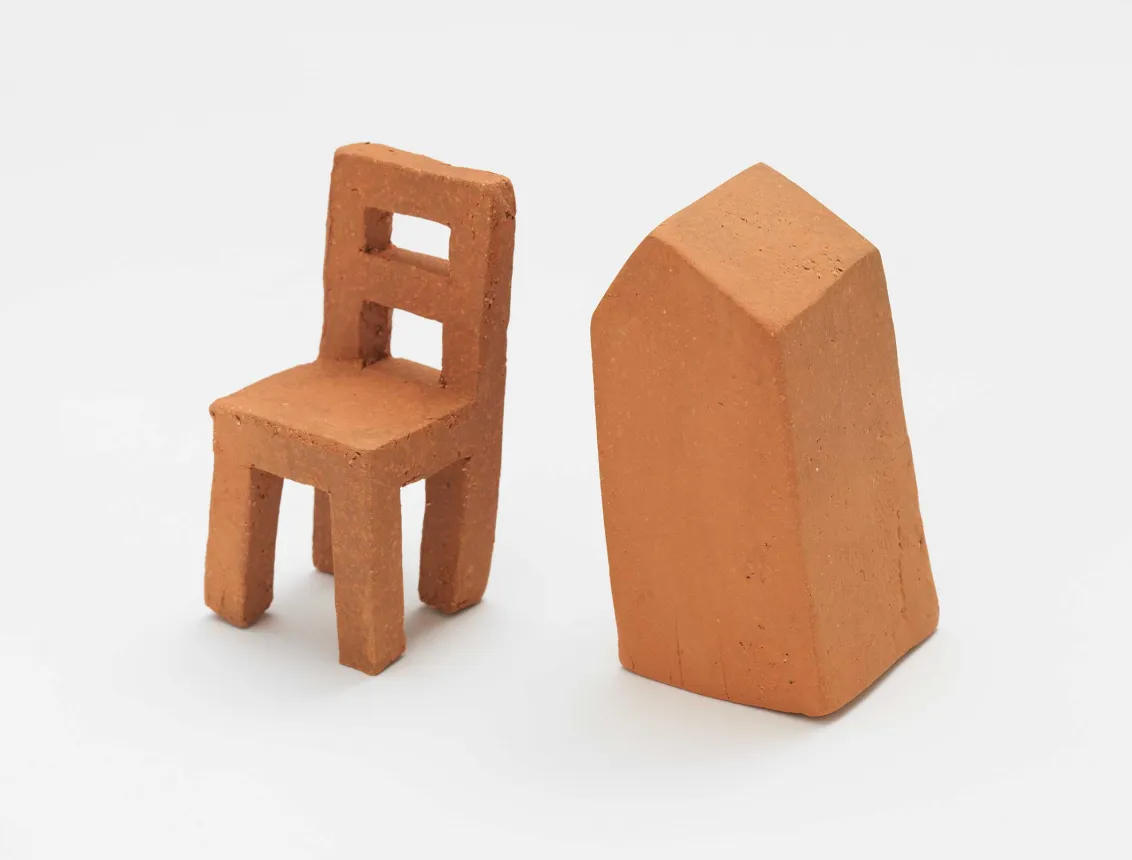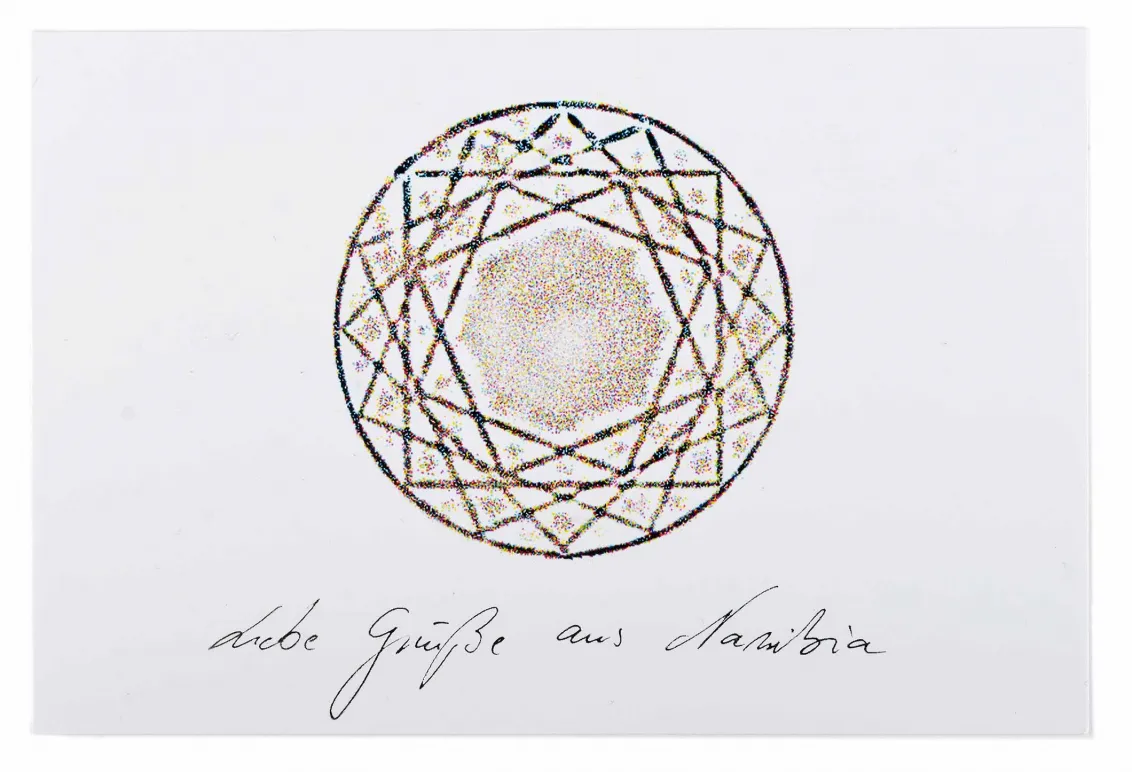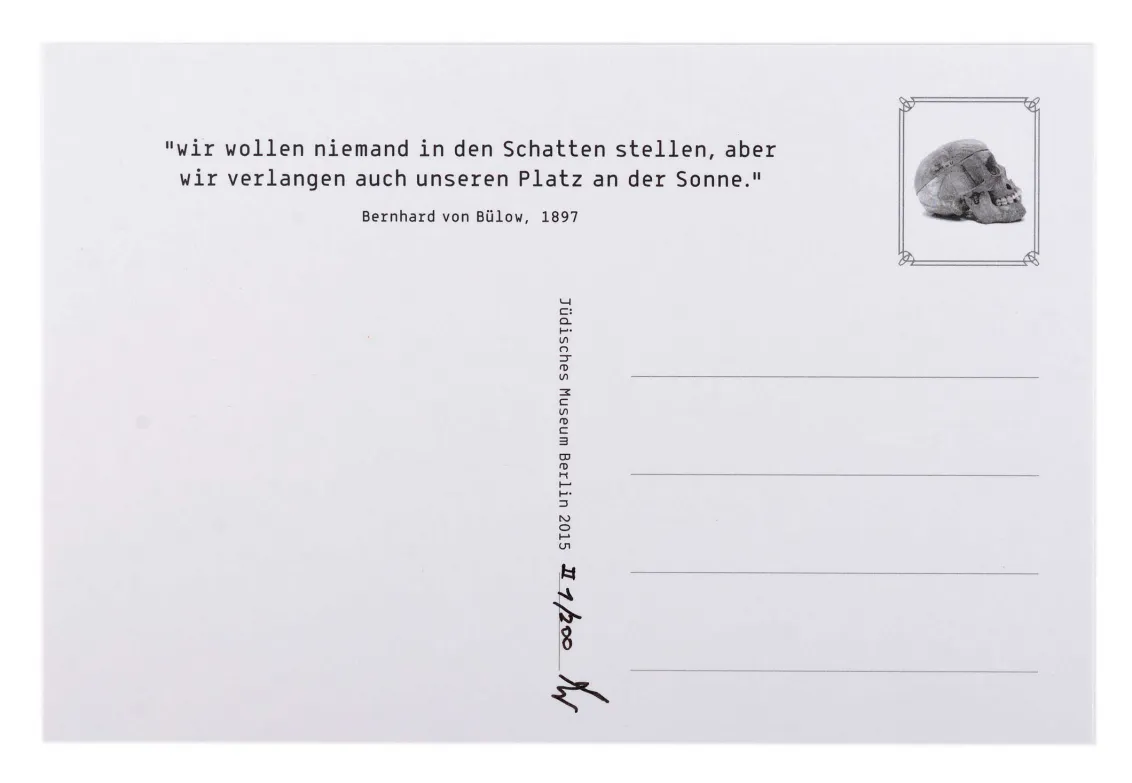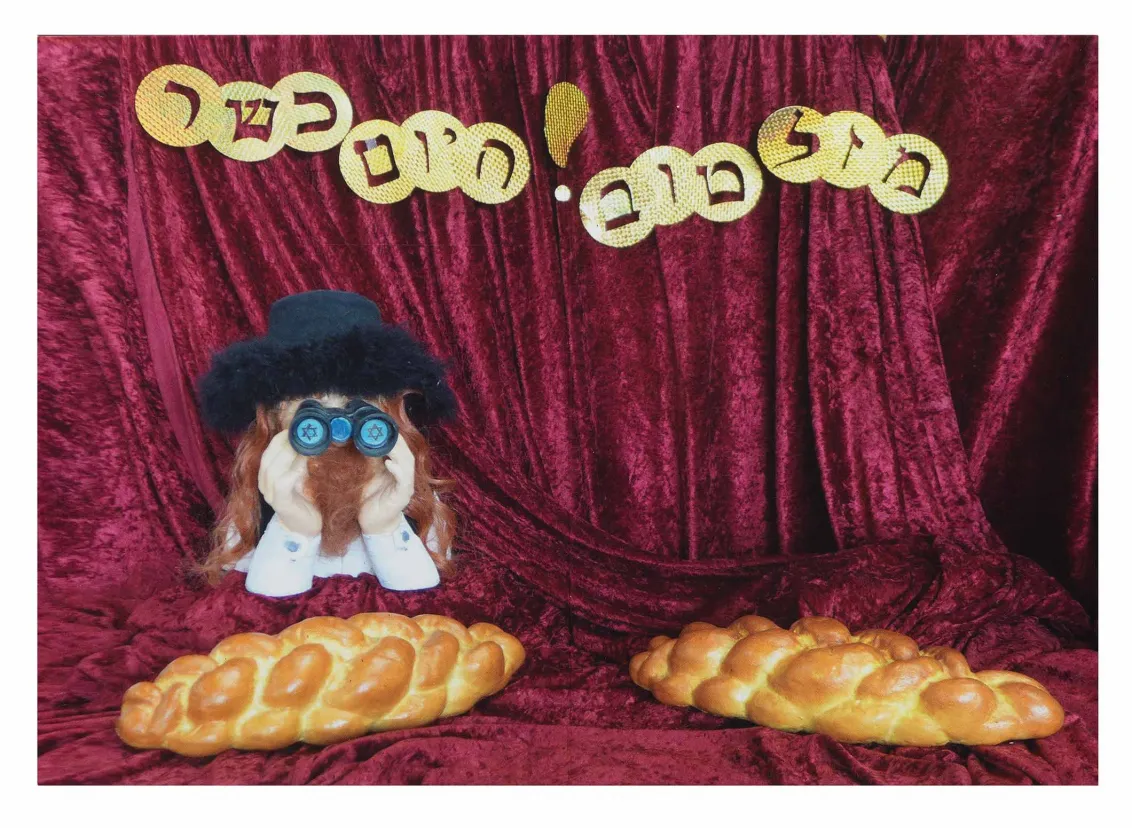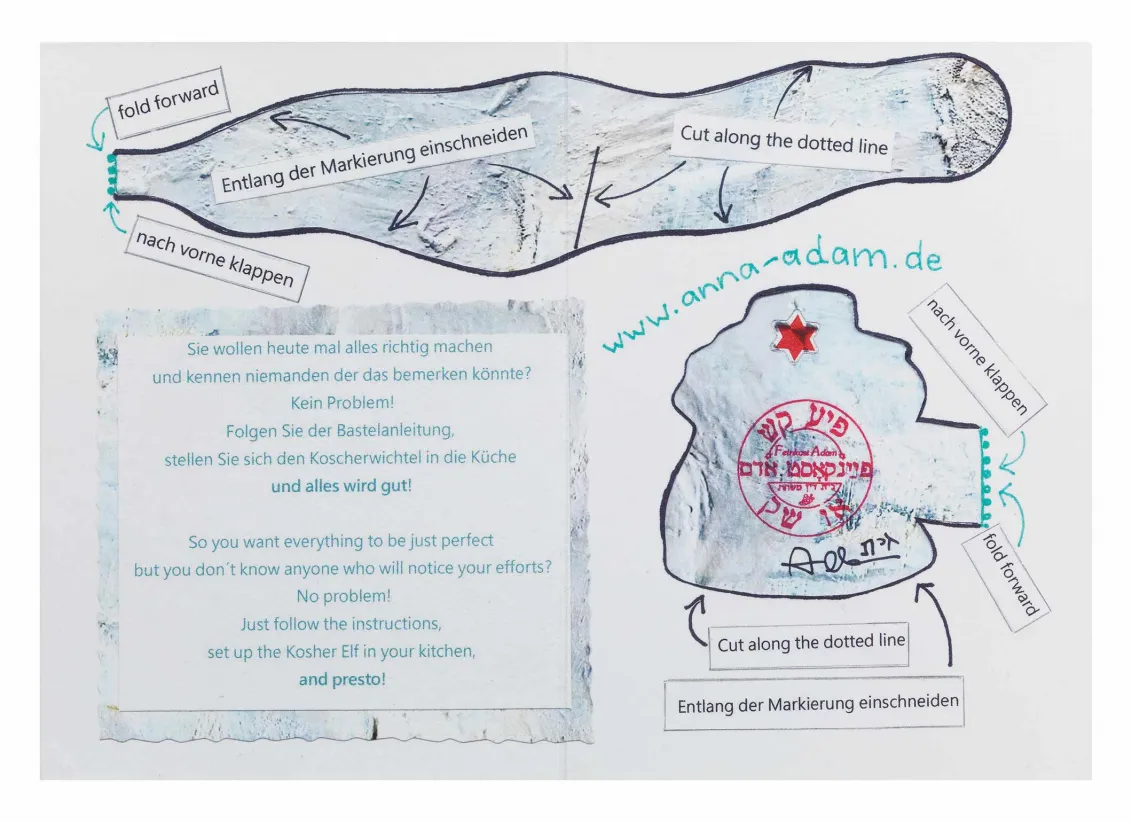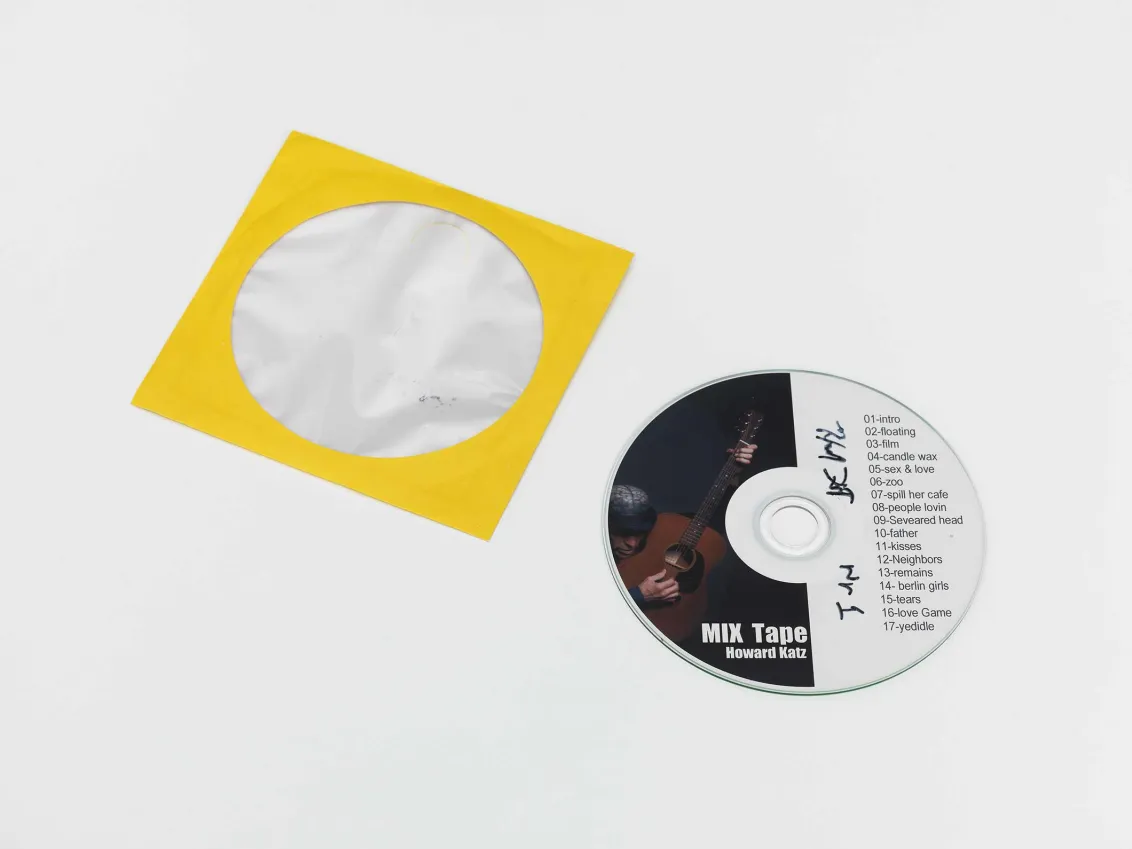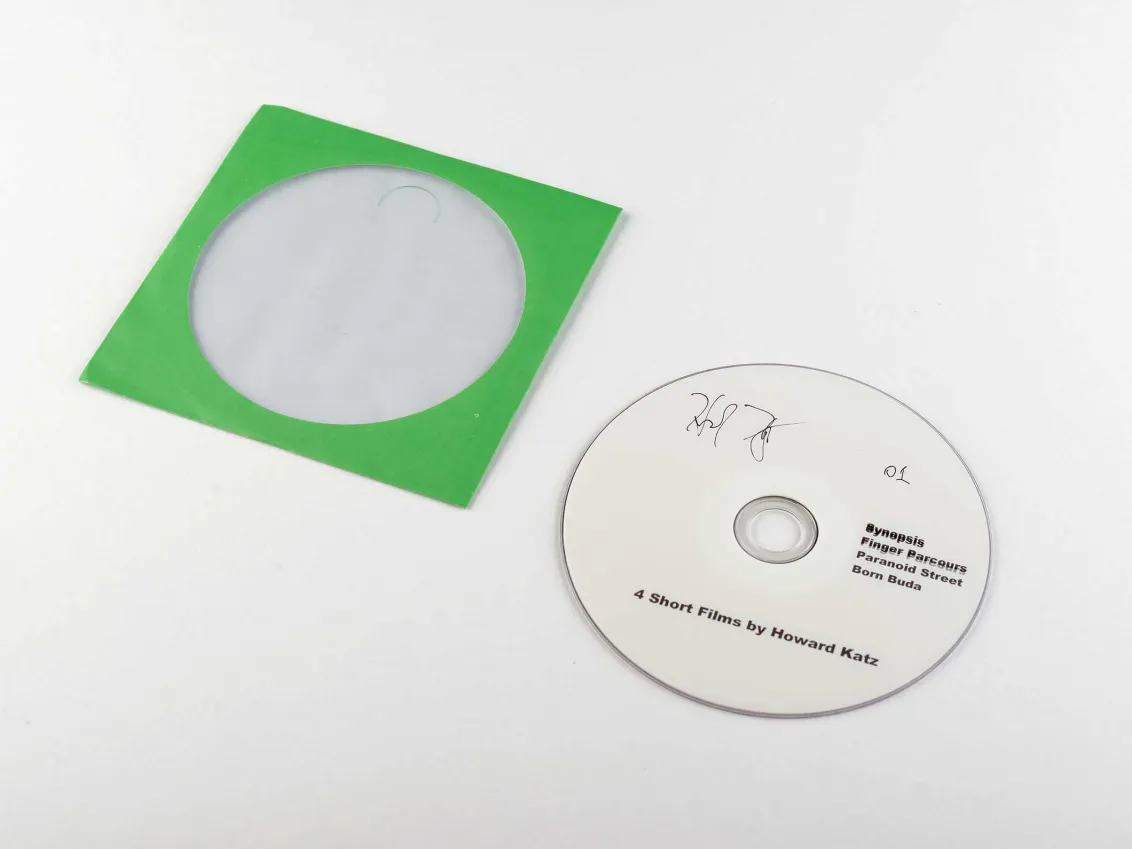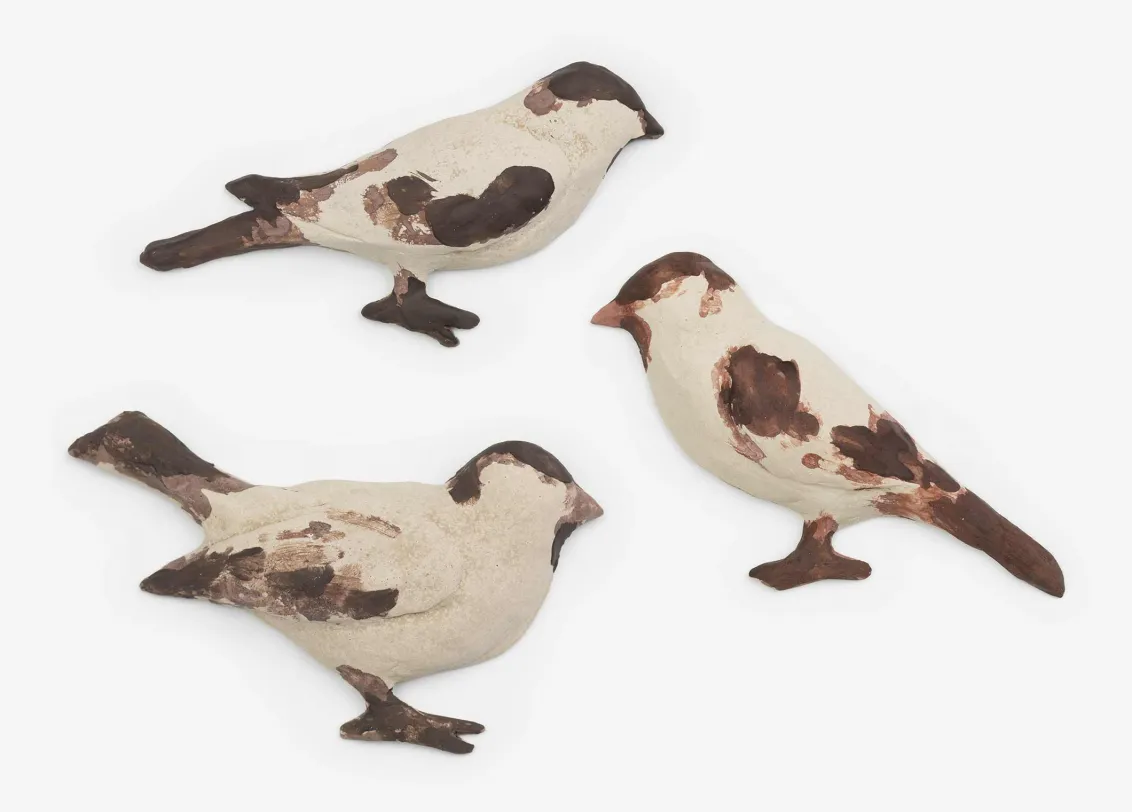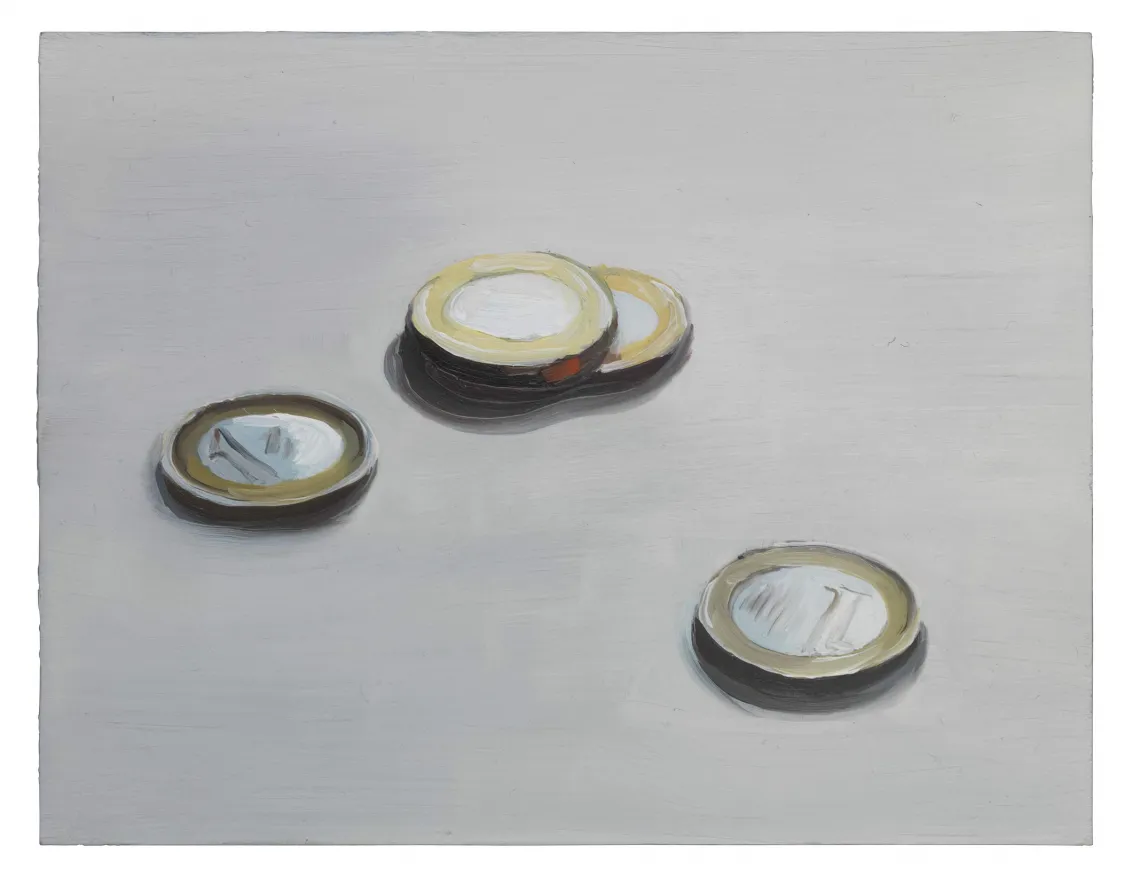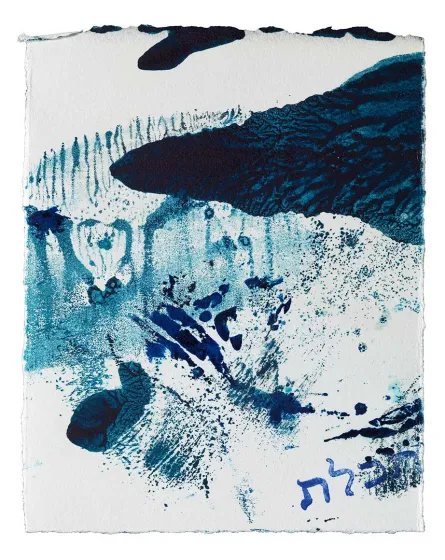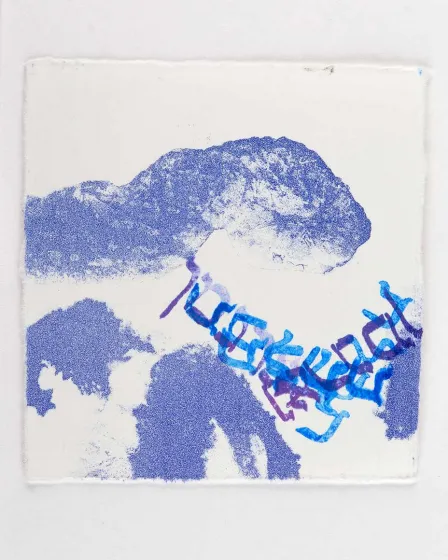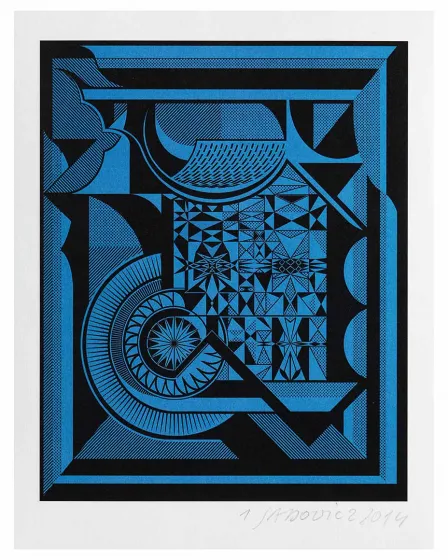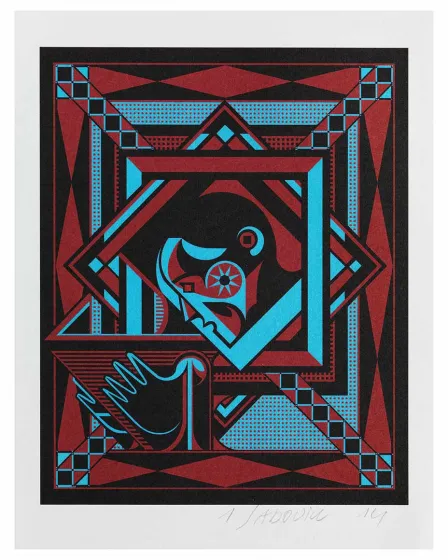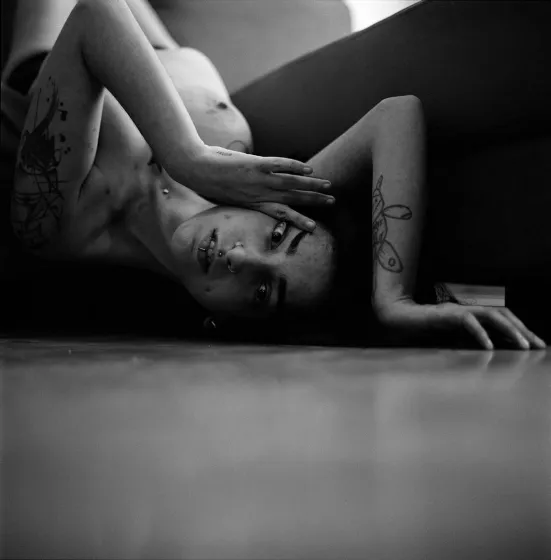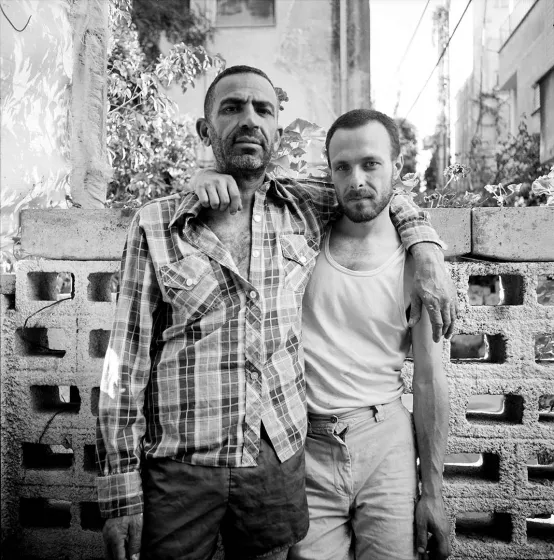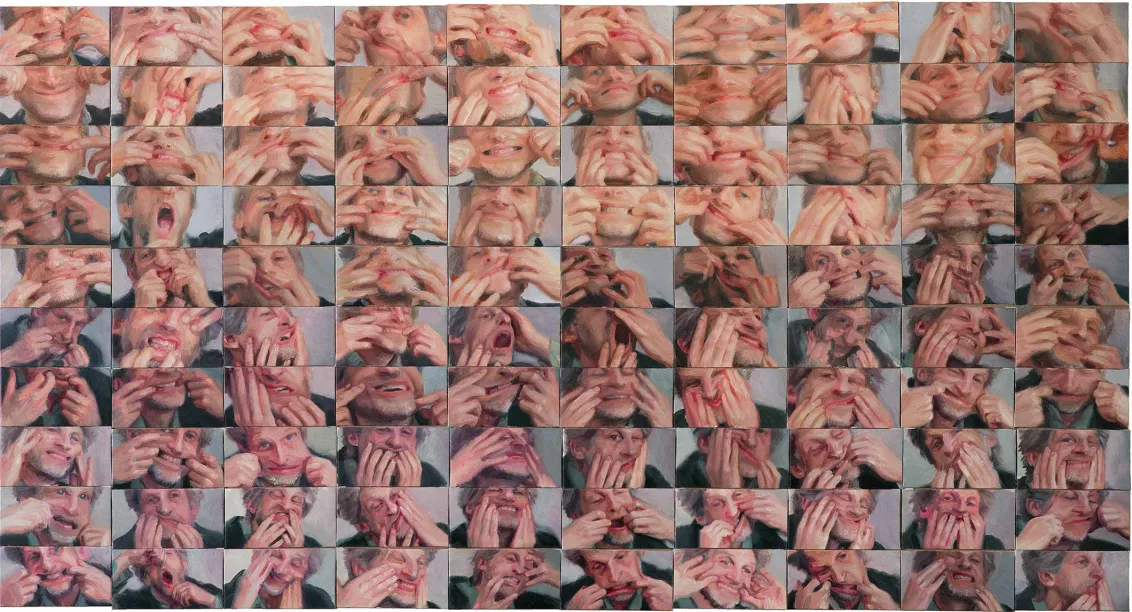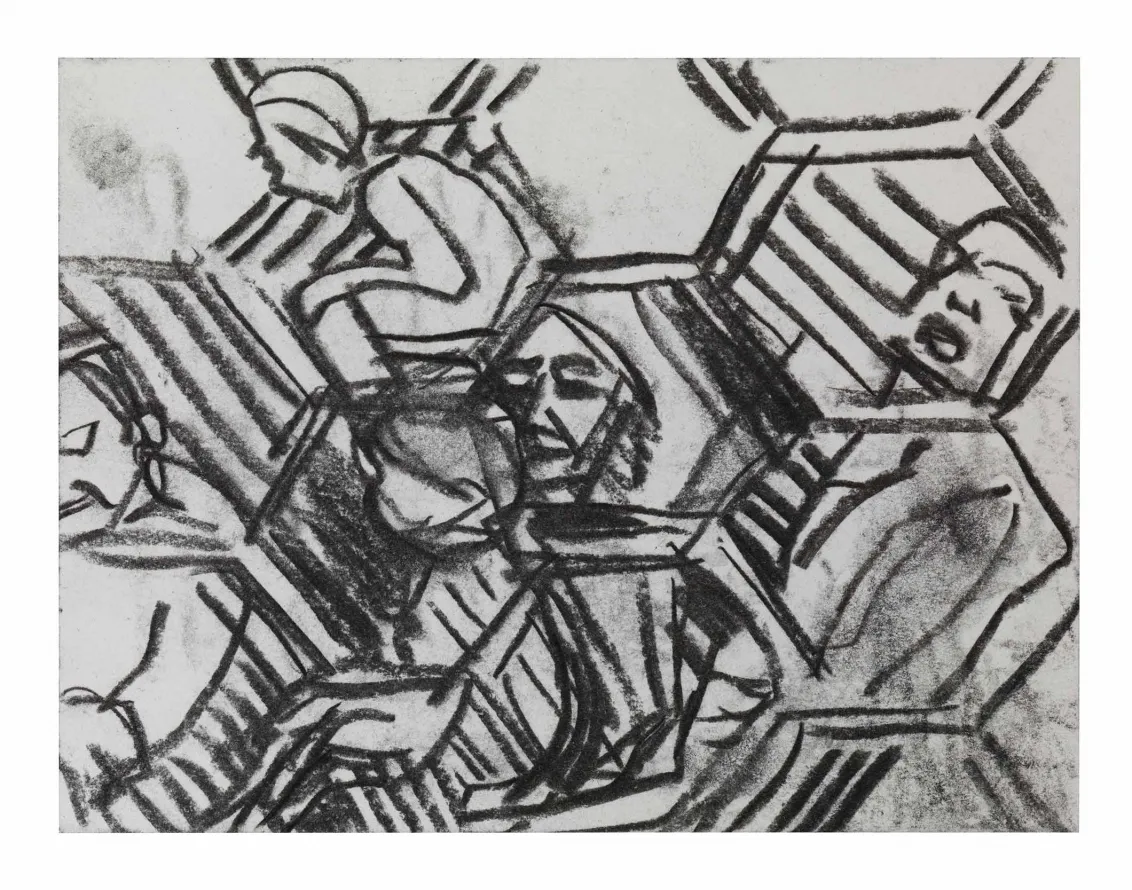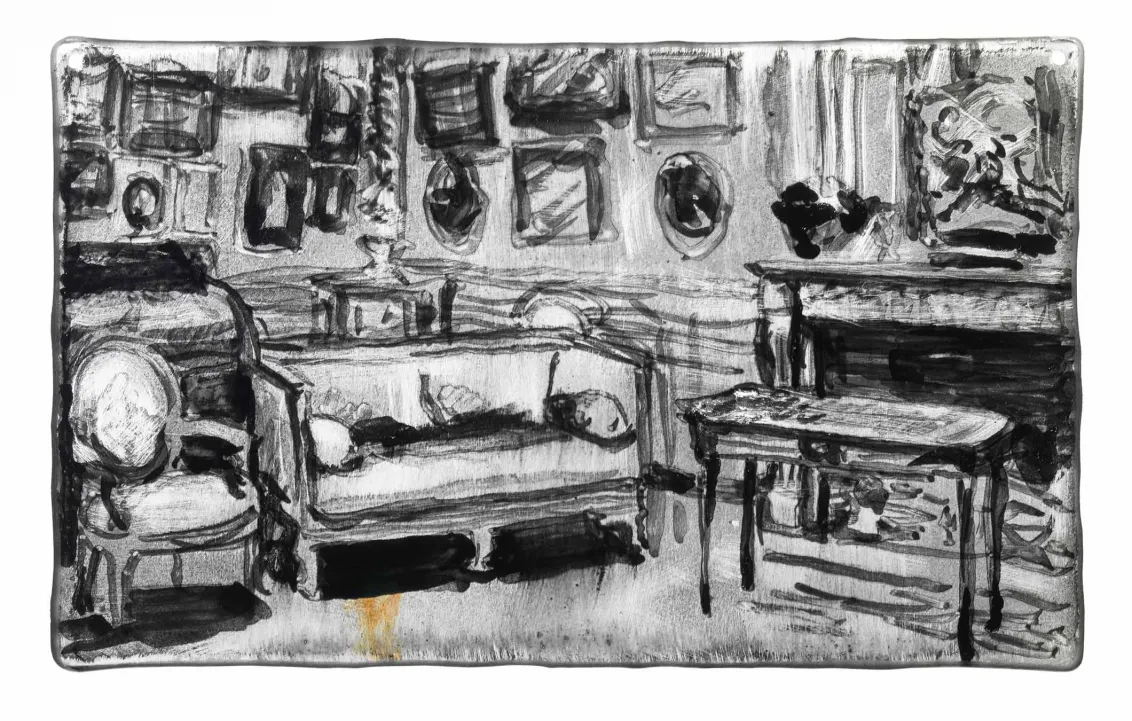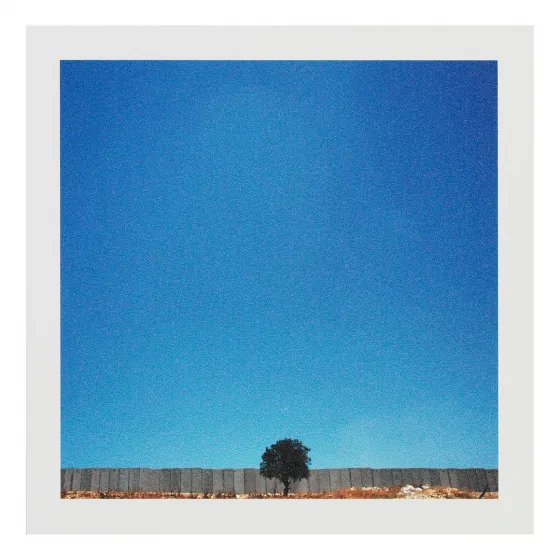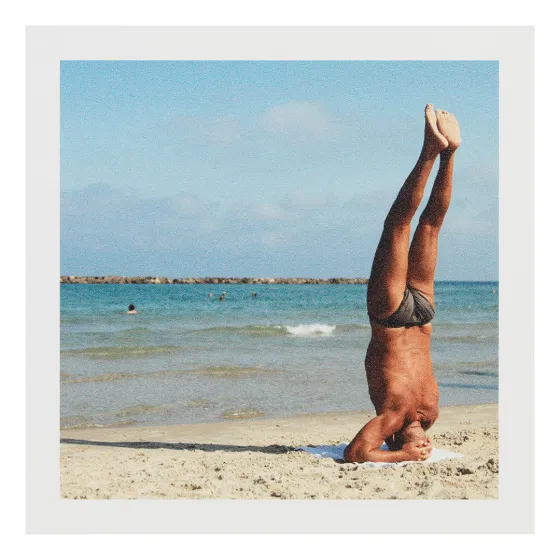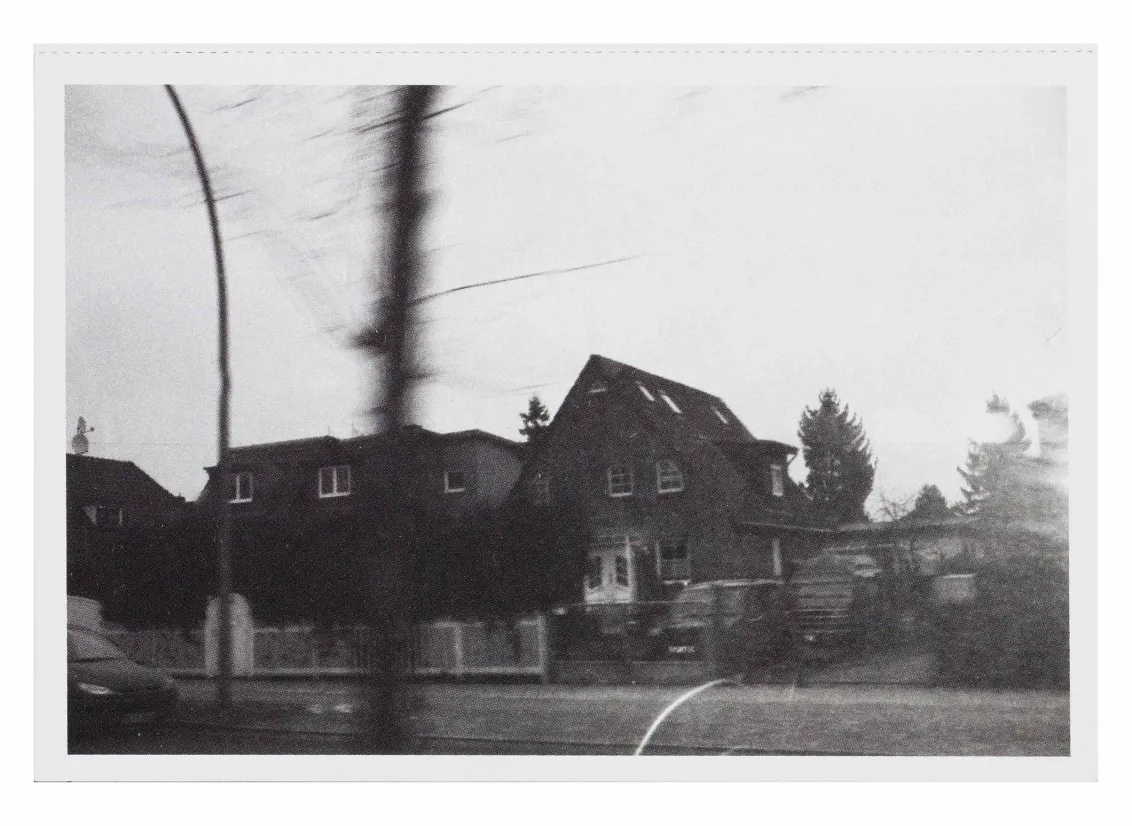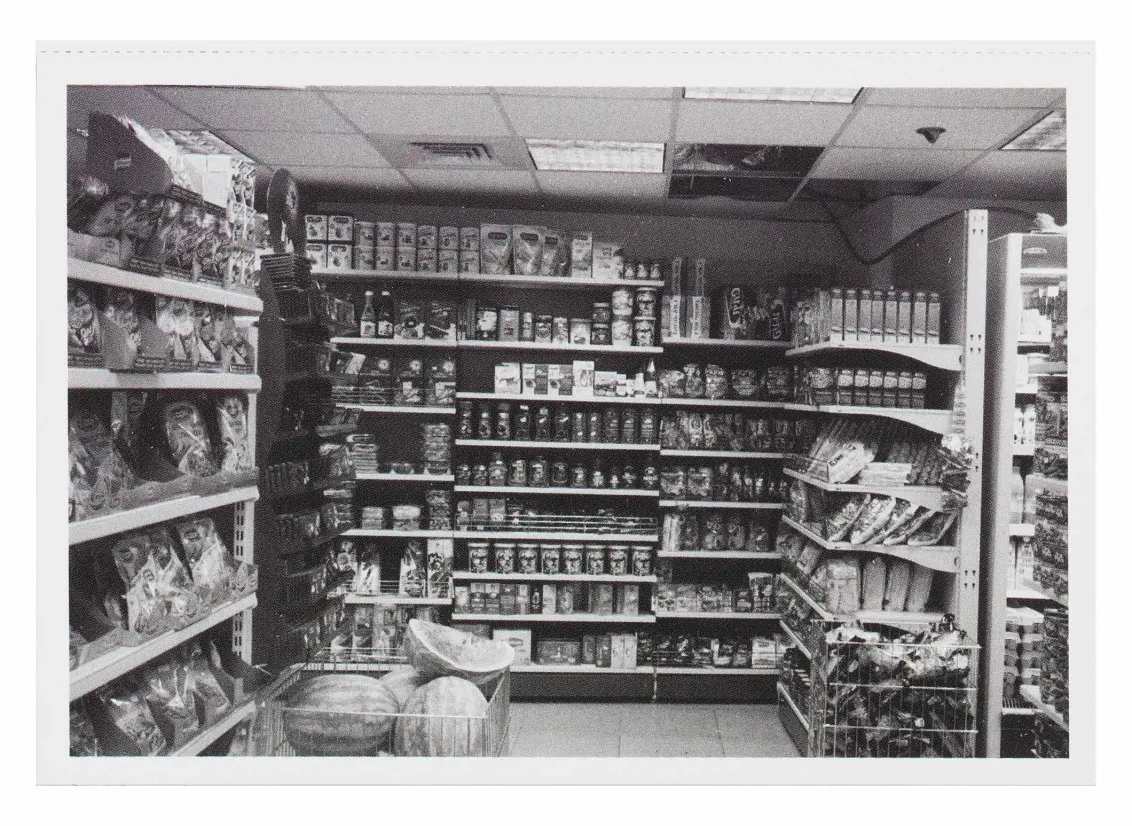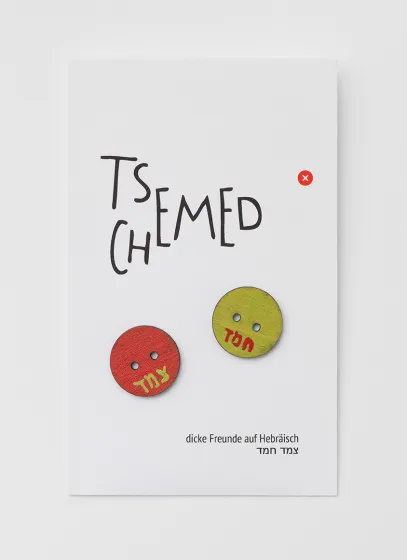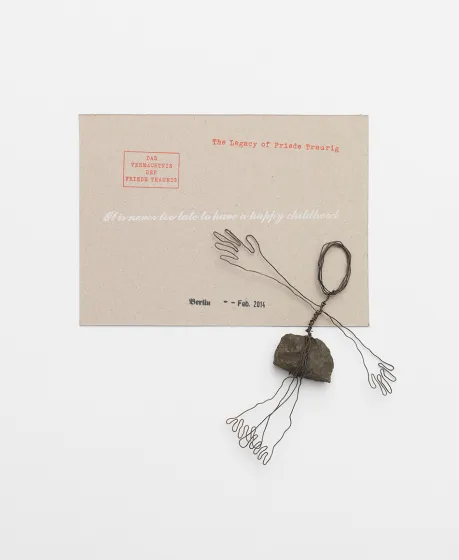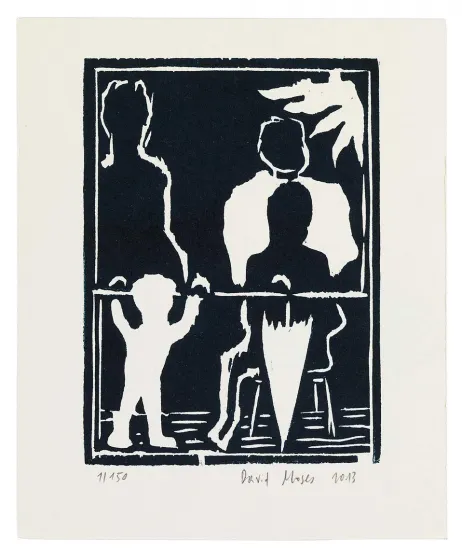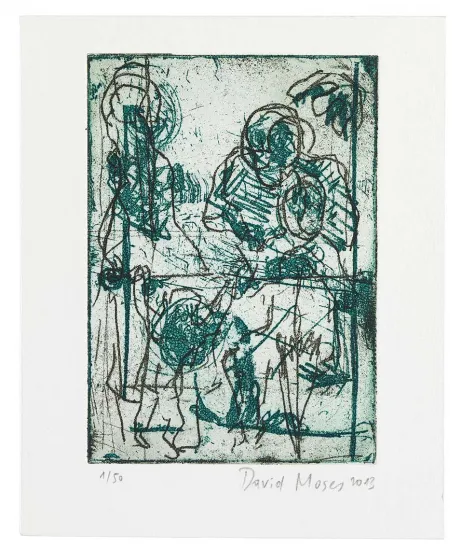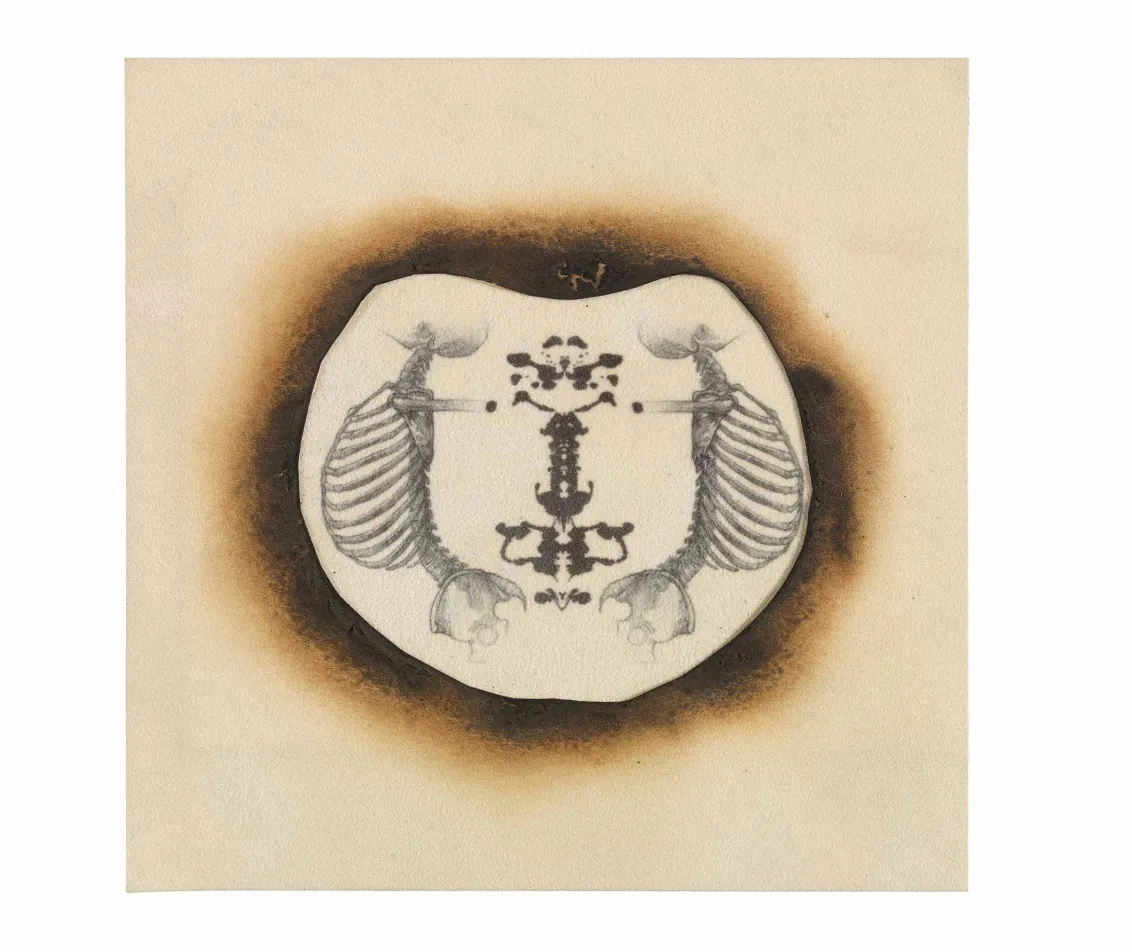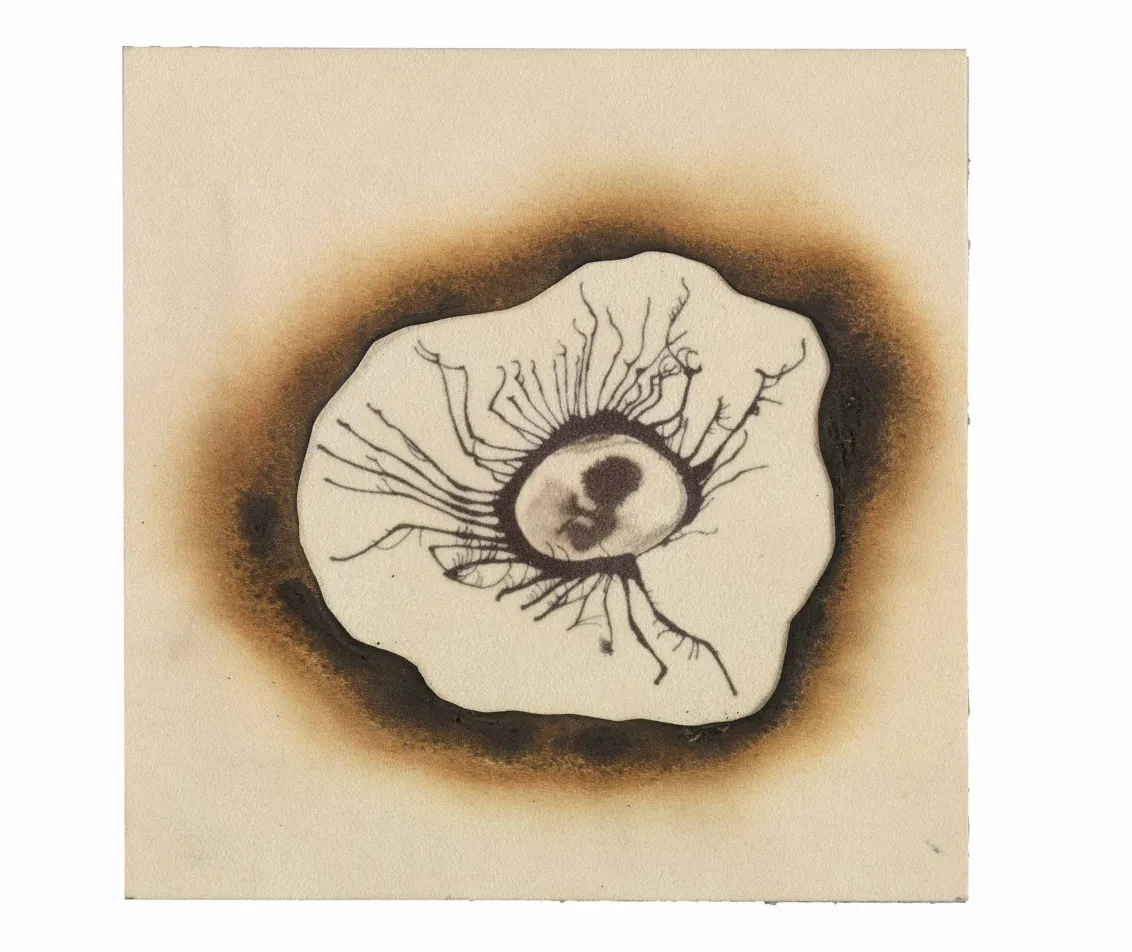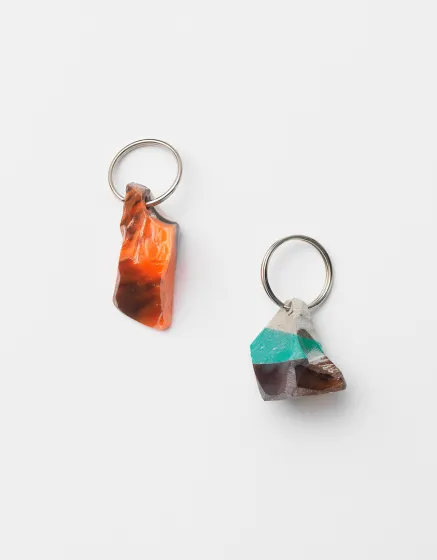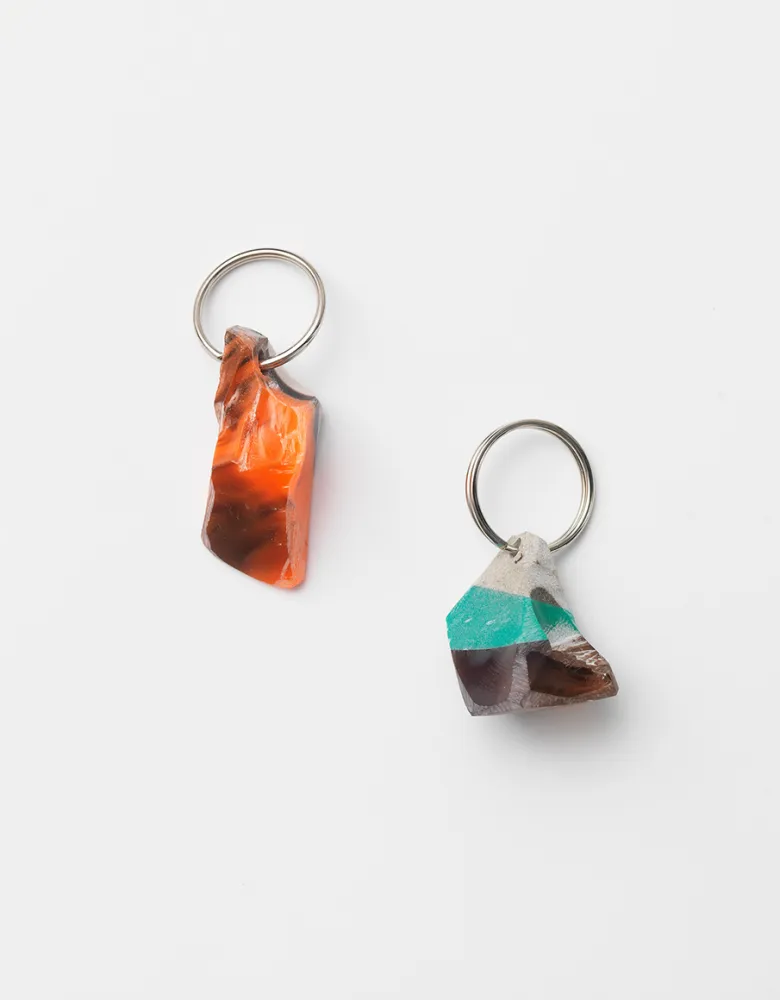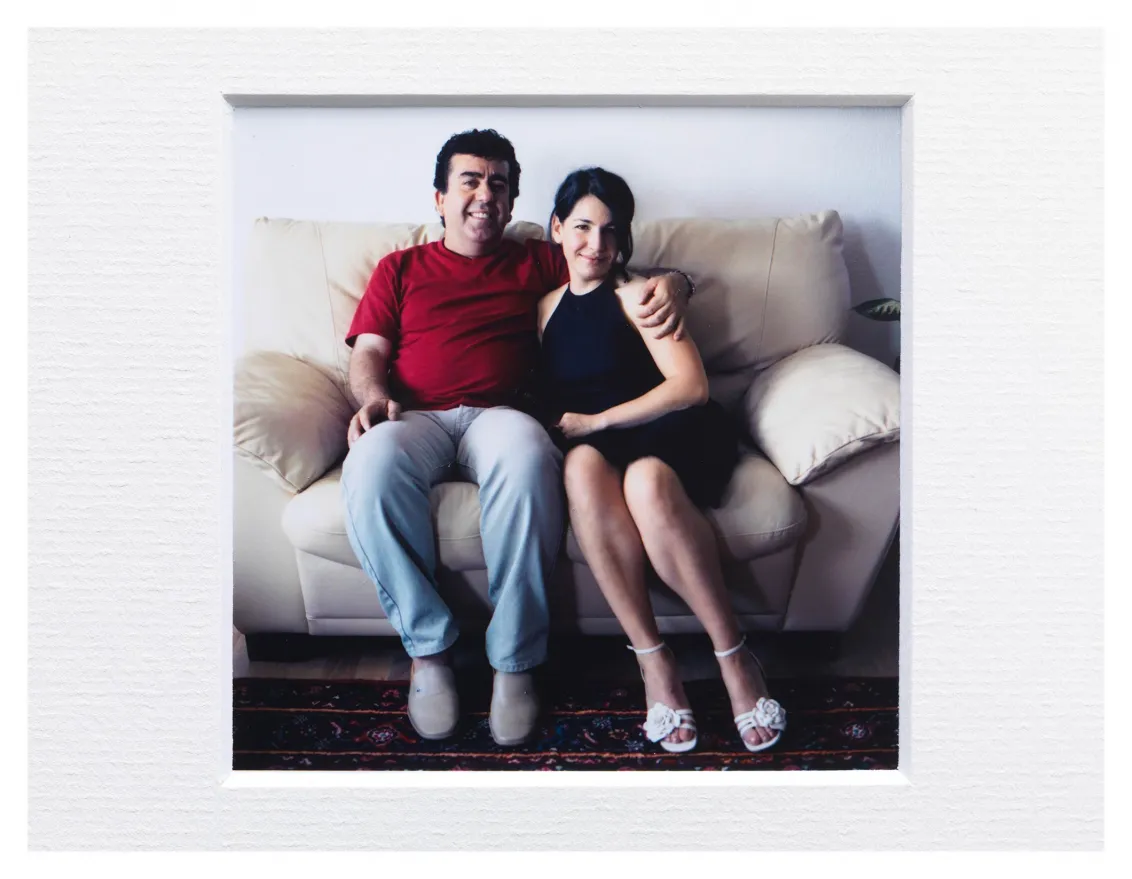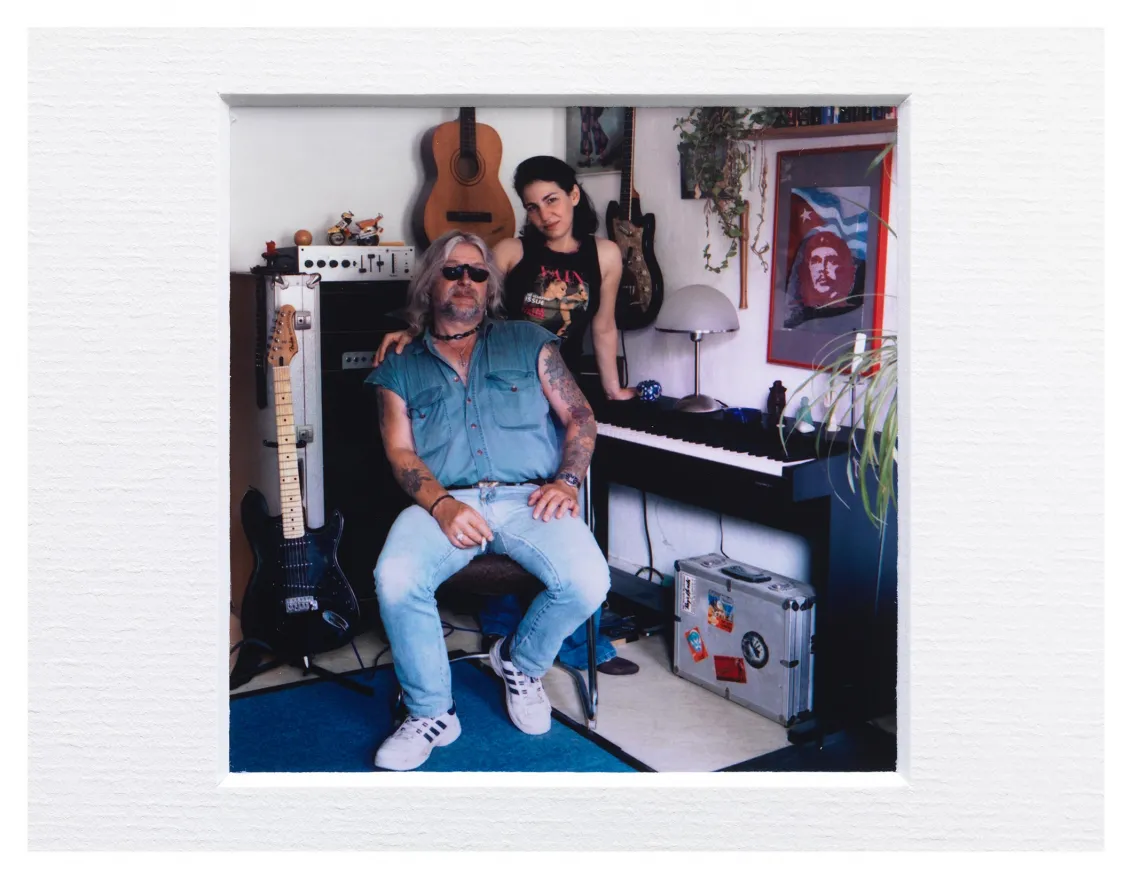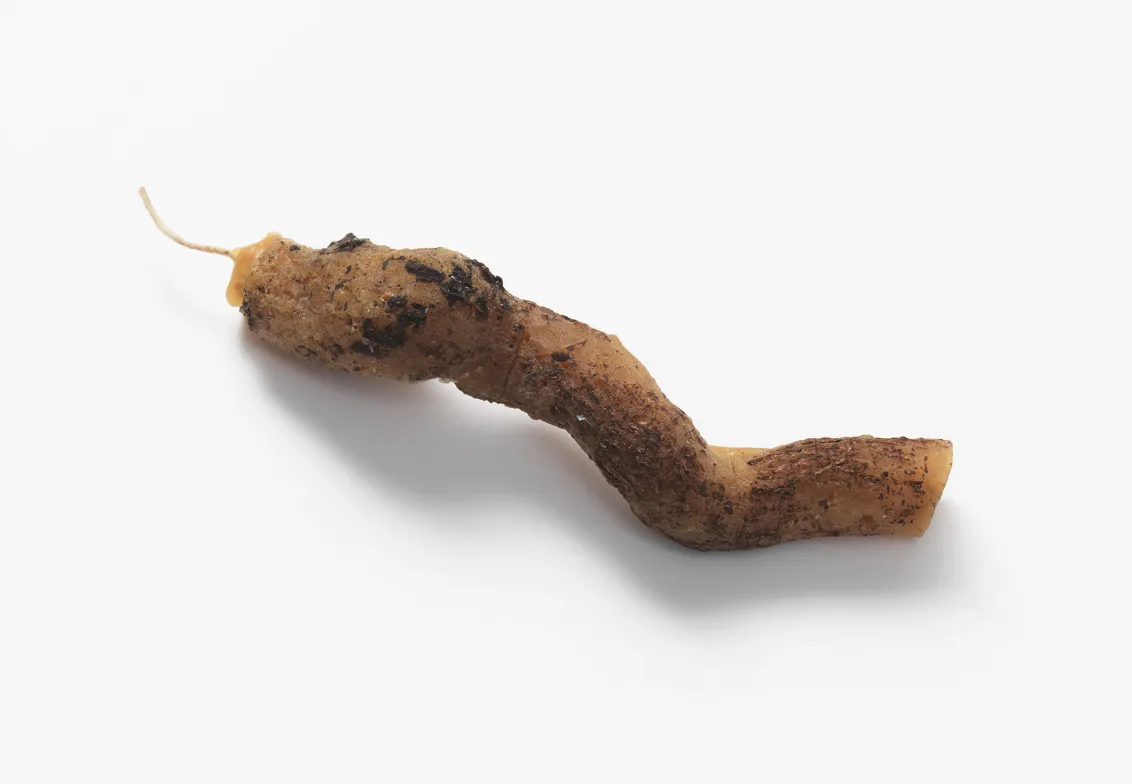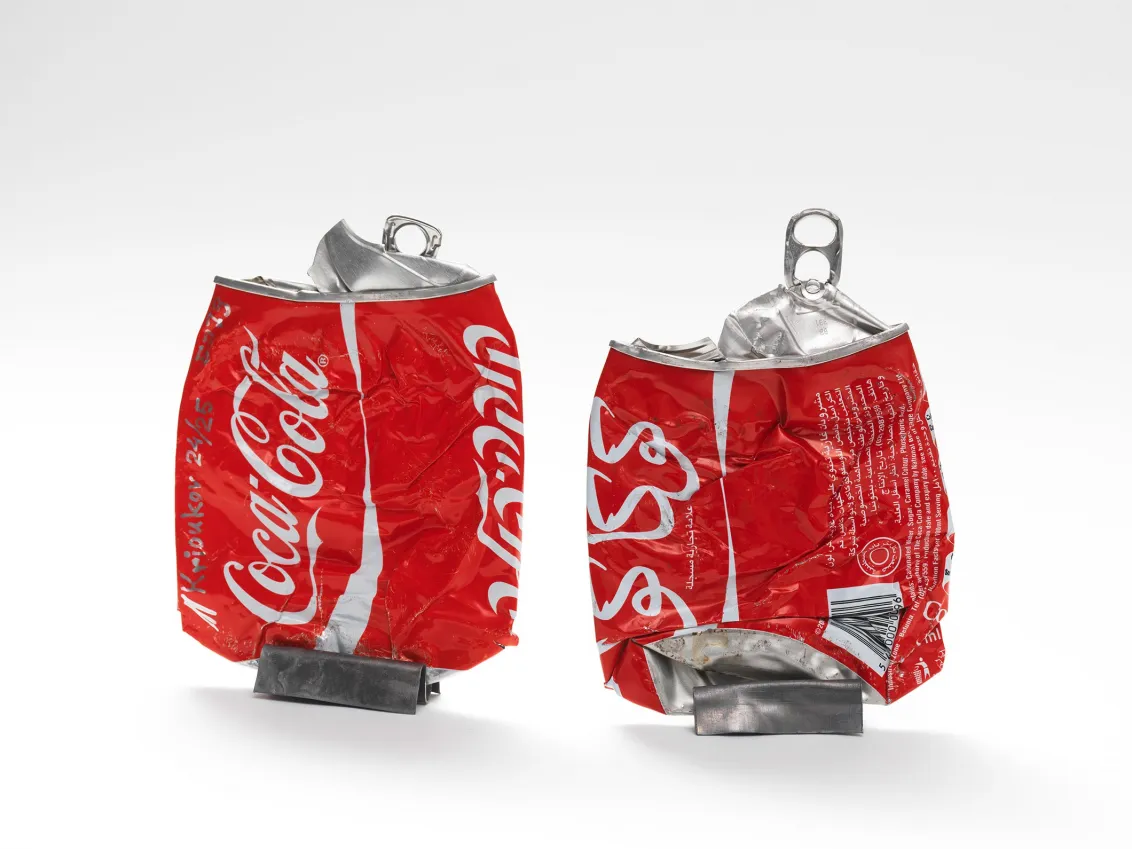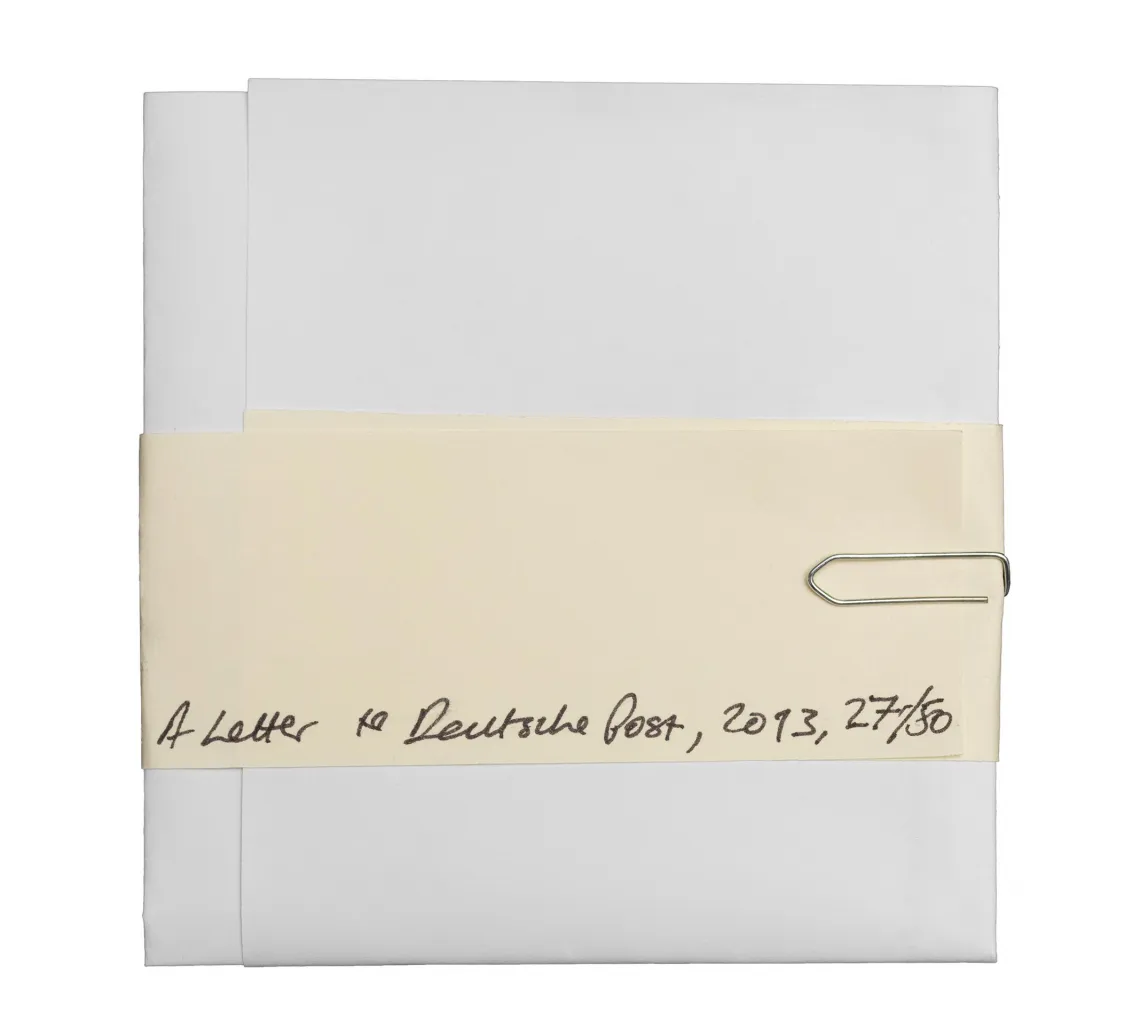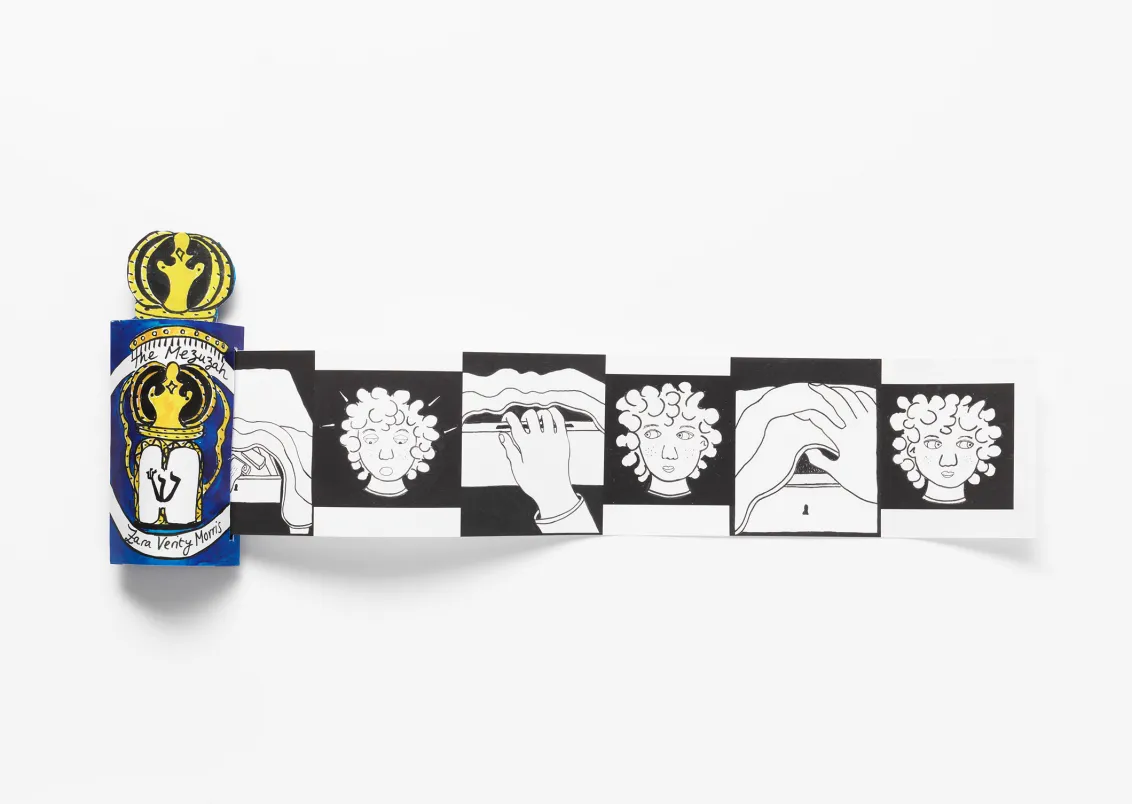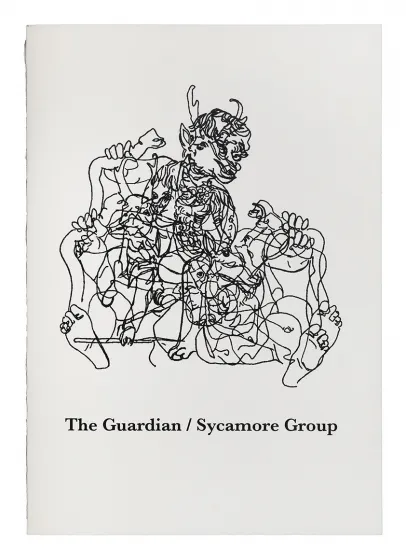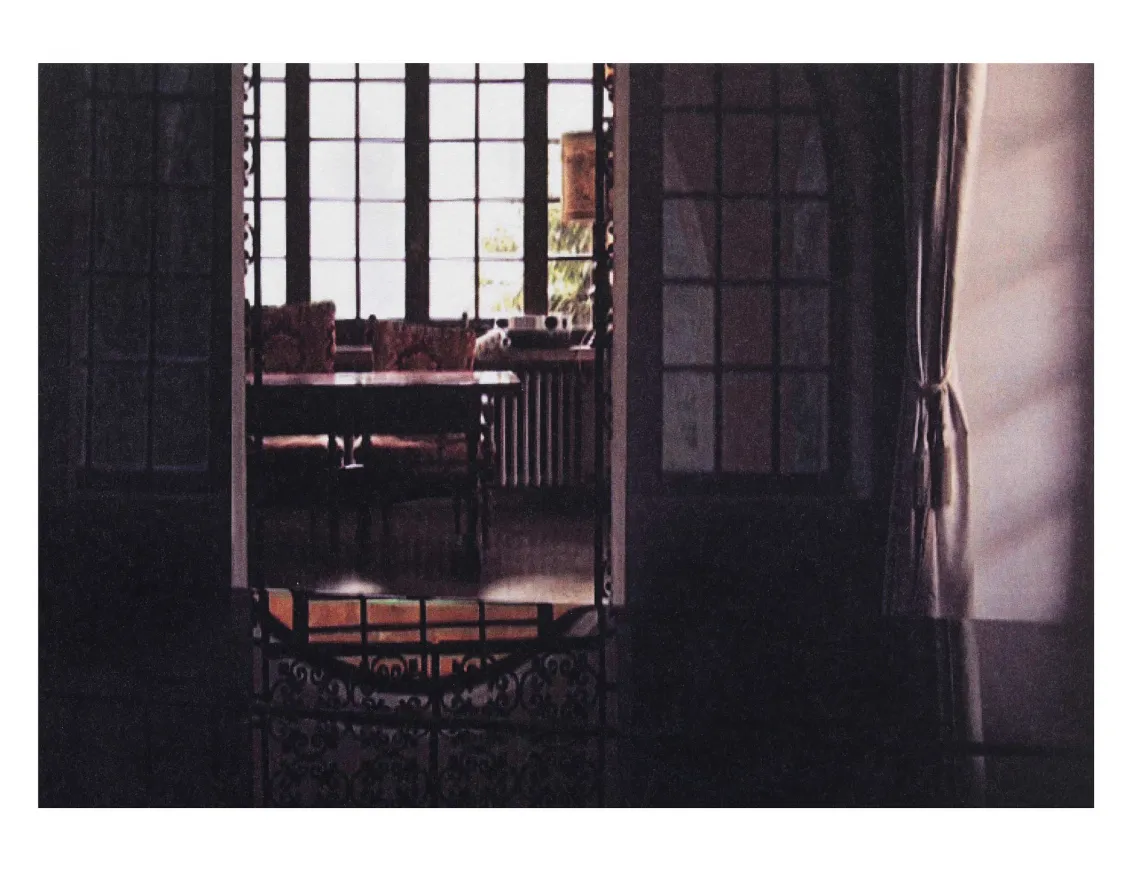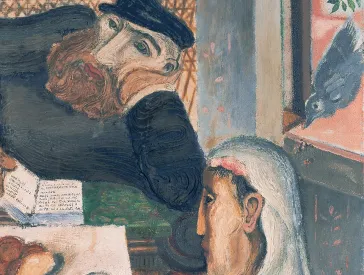
Art Vending Machine
2013–2018
High quality photo prints, printed textiles, and small sculptures – the art vending machine, at the Jewish Museum Berlin from August 2013 to June 2018, offered a wide range of surprising contemporary art hiding in its 30 compartments. The small-format unicums were created by international Jewish artists living in Berlin. All works of art were made exclusively for the art vending machine and are hand signed limited editions. Once they were sold, they were gone.
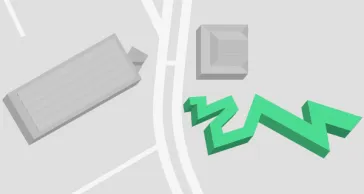
Where
Libeskind Building, ground level, Eric F. Ross Gallery
Lindenstraße 9–14, 10969 Berlin
Contemporary Art for 6 Euros
Visitors were able to draw a piece of contemporary art from the machine – a redesigned and rebuilt vending machine from the 1970s – for 6 €, payable in three two-€ coins.
Artists and Artworks
The following artists were involved in the project:
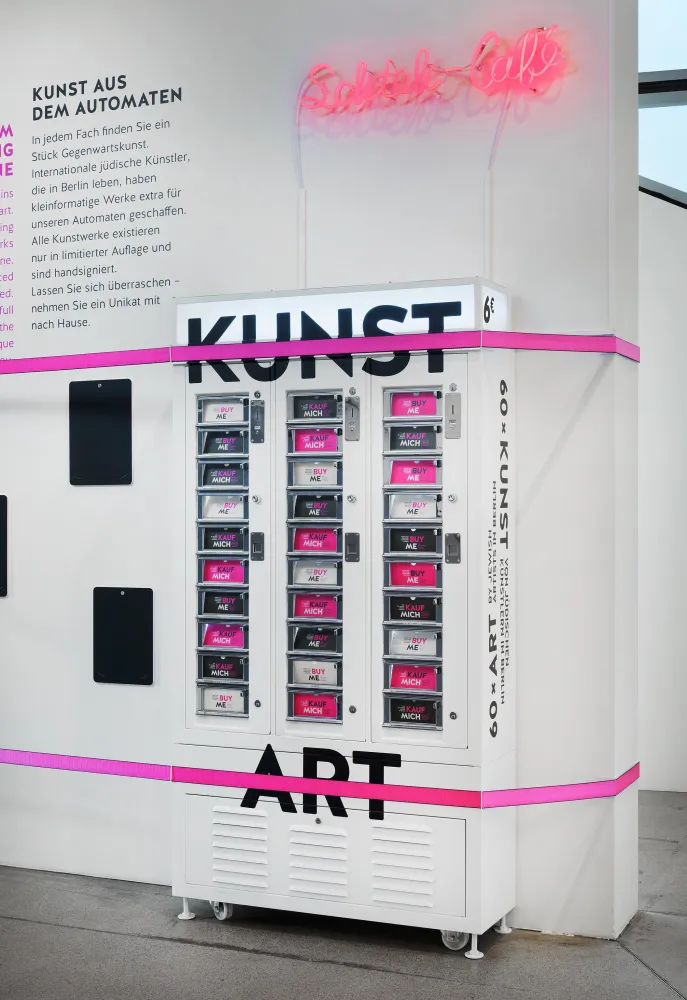 X
X
The art vending machine in the previous permanent exhibition; Jewish Museum Berlin, photo: Jens Ziehe
April–December 2016
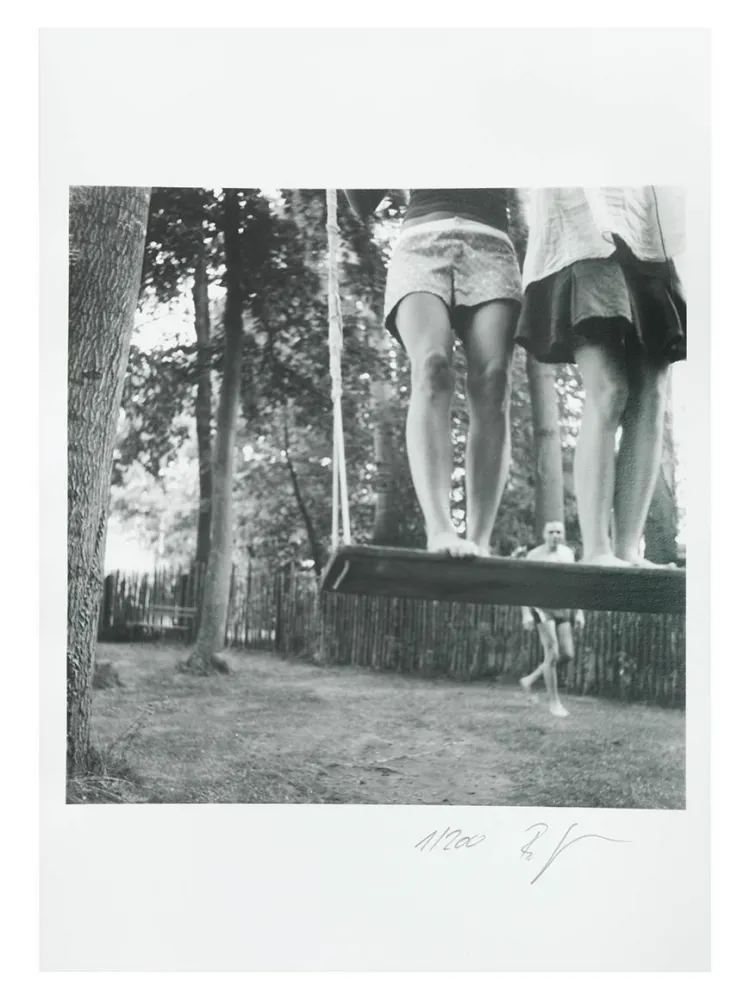
Birgit Naomi Glatzel (born in Kempten, Germany, 1970), Angela and Me, photo project You and Me; Jewish Museum Berlin,
Friends Sixteen Times Removed and a Camel on a World Tour
It’s a warm day of the summer 2016 when I visit Birgit Glatzel in Prenzlauer Berg, the same kind of day it must have been when she shot her photograph Angela and Me, which, like her short film Going to Jerusalem, was available in our art vending machine.
Angela and Birgit
Angela and Me is part of a series in which the artist portrays herself with a friend in self-timed pictures. All the photographs are taken with a 1937 Rolleiflex camera, and the location and backdrop are always chosen together with the friend in question. Birgit embarked upon the project shortly before her emigration to Israel in 2007 – she wanted to take photos to remember her friends in Germany. “Memories play an important role in Judaism, for example an original piece is always left in a newly refurbished apartment,
” explained the artist, who trained as an architect and works as such to earn her living.
Before I talk to Birgit about her art, she shows me the studio where she works and has lived with her son since her return to Berlin. I love the sliding walls that can hide the bathroom of the large studio apartment. Then Birgit tells me that Angela and Me shows her with her friend Angela, whose birthday they were celebrating at the Müggelsee in the summer of 2014. However, only the legs of the two women standing on a swing are shown, and upon closer inspection, a man in the background looking directly into the camera.
“Does it bother you that somebody just walked into your picture?
” I ask Birgit. No, he is part of the picture because he shows the elements of chance and of surprise that can result from the self-timer delay. “I knew the moment the photo was taken that it would turn out like this.
” “And how do you feel about your private souvenir photo hanging in other people’s homes?
” “I love this uncontrollable dispersal of my art. And since our faces are not visible, it is anonymous enough as well.
” There is already a waiting list for the photo series – other friends want to be part of the project.
Jerusalem in the Fridge
Birgit Glatzel also enjoys working with a partner on other projects because it inspires the best ideas. That was how it was with the art film Going to Jerusalem that she made with the animation filmmaker Benjamin Seide. It evolved ten years ago as a contribution for an exhibition in Jerusalem on the theme of “Land(e)scaping.” Benjamin and Birgit wanted to address the complex, five-thousand-year history of Jerusalem in an entertaining way, without ridiculing it.
The idea was sparked by a snow globe containing the Jerusalem skyline and a camel that Birgit had been given by a friend, Hagar from Israel – the two of them decided to “liberate” the city skyline from its ball and send it on a world tour accompanied by the camel. So they destroyed the snowball and used both as “leading actors” for her film. Filming locations included the icebox of Birgit’s fridge and the playground opposite her apartment. “Oddly enough, no one in Israel laughed at the film although it is so absurd – for example you see the camel hanging in a cable car over the Alps,
” wonders Birgit. “Your colleague Gelia Eisert was the first to find the film funny.
” “I also had a good laugh,
” I can reassure Birgit.
Since there was only one more public showing of the film in Jerusalem after the exhibition, Birgit has ensured its survival by putting it on a USB stick for our art vending machine. The stick was stuck on a postcard showing the camel in the cable car and the card is lovingly hand-stamped with camel heads designed by Benjamin Seide and Birgit Glatzel. “Working with Benjamin was great fun,
” laughs Birgit. “It was a charming and very special collaboration during the film production and, many years later, designing the card. Unfortunately, this was our only joint project so far.
”
A Friend is a Friend of a Friend
Still of particular importance to Birgit Glatzel is her first major long-term project, which again unites the two motifs from the other works of art – friendship and travel. This was the first project she used the Rolleiflex for – her camera for special occasions, as one photo costs about 2 euros, so you think twice before pressing the shutter. For A Friend is a Friend of a Friend, Birgit sent herself off traveling for four years and visited first friends around the world, then friends of those friends and so on – a total of 340 people, some of whom were friends 16 times removed. “I wanted to show that it’s possible to do it differently and that the Internet does not replace personal experience.
”
Birgit Glatzel took a picture with her Rolleiflex of all the friends and friends of friends she met and with whom she sometimes stayed. The camera was always a good place to start at a first meeting with what were mostly strangers – “It is is an element that we all know and at the same time you can take photos inconspicuously with it, so it is not so intimidating.
” The Rolleiflex was a chance discovery – “I had always wanted a camera like that and came across it when I was looking for a flash for a different camera.
” The photo project led to an exhibition and many years later to a book that Birgit Glatzel financed through a several-month crowdfunding campaign. It shows very many very different people from all around the world in their private environments. The appendix has a list of everyone depicted, listed by place of residence, occupation, or “friendship clan,” to quote Birgit.
Birgit invites me to look through the Rolleiflex at the end. “You see everything back to front,
” says Birgit “but I don’t even notice that anymore.
” She also gives me a signed copy of A Friend is a Friend of a Friend, number 184 of 300, as a reminder of our afternoon together at her studio, which has flown by. The book now has its place on my desk and reminds me that you should send yourself off traveling more often or visit friends or people who you don’t know (yet).
Mariette Franz, Digital & Publishing
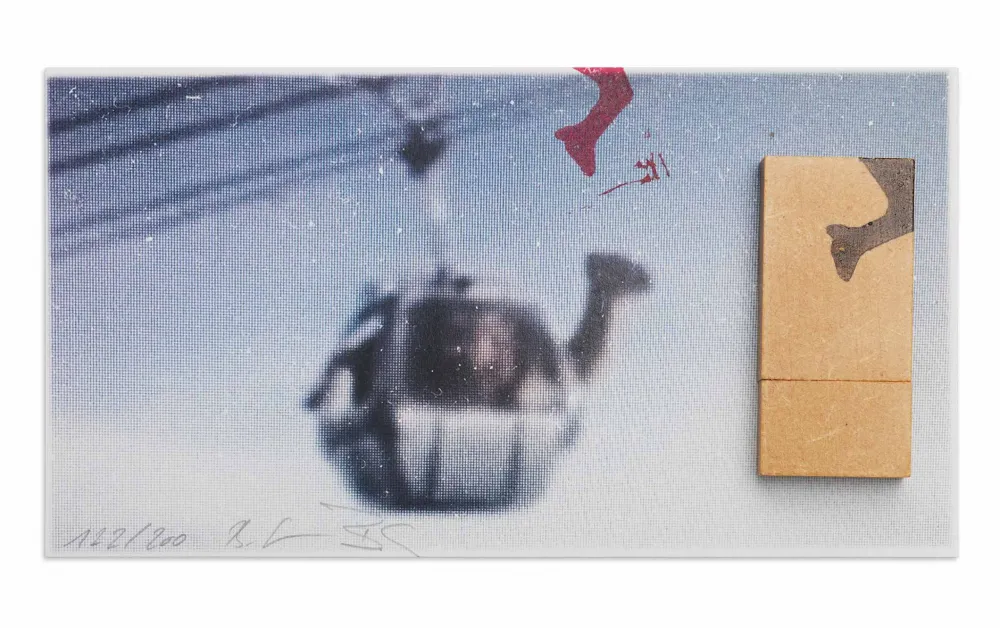
Birgit Naomi Glatzel (born in Kempten, Germany, 1970) & Benjamin Seide (born in Frankfurt Main, Germany, 1968), Going to Jerusalem: Jewish Museum Berlin, photo: Jens Ziehe.
Friends Sixteen Times Removed and a Camel on a World Tour
It’s a warm day of the summer 2016 when I visit Birgit Glatzel in Prenzlauer Berg, the same kind of day it must have been when she shot her photograph Angela and Me, which, like her short film Going to Jerusalem, was available in our art vending machine.
Angela and Birgit
Angela and Me is part of a series in which the artist portrays herself with a friend in self-timed pictures. All the photographs are taken with a 1937 Rolleiflex camera, and the location and backdrop are always chosen together with the friend in question. Birgit embarked upon the project shortly before her emigration to Israel in 2007 – she wanted to take photos to remember her friends in Germany. “Memories play an important role in Judaism, for example an original piece is always left in a newly refurbished apartment,
” explained the artist, who trained as an architect and works as such to earn her living.
Before I talk to Birgit about her art, she shows me the studio where she works and has lived with her son since her return to Berlin. I love the sliding walls that can hide the bathroom of the large studio apartment. Then Birgit tells me that Angela and Me shows her with her friend Angela, whose birthday they were celebrating at the Müggelsee in the summer of 2014. However, only the legs of the two women standing on a swing are shown, and upon closer inspection, a man in the background looking directly into the camera.
“Does it bother you that somebody just walked into your picture?
” I ask Birgit. No, he is part of the picture because he shows the elements of chance and of surprise that can result from the self-timer delay. “I knew the moment the photo was taken that it would turn out like this.
” “And how do you feel about your private souvenir photo hanging in other people’s homes?
” “I love this uncontrollable dispersal of my art. And since our faces are not visible, it is anonymous enough as well.
” There is already a waiting list for the photo series – other friends want to be part of the project.
Jerusalem in the Fridge
Birgit Glatzel also enjoys working with a partner on other projects because it inspires the best ideas. That was how it was with the art film Going to Jerusalem that she made with the animation filmmaker Benjamin Seide. It evolved ten years ago as a contribution for an exhibition in Jerusalem on the theme of “Land(e)scaping.” Benjamin and Birgit wanted to address the complex, five-thousand-year history of Jerusalem in an entertaining way, without ridiculing it.
The idea was sparked by a snow globe containing the Jerusalem skyline and a camel that Birgit had been given by a friend, Hagar from Israel – the two of them decided to “liberate” the city skyline from its ball and send it on a world tour accompanied by the camel. So they destroyed the snowball and used both as “leading actors” for her film. Filming locations included the icebox of Birgit’s fridge and the playground opposite her apartment. “Oddly enough, no one in Israel laughed at the film although it is so absurd – for example you see the camel hanging in a cable car over the Alps,
” wonders Birgit. “Your colleague Gelia Eisert was the first to find the film funny.
” “I also had a good laugh,
” I can reassure Birgit.
Since there was only one more public showing of the film in Jerusalem after the exhibition, Birgit has ensured its survival by putting it on a USB stick for our art vending machine. The stick was stuck on a postcard showing the camel in the cable car and the card is lovingly hand-stamped with camel heads designed by Benjamin Seide and Birgit Glatzel. “Working with Benjamin was great fun,
” laughs Birgit. “It was a charming and very special collaboration during the film production and, many years later, designing the card. Unfortunately, this was our only joint project so far.
”
A Friend is a Friend of a Friend
Still of particular importance to Birgit Glatzel is her first major long-term project, which again unites the two motifs from the other works of art – friendship and travel. This was the first project she used the Rolleiflex for – her camera for special occasions, as one photo costs about 2 euros, so you think twice before pressing the shutter. For A Friend is a Friend of a Friend, Birgit sent herself off traveling for four years and visited first friends around the world, then friends of those friends and so on – a total of 340 people, some of whom were friends 16 times removed. “I wanted to show that it’s possible to do it differently and that the Internet does not replace personal experience.
”
Birgit Glatzel took a picture with her Rolleiflex of all the friends and friends of friends she met and with whom she sometimes stayed. The camera was always a good place to start at a first meeting with what were mostly strangers – “It is is an element that we all know and at the same time you can take photos inconspicuously with it, so it is not so intimidating.
” The Rolleiflex was a chance discovery – “I had always wanted a camera like that and came across it when I was looking for a flash for a different camera.
” The photo project led to an exhibition and many years later to a book that Birgit Glatzel financed through a several-month crowdfunding campaign. It shows very many very different people from all around the world in their private environments. The appendix has a list of everyone depicted, listed by place of residence, occupation, or “friendship clan,” to quote Birgit.
Birgit invites me to look through the Rolleiflex at the end. “You see everything back to front,
” says Birgit “but I don’t even notice that anymore.
” She also gives me a signed copy of A Friend is a Friend of a Friend, number 184 of 300, as a reminder of our afternoon together at her studio, which has flown by. The book now has its place on my desk and reminds me that you should send yourself off traveling more often or visit friends or people who you don’t know (yet).
Mariette Franz, Digital & Publishing
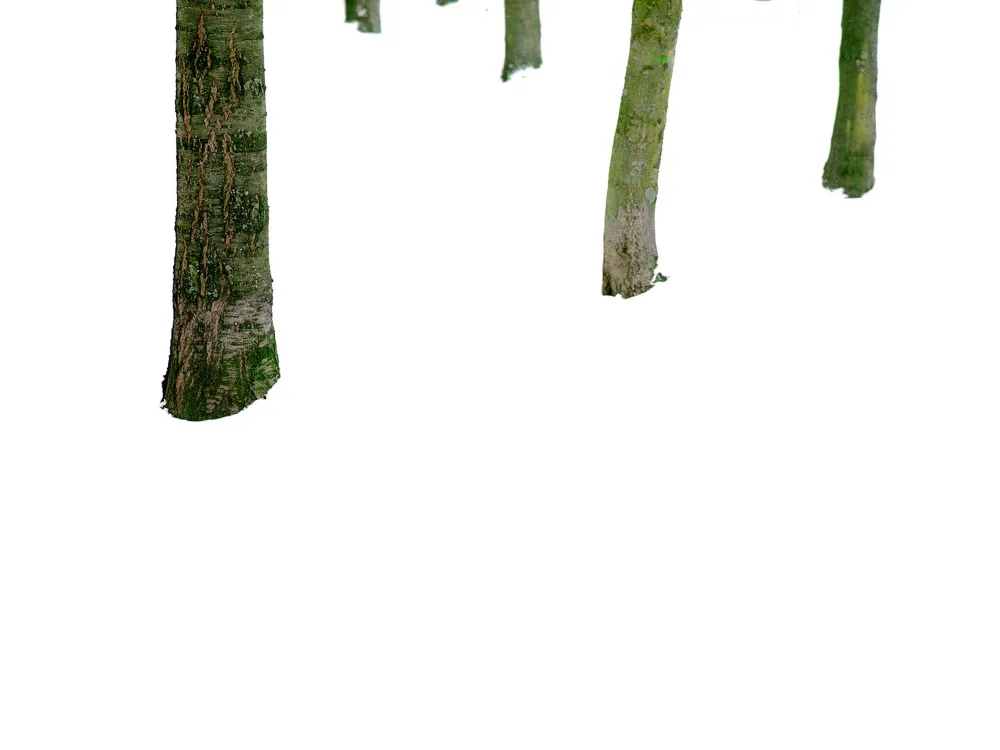
Daniela Orvin (born in Berlin, Germany, 1973), Dyslexic Dysgraphia, 2006, Edition 2015; Jewish Museum Berlin.
Adrift in an Immaculate White Void
Dyslexic dysgraphia—the title of the photo series by Israeli artist Daniela Orvin that was on sale from April 2016 in the Jewish Museum Berlin’s art vending machine is pretty difficult to grasp; but it simply means “difficulty with reading and writing.” “Every one of my artworks is a self-portrait,
” the photographer and musician told me, when I paid her a visit one sunny afternoon at her studio apartment in Berlin-Friedrichshain. She herself has difficulty reading but she was 29 years old before the handicap was detected—despite it having caused considerable disorientation her whole life long.
The Void in My Photos
Place the photos in the Dyslexic dysgraphia series side by side and they resemble the symbols of some bizarre, outlandish language. In reality, they show tree trunks in snow. Daniela Orvin took the photos in Munich, from 2004 to 2006. It was important to her to depict the snow without any trace of a shadow; and so it is that the tree trunks appear to be rootless and isolated, adrift in an immaculate white void.
For our art vending machine, Daniela Orvin mounted her work on acrylic, a painstaking task that forged a personal link between her and each and every image. To my question: “What is the essence of art?” she replied: “The void in my photos.” Loneliness, rootlessness, and the difficulties of interpersonal communication are recurrent themes in her work.
The Language Was in Sleep Mode
The artist was born in Berlin in 1973 and raised in the small town of Ismaning, near Munich, before moving with her family to Israel at the age of 7. It is there that Daniela Orvin spent most of her life to date: in school and in the army; as a student at the renowned Midrasha School of Art in Beit Berl; as co-founder/ curator of a gallery for contemporary photography in Tel Aviv; and as an independent artist, presenting her work in various solo shows. But she never felt she really belonged. In her first years in Israel, she faced exclusion by other kids who saw her as “the German.” This sense of being an outsider has stayed with her ever since.
In 2012 Daniela Orvin moved from Tel Aviv back to her birthplace, Berlin. German is her mother tongue yet she had to relearn it nonetheless; or rather, as she tells me, to reactivate memories of the speech of her childhood: “The language was merely in sleep mode.
” In Berlin she finds the inner peace she needs in order to be able to create: experiences and encounters here, the natural surroundings, and the weather inspire and suffuse her art. More than anything else she loves the intuitive aspects of her work, the unending endeavor to distil the essence of a new project and of photography itself.
Dressur-Wunder
Clear lines, bright light, a sense of calm, and a black and white color scheme are the distinguishing features of Daniela Orvin’s studio apartment. During my visit, she showed me her photo book Dressur-Wunder (The Wonders of Dressage): a volume of images taken from 2007 to 2009 at the Zoologischer Garten in Berlin and the Zirkus Krone in Munich. Here too, Orvin retraces childhood memories, since these are places she visited as a girl with her parents. However, the images betray nothing of the zoo and circus visitors’ enjoyment, but only how solitary and forlorn the animals and artistes appear to feel in the bleak shadows of their respective alienating circumstances. The photographs—no less than the artist herself—are quietly reserved, clinically appraising, and precise.
Maren Krüger, Exhibitions
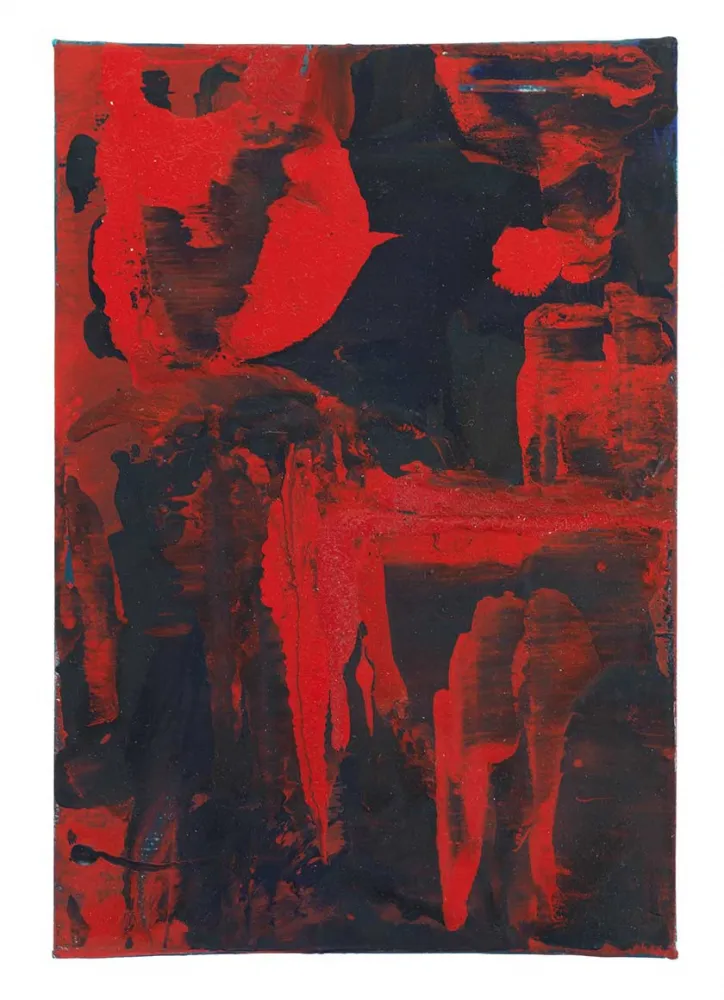
David Benforado (born in Athens, Greece, 1977), Abstract bits from the Painting Makams series, 2014; Jewish Museum Berlin, photo: Jens Ziehe.
Painting Music
“There is a whole world in five notes, just as there is a world in five colors.”
With these words David Benforado, painter and musician, expressed his understanding of art. Painting Makams and Between Sound and Silence are, appropriately, the titles of his two series for the art vending machine, both of which were available for sale from 2016 at the Jewish Museum. Music and painting are combined in the small-scale oils, studies in color filled with energy and vitality.
Ever since David Benforado started painting, he has been working with music. His atelier has again and again been the site of sessions with professional musicians, for instance during his time in Budapest with the accordion player David Yengiburgan and here in Berlin with pianist Antonis Anissegos. In 2009 Benforado began studying the ney, a Middle-Eastern flute, and soon he encountered the world of Turkish makams and modal music from the eastern Mediterranean. This became a source of inspiration for his painting.
The Light on Syros
David Benforado grew up in Greece. The particular light of that region is, as he says, “a part of me”
. A two-year sojourn on the Greek island of Syros was especially formative for him. Through the daily and seasonal rhythm he observed and analyzed the light, with all of its nuances, its transformations. He developed a new perception of color and new ways of using it.
Of the 400 oil paintings in the two series for the art vending machine, each one unique, the artist used two different techniques for painting. He himself mixed the paints from pigment, as always. In the first variant, he spread a number of layers of paint on top of one another. The paints dried in the interim, the last layer following the method “wet-on-wet”. With the second technique the paint got applied all in one batch, in connection with his listening to modal music. The makams underlying this music – series of tones, each marked by certain intervals and a characteristic melodic progression – all stand for different emotions. Every painting conveys the timbre and acoustic color of a specific makam. These works are studies for larger paintings.
Benforado’s paintings evoke associations with nature: surges, waves, fire, wind, the rustling of leaves, sunlight, and sky. Each with its own distinct personality, they invite a kind of meditative immersion and, in addition, the discovery of what might be below the surface.
Leonore Maier, Collections
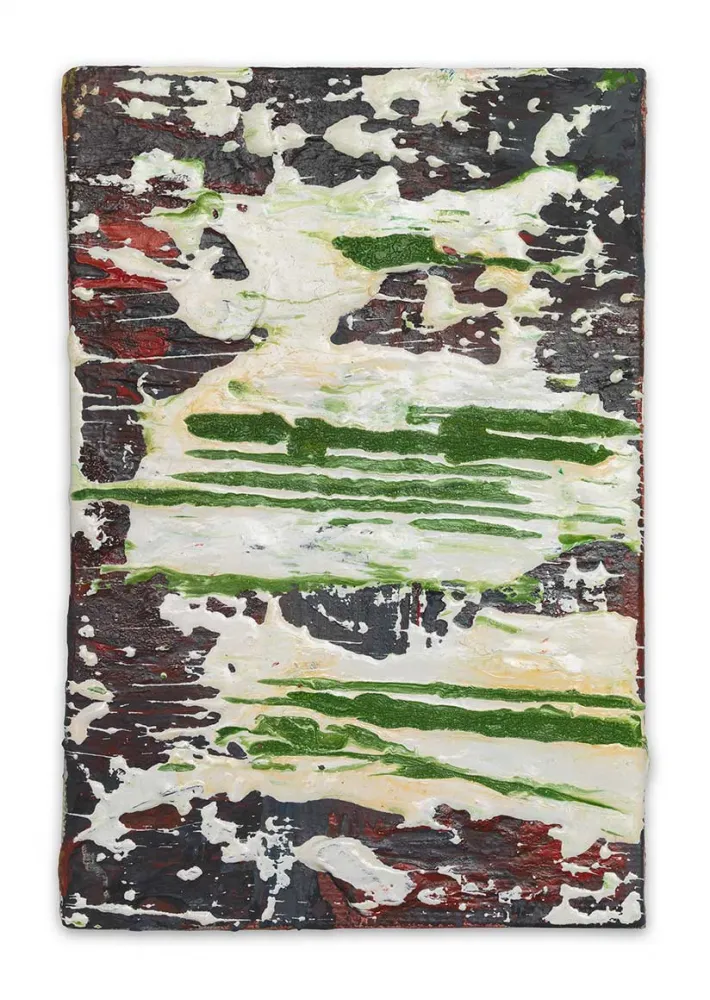
David Benforado (born in Athens, Greece, 1977), Abstract bits from the Between Sound and Silence series, 2015; Jewish Museum Berlin, photo: Jens Ziehe.
Painting Music
“There is a whole world in five notes, just as there is a world in five colors.”
With these words David Benforado, painter and musician, expressed his understanding of art. Painting Makams and Between Sound and Silence are, appropriately, the titles of his two series for the art vending machine, both of which were available for sale from 2016 at the Jewish Museum. Music and painting are combined in the small-scale oils, studies in color filled with energy and vitality.
Ever since David Benforado started painting, he has been working with music. His atelier has again and again been the site of sessions with professional musicians, for instance during his time in Budapest with the accordion player David Yengiburgan and here in Berlin with pianist Antonis Anissegos. In 2009 Benforado began studying the ney, a Middle-Eastern flute, and soon he encountered the world of Turkish makams and modal music from the eastern Mediterranean. This became a source of inspiration for his painting.
The Light on Syros
David Benforado grew up in Greece. The particular light of that region is, as he says, “a part of me”
. A two-year sojourn on the Greek island of Syros was especially formative for him. Through the daily and seasonal rhythm he observed and analyzed the light, with all of its nuances, its transformations. He developed a new perception of color and new ways of using it.
Of the 400 oil paintings in the two series for the art vending machine, each one unique, the artist used two different techniques for painting. He himself mixed the paints from pigment, as always. In the first variant, he spread a number of layers of paint on top of one another. The paints dried in the interim, the last layer following the method “wet-on-wet”. With the second technique the paint got applied all in one batch, in connection with his listening to modal music. The makams underlying this music – series of tones, each marked by certain intervals and a characteristic melodic progression – all stand for different emotions. Every painting conveys the timbre and acoustic color of a specific makam. These works are studies for larger paintings.
Benforado’s paintings evoke associations with nature: surges, waves, fire, wind, the rustling of leaves, sunlight, and sky. Each with its own distinct personality, they invite a kind of meditative immersion and, in addition, the discovery of what might be below the surface.
Leonore Maier, Collections
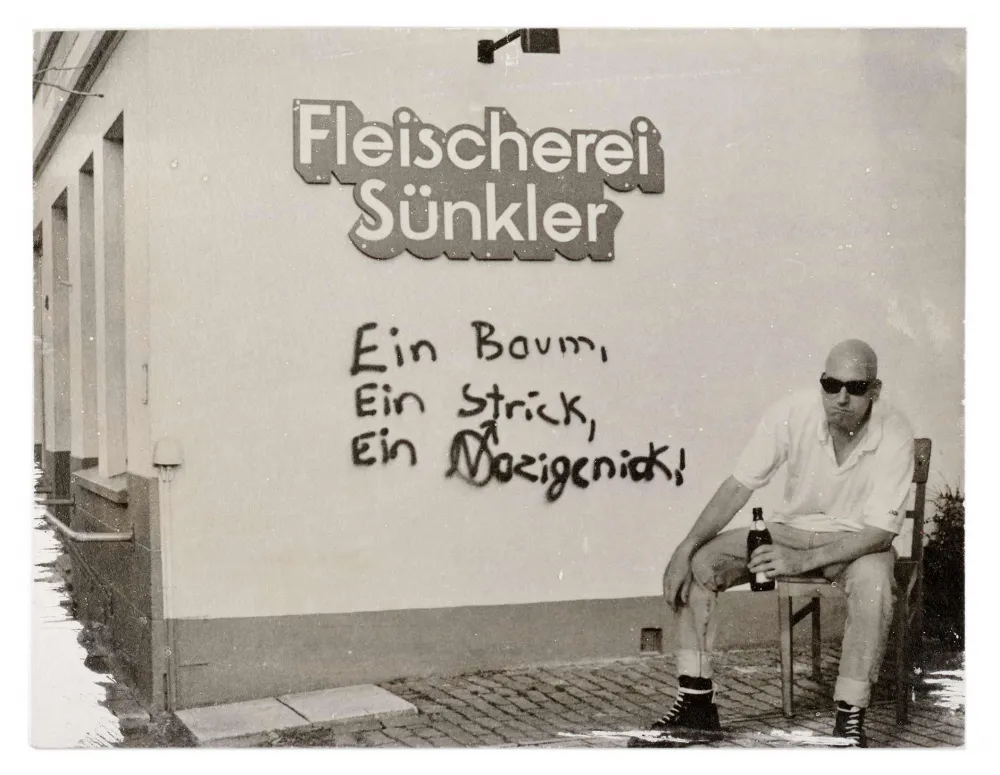
Joachim Seinfeld (born in Paris, France, 1962), HeimatReisen – Oldenburg; Jewish Museum Berlin.
“Art has to be for everyone” Joachim Seinfeld’s HeimatReisen (HomelandTravels)
The wonderful thing about Berlin for me as an historian is that there’s something around every corner waiting to wow me or get my “history heart” to skip a beat. In the year 2016 I was able to get to know yet another spot when I interviewed Joachim Seinfeld in his atelier in the old broadcasting station in the Berlin Treptow-Köpenick district. We talked about his HeimatReisen (HomelandTravels) project for the art vending machine at the Jewish Museum Berlin.
The broadcasting station on Nalepastrasse is a unique place: Beginning in 1956, programming across the former GDR was produced and broadcast from there. The public broadcasting system, established following German reunification, took over this work in 1991 and then, after several changes in ownership, the building became a place for artists from around the world to establish their ateliers.
Michaela Roßberg: Joachim, your photo series – available to visitors in the art vending machine – consists of a number of images depicting you in various locations around Germany. Why, of all your work, these images for the vending machine?
Joachim Seinfeld: In 2006, I did a photo series about Poland. In 2011, I thought to do something similar about Germany. So I wanted to do it anyway, and I chose the images most interesting to me.
Michaela Roßberg: So are the places in the images you yourself are part of also situations from your life?
Joachim Seinfeld: Poland, Germany and Italy are countries I’ve spent extended periods of time in and I attach importance to. I wanted to create a trilogy for these countries with the photo series. The images are largely connected to places I’ve spent a long time in, or nearby. I’m from Munich and lived in Italy, then Oldenburg, and worked two years in Poland. Now I’ve been a long time in Berlin. The altered or modified photos of the places in HeimatReisen play with concepts and clichés of a supposedly typical Germany.
Michaela Roßberg: Is the takeaway with the title, HeimatReisen, that you don’t feel at home in these places?
Joachim Seinfeld: Yes. When I think about the subject of homeland, I always come back to the word, yurt. It’s the Turkish word for homeland, and the yurt, tent, which nomads use for housing, comes from this word. It’s a home you can take with you in your travels. In this sense, HeimatReisen. The only place I really feel at home is in the mountains – the landscape of my childhood. Homeland for me is more a feeling than a particular place. It has to do with my life situation. And it for sure isn’t connected to a feeling of national pride.
Michaela Roßberg: Would your understanding of “homeland” be different for you if you didn’t live in Germany?
Joachim Seinfeld: Quite possibly. The problem is that the German understanding has been completely discredited due to German history and misappropriation of the word. There’s also a positive connotation that has more to do with being and feeling at home. I’m much more comfortable with this than, for example, the Italian word for homeland, patria. That conjures up images of the goosestep in my mind.
Michaela Roßberg: Other countries often have a more natural connection to the idea of homeland. Is this a “German problem?”
Joachim Seinfeld: To a degree, yes, though I personally have a problem with it in other countries’ contexts, too, especially when the concept of homeland approaches the realm of patriotism. I’m of the opinion that the word “patriotism” is itself too closely tied to thinking that one’s own country is better than another’s, and you’re better than someone else. These days, when travel is so much easier and you can experience so many more perspectives, I don’t think we need to be constrained to this idea of homeland. I think we can also find our identity elsewhere.
Michaela Roßberg: What do you want to say with your work? As a viewer, I asked myself: What do you, for example, want to say to me with the Oldenburg work? Something about how many neo-Nazis are in this city?
Joachim Seinfeld: The work contains many facets and discussion points that I address with irony. HeimatReisen also means the images can contain things that I as a traveler or observer could have captured. The Oldenburg staging is of course bathed in cliché. I generally like to do that, but it’s always relevant either to history or current developments. For example, Oldenburg in addition to Weimar had a Nazi administration before 1933, and the region was a playground for their ilk in the 1990s.
Michaela Roßberg: But what should a viewer of your images be thinking? Do you have something particular in mind?
Joachim Seinfeld: That’s not how art works. You don’t make art because people should see something in particular. Then it’s didactic pedagogy or agitprop. You just make art shaped by your thoughts and ideas, and you’re lucky should people happen to get from it what you intended. The artist has to accept the risk that the viewer may have a completely contrary interpretation.
Michaela Roßberg: That explains why I’m not an artist – that’d make me too insecure.
Joachim Seinfeld: You don’t work completely blind; you get feedback a number of ways: If you’ve been making art for 20 years and no one wants to look at it, that’s also a kind of reaction.
Michaela Roßberg: Why are you as yourself always worked into the images?
Joachim Seinfeld: First of all, it’s unbelievable fun to make theater out of it. Second of all, I’m of the opinion that a person is shaped by all aspects of a society. So why should I use another person in the staging? There are exemplary images of this in HeimatReisen and it’s pretty irrelevant who’s pictured in those. Of course I bring individual aspects into the work, for example the “Super Jew” in Friedrichhain. The “Super Jew” kicks over the stoplight, which is actually a pointless action, but he’s very satisfied nonetheless. Sometimes you take yourself too seriously (laughs).
Michaela Roßberg: Is it satisfying for you as an artist when your work is available for 6 euros in a museum vending machine?
Joachim Seinfeld: Sure. I think the idea of an art vending machine is superb. Art has to be for everyone. It’s not just for the wealthy, but should be accessible for all people – also outside a museum.
Michaela Roßberg, Temporary Exhibitions
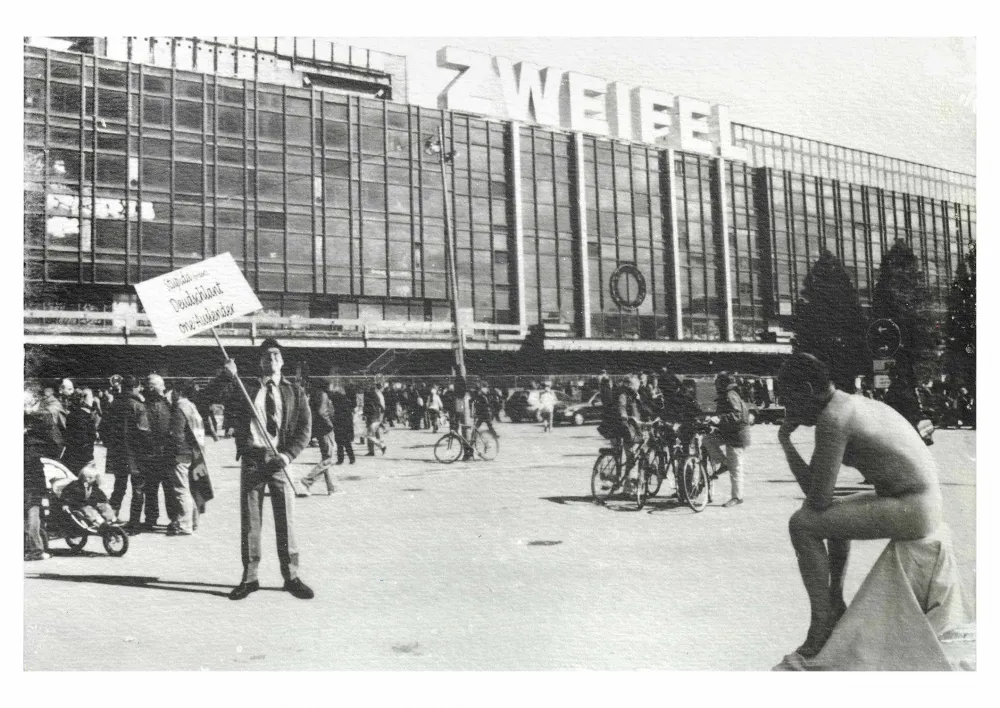
Joachim Seinfeld (born in Paris, France, 1962), HeimatReisen – Berlin-Schlossplatz; Jewish Museum Berlin
“Art has to be for everyone” Joachim Seinfeld’s HeimatReisen (HomelandTravels)
The wonderful thing about Berlin for me as an historian is that there’s something around every corner waiting to wow me or get my “history heart” to skip a beat. In the year 2016 I was able to get to know yet another spot when I interviewed Joachim Seinfeld in his atelier in the old broadcasting station in the Berlin Treptow-Köpenick district. We talked about his HeimatReisen (HomelandTravels) project for the art vending machine at the Jewish Museum Berlin.
The broadcasting station on Nalepastrasse is a unique place: Beginning in 1956, programming across the former GDR was produced and broadcast from there. The public broadcasting system, established following German reunification, took over this work in 1991 and then, after several changes in ownership, the building became a place for artists from around the world to establish their ateliers.
Michaela Roßberg: Joachim, your photo series – available to visitors in the art vending machine – consists of a number of images depicting you in various locations around Germany. Why, of all your work, these images for the vending machine?
Joachim Seinfeld: In 2006, I did a photo series about Poland. In 2011, I thought to do something similar about Germany. So I wanted to do it anyway, and I chose the images most interesting to me.
Michaela Roßberg: So are the places in the images you yourself are part of also situations from your life?
Joachim Seinfeld: Poland, Germany and Italy are countries I’ve spent extended periods of time in and I attach importance to. I wanted to create a trilogy for these countries with the photo series. The images are largely connected to places I’ve spent a long time in, or nearby. I’m from Munich and lived in Italy, then Oldenburg, and worked two years in Poland. Now I’ve been a long time in Berlin. The altered or modified photos of the places in HeimatReisen play with concepts and clichés of a supposedly typical Germany.
Michaela Roßberg: Is the takeaway with the title, HeimatReisen, that you don’t feel at home in these places?
Joachim Seinfeld: Yes. When I think about the subject of homeland, I always come back to the word, yurt. It’s the Turkish word for homeland, and the yurt, tent, which nomads use for housing, comes from this word. It’s a home you can take with you in your travels. In this sense, HeimatReisen. The only place I really feel at home is in the mountains – the landscape of my childhood. Homeland for me is more a feeling than a particular place. It has to do with my life situation. And it for sure isn’t connected to a feeling of national pride.
Michaela Roßberg: Would your understanding of “homeland” be different for you if you didn’t live in Germany?
Joachim Seinfeld: Quite possibly. The problem is that the German understanding has been completely discredited due to German history and misappropriation of the word. There’s also a positive connotation that has more to do with being and feeling at home. I’m much more comfortable with this than, for example, the Italian word for homeland, patria. That conjures up images of the goosestep in my mind.
Michaela Roßberg: Other countries often have a more natural connection to the idea of homeland. Is this a “German problem?”
Joachim Seinfeld: To a degree, yes, though I personally have a problem with it in other countries’ contexts, too, especially when the concept of homeland approaches the realm of patriotism. I’m of the opinion that the word “patriotism” is itself too closely tied to thinking that one’s own country is better than another’s, and you’re better than someone else. These days, when travel is so much easier and you can experience so many more perspectives, I don’t think we need to be constrained to this idea of homeland. I think we can also find our identity elsewhere.
Michaela Roßberg: What do you want to say with your work? As a viewer, I asked myself: What do you, for example, want to say to me with the Oldenburg work? Something about how many neo-Nazis are in this city?
Joachim Seinfeld: The work contains many facets and discussion points that I address with irony. HeimatReisen also means the images can contain things that I as a traveler or observer could have captured. The Oldenburg staging is of course bathed in cliché. I generally like to do that, but it’s always relevant either to history or current developments. For example, Oldenburg in addition to Weimar had a Nazi administration before 1933, and the region was a playground for their ilk in the 1990s.
Michaela Roßberg: But what should a viewer of your images be thinking? Do you have something particular in mind?
Joachim Seinfeld: That’s not how art works. You don’t make art because people should see something in particular. Then it’s didactic pedagogy or agitprop. You just make art shaped by your thoughts and ideas, and you’re lucky should people happen to get from it what you intended. The artist has to accept the risk that the viewer may have a completely contrary interpretation.
Michaela Roßberg: That explains why I’m not an artist – that’d make me too insecure.
Joachim Seinfeld: You don’t work completely blind; you get feedback a number of ways: If you’ve been making art for 20 years and no one wants to look at it, that’s also a kind of reaction.
Michaela Roßberg: Why are you as yourself always worked into the images?
Joachim Seinfeld: First of all, it’s unbelievable fun to make theater out of it. Second of all, I’m of the opinion that a person is shaped by all aspects of a society. So why should I use another person in the staging? There are exemplary images of this in HeimatReisen and it’s pretty irrelevant who’s pictured in those. Of course I bring individual aspects into the work, for example the “Super Jew” in Friedrichhain. The “Super Jew” kicks over the stoplight, which is actually a pointless action, but he’s very satisfied nonetheless. Sometimes you take yourself too seriously (laughs).
Michaela Roßberg: Is it satisfying for you as an artist when your work is available for 6 euros in a museum vending machine?
Joachim Seinfeld: Sure. I think the idea of an art vending machine is superb. Art has to be for everyone. It’s not just for the wealthy, but should be accessible for all people – also outside a museum. Michaela Roßberg, Temporary Exhibitions
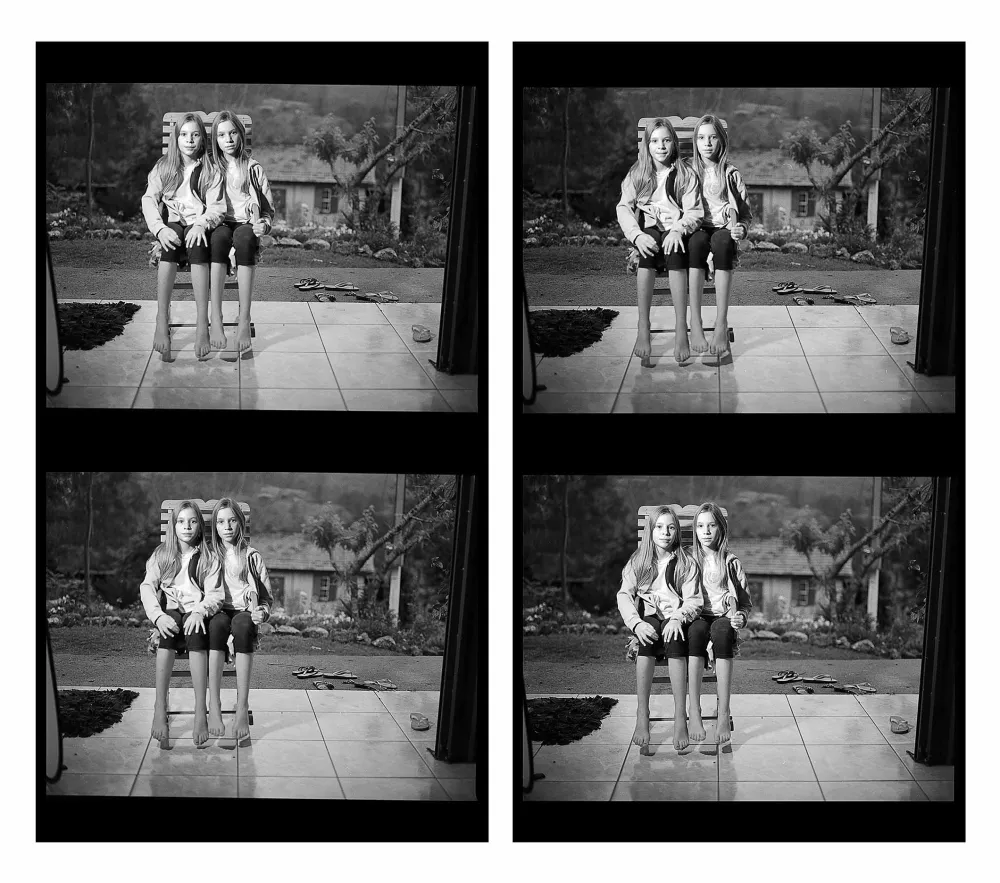
Noga Shtainer (born in Safed, Israel, 1982), Twins: Duo Morality, Edition, 2015, #1; Jewish Museum Berlin.
In the Shadow of the Mengele Myth
Noga Shtainer often travels with her camera in tow, for her photography project Home for Special Children in the Ukraine, for instance, or for Twins in Brazil. Shots from the latter project were available for purchase from the art vending machine in 2016. The photographer has lived since 2010 in Berlin, where I first met her in 2014.
Application trick
The fact that Noga Shtainer is a photographer is itself accidental. She set out to become an actress. But she didn’t pass the entrance auditions for the WIZO School of Art in Haifa and was encouraged instead to apply for a photography class. The deadline for submitting an application portfolio was only two days away, however. So she simply handed in an envelope stuffed with photos and claimed that they were pictures she had taken of her half-sister. In fact, they were photographs from a family album, showing Noga Shtainer herself as a young girl. The trick was successful and Noga Shtainer was accepted at the age of 15 into the WIZO School of Art. Thus began her career as a photographer.
The Differences in What Seems the Same
Photo portraits by Noga Shtainer are distinguished by their commitment and intensity. You can see this in the series “Twins – Duo Morality”. The similarity between two genetically identical people, and the simultaneous desire of the onlooker to differentiate between them, provoked Shtainer’s curiosity. In Israel she had already begun through photography to register the inequalities present in things that are apparently the same. In 2010 she pursued an unlikely trail into the dark history of Nazi ideology’s racial fanaticism: in Cândido Gódoi in southern Brazil, the unusually high density of twins supposedly has a connection to experiments by Josef Mengele. The town consists predominantly of German and Polish immigrants and their descendants who settled in southern Brazil during the First World War. Mengele allegedly lived and practiced medicine in the area in the 1960s, passing undetected under an assumed name. He had carried out brutal medical trials on Jewish prisoners at Auschwitz, including numerous barbaric experiments on twins. He may then have used the results in a variety of treatments on his patients in Brazil. According to some reports, this was why an unusual number of identical twins were born in that region. This story cannot be proven historically nor is there adequate evidence of genetically manipulated pregnancies in Cândido Gódoi. The many blond, blue-eyed pairs of twins, however, gave and continue to give new life to the Mengele Myth, still spurring the imagination of authors, filmmakers, and journalists today.
The Myth Becomes Secondary
When Noga Shtainer arrived in Cândido Gódoi, she first needed to go in search of her models, since twins don’t always make appearances together. A period of intense investigation, going door-to-door and zealously polling neighborhoods, led Noga to find 50 pairs of twins who were prepared to be photographed.
Noga Shtainer’s intention to get to the bottom of this story became secondary to the artistic statement she was making. In the foreground of the series we see the twins in their residential environment, in the backyard or on the terrace: they look almost identical but on closer examination of the photographs one begins to distinguish between them. I caught myself, while observing the pictures, getting excited every time I noticed a difference between a pair of twins. Sometimes it’s the hair, the figure, perhaps a slight variation in the nose or eyes, or a little birthmark. It trains one to look more closely and to see more detail, to compare the surroundings, the position of both people in the image, and perhaps even to question their relationship to one another. As those portrayed become more familiar to the observer, the apparent conformity disappears as one recognizes that each twin is an individual.
Two by Two
For the art vending machine in the permanent exhibition of the Jewish Museum Berlin, Noga Shtainer embarked on an experiment, showing her work in an unusual format. Normally she presents her work on a scale large enough to cover the whole wall, which would of course not have been feasible for the rather compact vending machine with its art treasures. But she took up the challenge and is showing her work here on a proportionately smaller scale, and at the same time doubled up: two copies of four versions of each pair of twins (appropriate enough given the theme). When one looks for instance at the pair of twins called Nelson and Norbert as they search with their Wilhelmine mustaches for the right position to stand in at the garden fence, the autographed pictures seem to contain entire little stories.
Incidentally, after her lucky break getting into the Haifa academy, Shtainer did in fact photograph her half-sister. For twelve straight years she took a picture of Ella on every Shabbat for her series Near Conscious. The intense photographs that emerged show a young girl growing up. In the meantime, Noga Shtainer is now by one of the most renowned galleries in Israel and had shows in Berlin as well through the middle of last February of her series Wagenburg and Near Conscious.
Jihan Radjai, Exhibition and Collections.
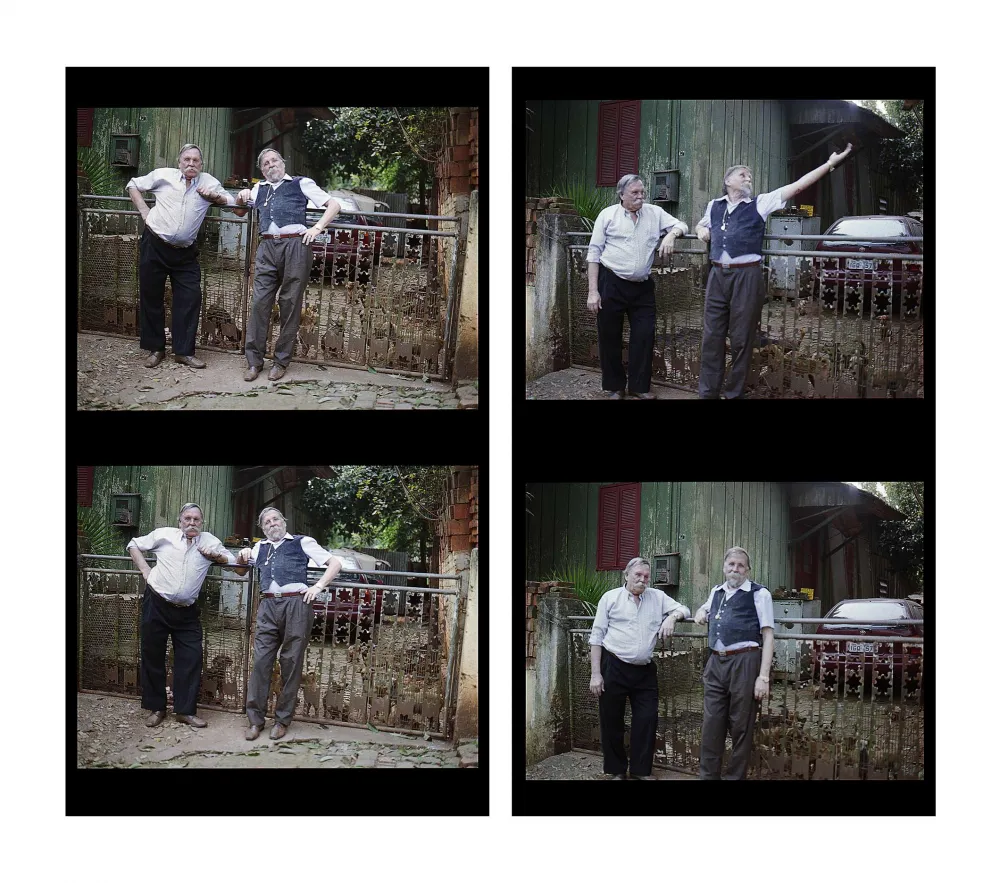
Noga Shtainer (born in Safed, Israel, 1982), Twins: Duo Morality, Edition, 2015, #2; Jewish Museum Berlin.
In the Shadow of the Mengele Myth
Noga Shtainer often travels with her camera in tow, for her photography project Home for Special Children in the Ukraine, for instance, or for Twins in Brazil. Shots from the latter project were available for purchase from the art vending machine in 2016. The photographer has lived since 2010 in Berlin, where I first met her in 2014.
Application trick
The fact that Noga Shtainer is a photographer is itself accidental. She set out to become an actress. But she didn’t pass the entrance auditions for the WIZO School of Art in Haifa and was encouraged instead to apply for a photography class. The deadline for submitting an application portfolio was only two days away, however. So she simply handed in an envelope stuffed with photos and claimed that they were pictures she had taken of her half-sister. In fact, they were photographs from a family album, showing Noga Shtainer herself as a young girl. The trick was successful and Noga Shtainer was accepted at the age of 15 into the WIZO School of Art. Thus began her career as a photographer.
The Differences in What Seems the Same
Photo portraits by Noga Shtainer are distinguished by their commitment and intensity. You can see this in the series “Twins – Duo Morality”. The similarity between two genetically identical people, and the simultaneous desire of the onlooker to differentiate between them, provoked Shtainer’s curiosity. In Israel she had already begun through photography to register the inequalities present in things that are apparently the same. In 2010 she pursued an unlikely trail into the dark history of Nazi ideology’s racial fanaticism: in Cândido Gódoi in southern Brazil, the unusually high density of twins supposedly has a connection to experiments by Josef Mengele. The town consists predominantly of German and Polish immigrants and their descendants who settled in southern Brazil during the First World War. Mengele allegedly lived and practiced medicine in the area in the 1960s, passing undetected under an assumed name. He had carried out brutal medical trials on Jewish prisoners at Auschwitz, including numerous barbaric experiments on twins. He may then have used the results in a variety of treatments on his patients in Brazil. According to some reports, this was why an unusual number of identical twins were born in that region. This story cannot be proven historically nor is there adequate evidence of genetically manipulated pregnancies in Cândido Gódoi. The many blond, blue-eyed pairs of twins, however, gave and continue to give new life to the Mengele Myth, still spurring the imagination of authors, filmmakers, and journalists today.
The Myth Becomes Secondary
When Noga Shtainer arrived in Cândido Gódoi, she first needed to go in search of her models, since twins don’t always make appearances together. A period of intense investigation, going door-to-door and zealously polling neighborhoods, led Noga to find 50 pairs of twins who were prepared to be photographed.
Noga Shtainer’s intention to get to the bottom of this story became secondary to the artistic statement she was making. In the foreground of the series we see the twins in their residential environment, in the backyard or on the terrace: they look almost identical but on closer examination of the photographs one begins to distinguish between them. I caught myself, while observing the pictures, getting excited every time I noticed a difference between a pair of twins. Sometimes it’s the hair, the figure, perhaps a slight variation in the nose or eyes, or a little birthmark. It trains one to look more closely and to see more detail, to compare the surroundings, the position of both people in the image, and perhaps even to question their relationship to one another. As those portrayed become more familiar to the observer, the apparent conformity disappears as one recognizes that each twin is an individual.
Two by Two
For the art vending machine in the permanent exhibition of the Jewish Museum Berlin, Noga Shtainer embarked on an experiment, showing her work in an unusual format. Normally she presents her work on a scale large enough to cover the whole wall, which would of course not have been feasible for the rather compact vending machine with its art treasures. But she took up the challenge and is showing her work here on a proportionately smaller scale, and at the same time doubled up: two copies of four versions of each pair of twins (appropriate enough given the theme). When one looks for instance at the pair of twins called Nelson and Norbert as they search with their Wilhelmine mustaches for the right position to stand in at the garden fence, the autographed pictures seem to contain entire little stories.
Incidentally, after her lucky break getting into the Haifa academy, Shtainer did in fact photograph her half-sister. For twelve straight years she took a picture of Ella on every Shabbat for her series Near Conscious. The intense photographs that emerged show a young girl growing up. In the meantime, Noga Shtainer is now by one of the most renowned galleries in Israel and had shows in Berlin as well through the middle of last February of her series Wagenburg and Near Conscious.
Jihan Radjai, Exhibition and Collections.
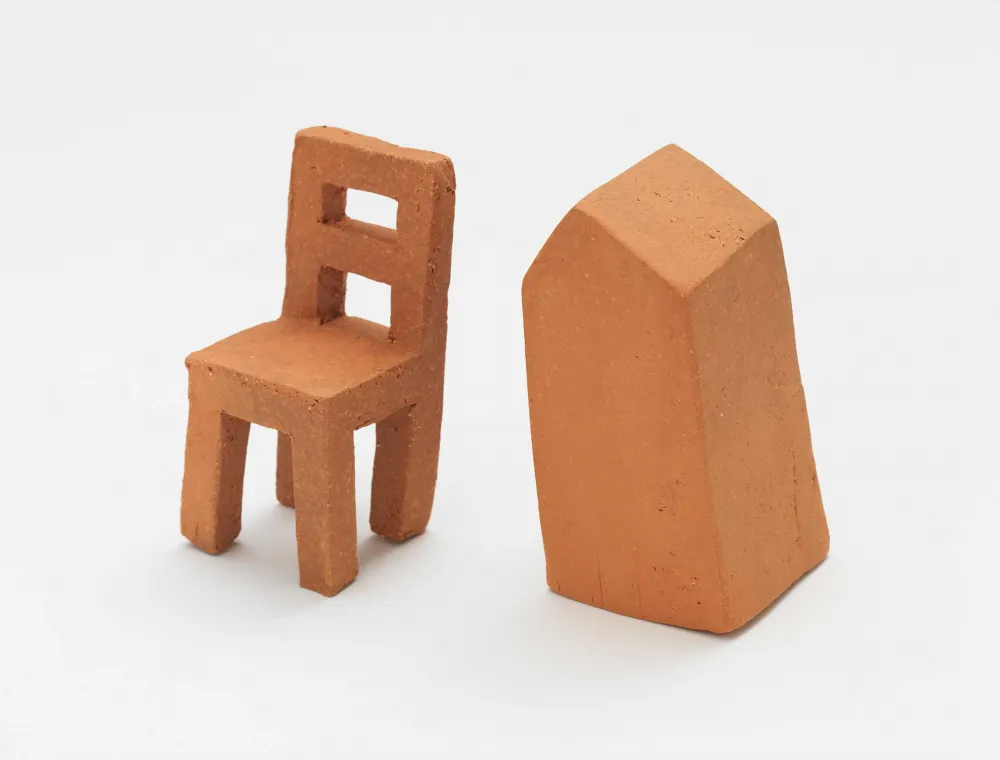
Rachel Kohn (born in Prague, Czechoslovak Republic, today Czech Republic, 1962), 100 Chairs, 100 Houses; Jewish Museum Berlin, photo: Jens Ziehe.
Ceramics for all situations Friends of the Jewish Museum Berlin visit Rachel Kohn
In advance of Rachel Kohn’s work entering our art vending machine, the Friends of the Jewish Museum Berlin had the foresight to paid the artist a visit at her atelier in Berlin Charlottenburg. It was the fourth installment of the art vending machine, for which Kohn has created miniature chairs and houses we could already marvel at during the visit.
Stepping into the atelier in this cozy home, we’re greeted by colorful dishes and fantastical judaica. Small houses and chairs made of clay are displayed on the walls in rows, and sculptures sit majestically atop their white pedestals. The air fills with the aromatic warmth of fresh coffee and tea poured into handmade cups. It’s an inviting welcome.
A Life Leading to the Art Studio
Rachel Kohn was born in Prague and moved to Munich to begin her career in sculpting and ceramics at the Akademie der Bildenden Künste (Academy of Visual Arts) there. Following an academic exchange at the Bezalel Academy of Arts and Design in Jerusalem and additional travel to Bolivia and Mexico, she moved to Berlin in 1993 with her husband. By now, she’s exhibited in galleries throughout Germany and currently sits on the board of the Berlin Women’s Museum, which supports the professional development of female artists.
Our atelier visit begins with brightly colored ceramics piled high on a narrow shelf. Rachel handles each piece, regardless of size, a minimum of 10 times before she’s finished with it. The plates, cups, butter dishes and “Rachel’s ceramic Tupperware” all get the artist’s treatment with painting and decoration. Every item is unique and exceedingly imaginative. With such immense variety, even Rachel can be caught by surprised when she comes across items she’s sold years earlier. She draws her inspiration from the everyday, which is evident in her ceramic’s design: Some vases have multiple parts, suitable for both thin, narrow flowers and stout, voluptuous bouquets. The lid for the stack of cans functions also as a plate and, bathroom aesthetics not to be overlooked, the toilet brush holder is meticulously decorated.
Houses, chairs, Families
Having shown us everyday items, Rachel moves onto a number of clay and bronze sculptures. The recurring house and chair motif, which was part of our art vending machine in 2016, deals with the artist’s perspective of family and interpersonal relationships. The simple chairs can be easily rearranged to allow for various kinds of communication – one arrangement suggesting conversation, another conflict. What makes Rachel’s work particularly interesting is its openness to interpretation.
There are more highlights of the atelier visit: A large sculpture of a dance partners cast in bronze, as well as a white, child’s bed caught in the shadow of a menacing, black cloud. The sculpture is a template for a memorial to child victims of forced labor during the Second World War. The sculpture itself was inaugurated in 2009 by the community of Otterndorf in Lower Saxony.
Christmas-Chanukkia
She concludes with showing us her judaica, some of which you can find in our museum shop. We take particular note of the Hanukkiah assuming the form of a Christmas tree – perfect for any Christmakah celebration! Her seder plates, mezuzot and kiddush cups, which can be quickly converted into everyday use, speak volumes of her creative spectrum. For example, a container that looks like a Hanukkiah when first opened becomes, when turned, Shabbat candles. No need to wait a year to use it again.
Lea Ledwon, Events
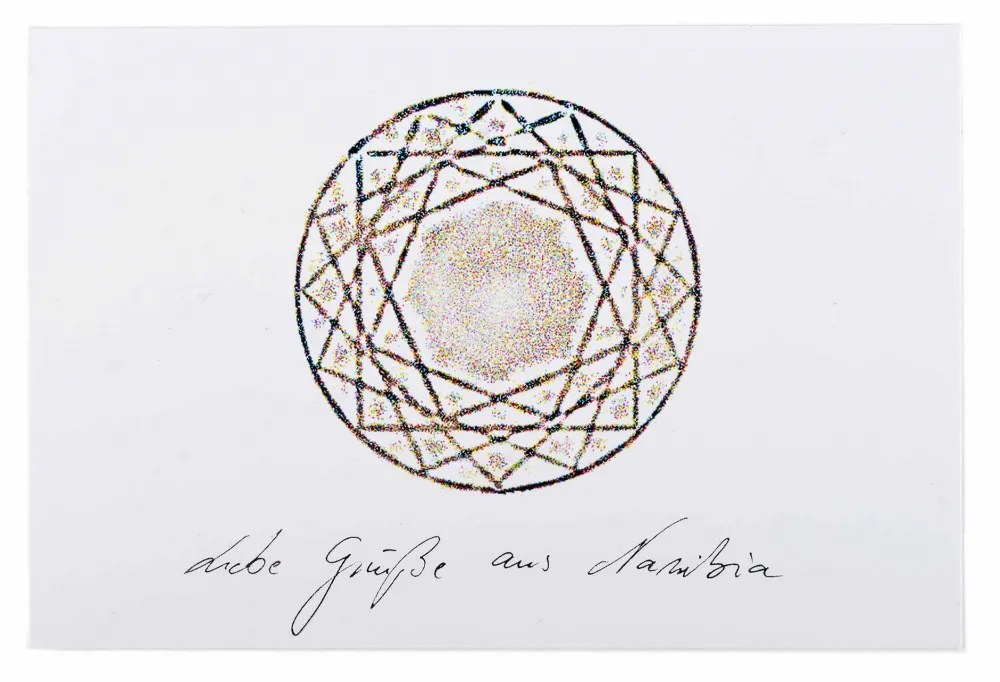
Shira Wachsmann (born in Tel Aviv, Israel, 1984), Liebe Grüße aus Namibia, Postcard, 2015; Jewish Museum Berlin, photo: Jens Ziehe.
A Reminder in the Mail - the Nearly Forgotten Genocide of the Herero and Nama Peoples in Present-Day Namibia
The streets of Kreuzberg are soaked through with rain on this grey February day. Shira Wachsmann, a graceful young woman with short black hair, leads me into her atelier in a pre-war apartment. She doesn’t have much time. Her solo exhibition Tribe Fire was scheduled to open on 13 March 2016 in the gallery cubus-m in Berlin’s Schöneberg neighborhood. It remained there until 23 April 2016. Large drawings, soon to become part of the Tribe Fire installation, hang in the atelier. “There’s still a lot to do,
” the Israeli native explains.
Circled in, Cast out
One of her projects is spread across her desk: two postcards that Wachsmann designed for the Jewish Museum Berlin. She produced editions of 400 of each piece, which were available for individual purchase in 2016 in the art vending machine of the museum’s permanent exhibition. Wachsmann takes a seat in a green armchair and ponders the cards. They show two circular motifs, a form that appears throughout the artist’s work like a guiding principle. Here they depict an abstract diamond and a black sun.
“My pre-occupation with the circle motif started in 2012, when I found a map of Palestine from the period of the British Mandate in a second-hand bookshop in Israel,
” she recalls, pointing to a copy of the map. In the 1950s Jewish localities were circled on it in purple, while defeated or abandoned Arab villages were put in parentheses. The circle visualized belonging and at the same time differentiation: it was a boundary. It symbolizes both perpetuity and exclusivity. “The Zionist movement can be interpreted as a colonial movement,
” says Wachsmann, knowing well what a provocative effect this statement can have. She herself grew up in a village in Galilee on the border of Lebanon. There, pine forests planted by Jewish emigrants simulate a European landscape. Ruins of abandoned Arab villages left an imprint on Wachsmann’s childhood memories. Ever since she has lived in Berlin, she has looked back at her home country with greater detachment.
”Greetings From Namibia”
Shira Wachsmann has long since reflected on colonialism and displacement with eye towards the world beyond Israel as well. In the work she created for the Jewish Museum Berlin’s art vending machine, she deals with the genocide of the Herero people between 1904 and 1908. This destruction was the responsibility of the German Empire and marked a high point of colonial-imperialist aspirations to world power.
The condition of the material she engages with has also evolved: she began with charcoal, an archaic element and vestige of gatherings around a bonfire. Now she has turned to diamonds, a modification of carbon. She associates the colorless crystalline stone with the colonial exploitation of southwest Africa, present-day Namibia. “Liebe Grüße aus Namibia (Best wishes from Namibia),” Wachsmann handwrote on each postcard beneath the motif. Turning the card around, you can read on its back side a quote from then Secretary of State and later Chancellor of the Reich, Bernhard von Bülow (1848–1929): “We don’t wish to place anyone in the shade, but we too demand our place in the sun.” Inside the frame for a stamp in the upper right-hand corner, Wachsmann has a picture of a skull. The German Afrika-Corps used to send greetings via postcard to their faraway homes in the north. The colonial potentates conducted themselves like conquerors: their postcard pictures showed them with imprisoned Herero or even with skulls of the killed.
How Does it Correlate to Judaism?
Wachsmann consciously chose a theme for the art vending machine at the Jewish Museum that could perhaps not be directly linked to Judaism. “The Holocaust of European Jews overcasts all memory of other atrocities that have happened in history – particularly in Israel and Germany. Knowledge about the first genocide of the 20th century, in which 80% of the Herero and almost half of the Nama people were murdered, barely exists in German society.
” The genocide of the Herero was first officially recognized as such by the German federal government in the summer of 2015. German colonial history is still a side issue in German school books.
“The nice thing about the art vending machine is that you never know what you’ll get,
” says Wachsmann with a mischievous smile. She will soon be able to share the history of the Herero with unsuspecting museum visitors. “My postcards are lovely, at first glance. They look like they could be souvenirs.
” If you want to send one of them, first you have to stick a stamp over the skull: a reminder of the suppression of the genocide in Africa from Germany’s collective memory.
Saro Gorgis, Exhibitions
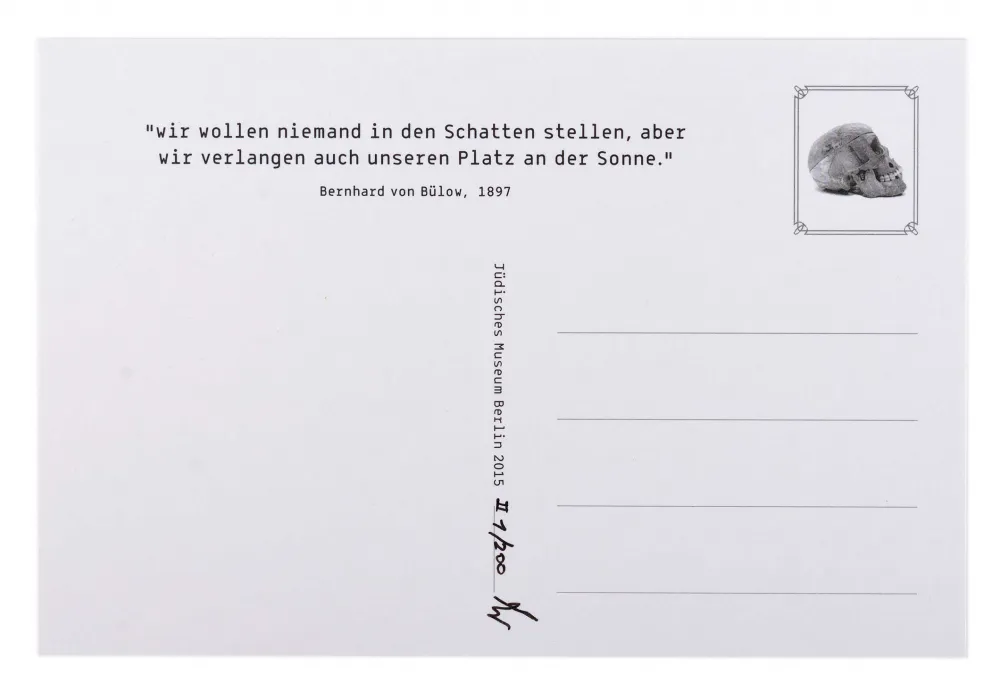
Shira Wachsmann (born in Tel Aviv, Israel, 1984), Liebe Grüße aus Namibia, Postcard, 2015; Jewish Museum Berlin, photo: Jens Ziehe.
A Reminder in the Mail - the Nearly Forgotten Genocide of the Herero and Nama Peoples in Present-Day Namibia
The streets of Kreuzberg are soaked through with rain on this grey February day. Shira Wachsmann, a graceful young woman with short black hair, leads me into her atelier in a pre-war apartment. She doesn’t have much time. Her solo exhibition Tribe Fire was scheduled to open on 13 March 2016 in the gallery cubus-m in Berlin’s Schöneberg neighborhood. It remained there until 23 April 2016. Large drawings, soon to become part of the Tribe Fire installation, hang in the atelier. “There’s still a lot to do,
” the Israeli native explains.
Circled in, Cast out
One of her projects is spread across her desk: two postcards that Wachsmann designed for the Jewish Museum Berlin. She produced editions of 400 of each piece, which were available for individual purchase in 2016 in the art vending machine of the museum’s permanent exhibition. Wachsmann takes a seat in a green armchair and ponders the cards. They show two circular motifs, a form that appears throughout the artist’s work like a guiding principle. Here they depict an abstract diamond and a black sun.
“My pre-occupation with the circle motif started in 2012, when I found a map of Palestine from the period of the British Mandate in a second-hand bookshop in Israel,
” she recalls, pointing to a copy of the map. In the 1950s Jewish localities were circled on it in purple, while defeated or abandoned Arab villages were put in parentheses. The circle visualized belonging and at the same time differentiation: it was a boundary. It symbolizes both perpetuity and exclusivity. “The Zionist movement can be interpreted as a colonial movement,
” says Wachsmann, knowing well what a provocative effect this statement can have. She herself grew up in a village in Galilee on the border of Lebanon. There, pine forests planted by Jewish emigrants simulate a European landscape. Ruins of abandoned Arab villages left an imprint on Wachsmann’s childhood memories. Ever since she has lived in Berlin, she has looked back at her home country with greater detachment.
”Greetings From Namibia”
Shira Wachsmann has long since reflected on colonialism and displacement with eye towards the world beyond Israel as well. In the work she created for the Jewish Museum Berlin’s art vending machine, she deals with the genocide of the Herero people between 1904 and 1908. This destruction was the responsibility of the German Empire and marked a high point of colonial-imperialist aspirations to world power.
The condition of the material she engages with has also evolved: she began with charcoal, an archaic element and vestige of gatherings around a bonfire. Now she has turned to diamonds, a modification of carbon. She associates the colorless crystalline stone with the colonial exploitation of southwest Africa, present-day Namibia. “Liebe Grüße aus Namibia (Best wishes from Namibia),” Wachsmann handwrote on each postcard beneath the motif. Turning the card around, you can read on its back side a quote from then Secretary of State and later Chancellor of the Reich, Bernhard von Bülow (1848–1929): “We don’t wish to place anyone in the shade, but we too demand our place in the sun.” Inside the frame for a stamp in the upper right-hand corner, Wachsmann has a picture of a skull. The German Afrika-Corps used to send greetings via postcard to their faraway homes in the north. The colonial potentates conducted themselves like conquerors: their postcard pictures showed them with imprisoned Herero or even with skulls of the killed.
How Does it Correlate to Judaism?
Wachsmann consciously chose a theme for the art vending machine at the Jewish Museum that could perhaps not be directly linked to Judaism. “The Holocaust of European Jews overcasts all memory of other atrocities that have happened in history – particularly in Israel and Germany. Knowledge about the first genocide of the 20th century, in which 80% of the Herero and almost half of the Nama people were murdered, barely exists in German society.
” The genocide of the Herero was first officially recognized as such by the German federal government in the summer of 2015. German colonial history is still a side issue in German school books.
“The nice thing about the art vending machine is that you never know what you’ll get,
” says Wachsmann with a mischievous smile. She will soon be able to share the history of the Herero with unsuspecting museum visitors. “My postcards are lovely, at first glance. They look like they could be souvenirs.
” If you want to send one of them, first you have to stick a stamp over the skull: a reminder of the suppression of the genocide in Africa from Germany’s collective memory.
Saro Gorgis, Exhibitions
April–September 2015
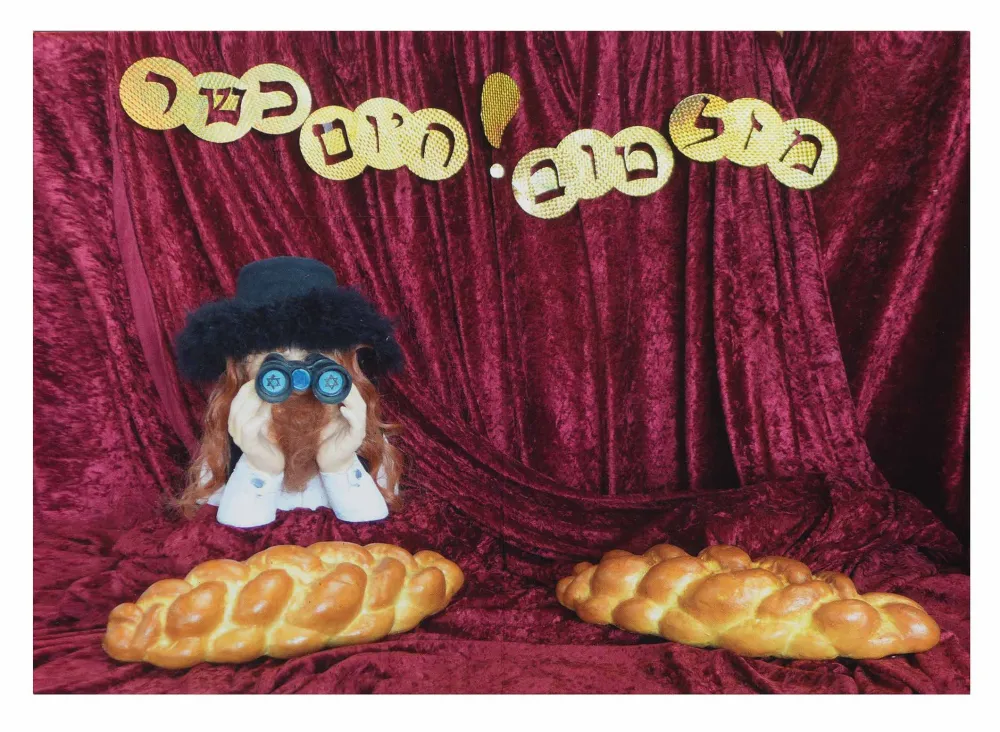
Anna Adam (born in Siegen, Germany, 1963), MAZEL TOV! Everything in your home is kosher today! ; Jewish Museum Berlin, photo: Jens Ziehe.
A “kosher gnome” and everything’s ok? A conversation with Anna Adam
It’s not easy to find the way there. Good thing that the artist picked me up at the nearest subway station in Berlin’s Wedding district. Together we cross the courtyards of various businesses, pass a halal diner, climb a staircase, and suddenly we’re standing in front of the door of her atelier. Hardly has Anna opened it when I see the kosher gnome, observing the world through his binoculars.
It’s this figure that the artist reproduced in paper cut-out form on a card for our art vending machine: you cut the card and fold it to create a three-dimensional object. The instructions state that you should set him in your kitchen and then everything will be ok.
Gelia Eisert: Anna, what does the odd name kosher gnome mean? How do “kosher” and “gnome” even fit together? How will everything be ok? I’m confused.
Anna Adam: At home, a wichtel (in the original German) is an important little man. There are a lot of these “important men”. My “kosher gnome” was born in 2002. He’s definitely supposed to be confusing. “Kosher” and “gnome” fit together because I committed myself to the task of “healing the German-Jewish sickness”, as I call it. To that end I work with satirical means, which – unlike comedy – take everyday politics as a starting point.
Gelia Eisert: You mentioned the year it was born. What were the circumstances of the kosher gnome‘s birth?
Anna Adam: At that time I had started a delicatessen (Feinkostladen) for the Jewish Museum at Franken in Fürth. When people asked if I was serving “heavy food” (schwere Kost), I would tell them, “Oh no, it’s fine food” (Feinkost). Thus came into being “Fine-Food Adam ©”. I had also created some art objects for the museum that you could search for in the exhibition with the help of a kind of treasure map. There were satirical texts as well, that complemented the installation. This is an object from the exhibition, my book Jewish Breathing: an introduction to exhaled happiness. The accompanying beverage Fallowblossom Rose of Jericho, which supported “inner opening”, is unfortunately all gone – it was really good.
I flip through the pages of the book, observing the dramaturgical escalation: approaching the “Jewish soul” through “Jewish breathing.” I can’t help blurting out, But Anna, this is absurd!
Anna Adam: At exhibitions by the Jewish artists’ group “Meshulash” (Hebrew for ‘triangle’), to which I belonged, I would hear comments from dedicated ‘semitophiles’ like “the Jewish people are just so different”. The drawings for the book emerged impromptu, after that experience.
Gelia Eisert: Although this all appears light and ironic, the delicatessen in Fürth was anything but delicate for the public, the press, and the Jewish community. You were even called an anti-Semite.
Anna Adam: That complaint proved itself absurd and it was thrown out. Satire was very unfamiliar territory in that context and even Jews projected everything imaginable onto it. The press were tripping over themselves. It was the birthing hour of my kosher gnome. I got the advice to marry a good religious man, and then you’ll settle down and won’t need to do things like this
. I took a deep breath and answered: Darling. Women like me don’t need to marry a man like that, we just build him.
And that’s what I did. And look, here he is: he’s perfect, he’s smaller than I am, petite like Napoleon, keeps his mouth shut, and makes sure that everything is kosher.
Gelia Eisert: You and your gnome are nearly inseparable. I saw that he is even with you on the Happy Hippy Jew Bus on tours through Germany.
Anna Adam: The person who is really always with me is my life partner Jalda Rebling, a musician and Jewish cantor. We tour with the “BEA” – that’s what our current bus is called – and look for pedestrian areas and schools, where we can work to soften clichés and prejudices through satirical means. The bus is designed à la ‘peace and love with a German car’ so that people cannot stay so serious or afflicted about the subject of Judaism. Some funny things are housed in the bus, things that explain a lot. We’ve been going on these tours since 2011, at first with “BEN” but, sadly, the German Association for Technical Inspection took him away from us.
Gelia Eisert, Exhibitions
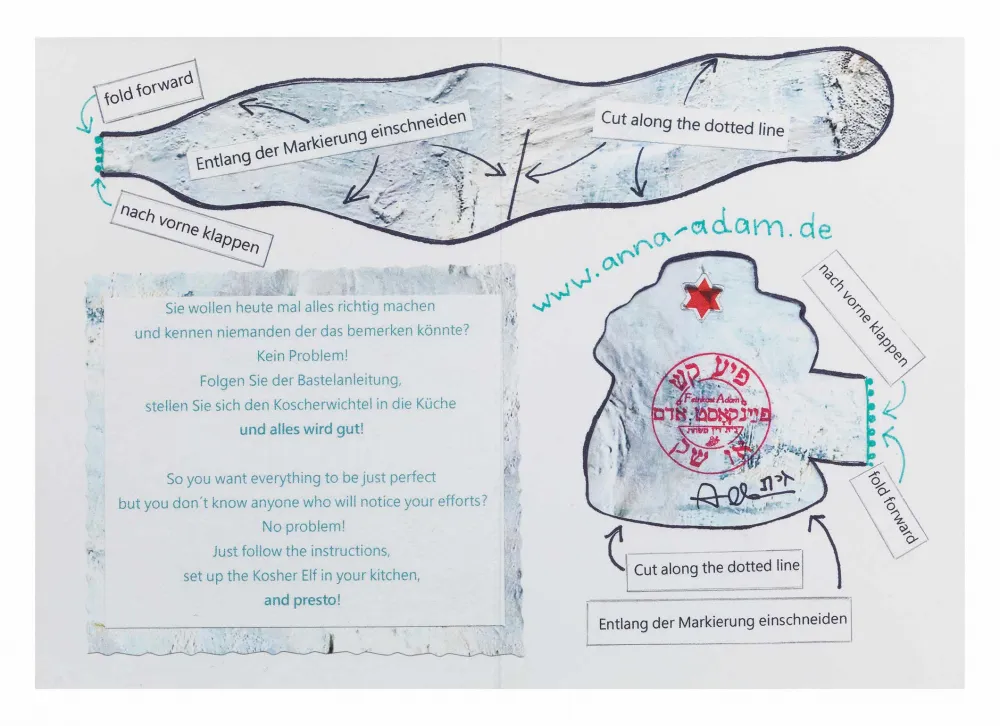
Anna Adam (born in Siegen, Germany, 1963), MAZEL TOV! Everything in your home is kosher today! ; Jewish Museum Berlin, photo: Jens Ziehe.
A “kosher gnome” and everything’s ok? A conversation with Anna Adam
It’s not easy to find the way there. Good thing that the artist picked me up at the nearest subway station in Berlin’s Wedding district. Together we cross the courtyards of various businesses, pass a halal diner, climb a staircase, and suddenly we’re standing in front of the door of her atelier. Hardly has Anna opened it when I see the kosher gnome, observing the world through his binoculars.
It’s this figure that the artist reproduced in paper cut-out form on a card for our art vending machine: you cut the card and fold it to create a three-dimensional object. The instructions state that you should set him in your kitchen and then everything will be ok.
Gelia Eisert: Anna, what does the odd name kosher gnome mean? How do “kosher” and “gnome” even fit together? How will everything be ok? I’m confused.
Anna Adam: At home, a wichtel (in the original German) is an important little man. There are a lot of these “important men”. My “kosher gnome” was born in 2002. He’s definitely supposed to be confusing. “Kosher” and “gnome” fit together because I committed myself to the task of “healing the German-Jewish sickness”, as I call it. To that end I work with satirical means, which – unlike comedy – take everyday politics as a starting point.
Gelia Eisert: You mentioned the year it was born. What were the circumstances of the kosher gnome‘s birth?
Anna Adam: At that time I had started a delicatessen (Feinkostladen) for the Jewish Museum at Franken in Fürth. When people asked if I was serving “heavy food” (schwere Kost), I would tell them, “Oh no, it’s fine food” (Feinkost). Thus came into being “Fine-Food Adam ©”. I had also created some art objects for the museum that you could search for in the exhibition with the help of a kind of treasure map. There were satirical texts as well, that complemented the installation. This is an object from the exhibition, my book Jewish Breathing: an introduction to exhaled happiness. The accompanying beverage Fallowblossom Rose of Jericho, which supported “inner opening”, is unfortunately all gone – it was really good.
I flip through the pages of the book, observing the dramaturgical escalation: approaching the “Jewish soul” through “Jewish breathing.” I can’t help blurting out, But Anna, this is absurd!
Anna Adam: At exhibitions by the Jewish artists’ group “Meshulash” (Hebrew for ‘triangle’), to which I belonged, I would hear comments from dedicated ‘semitophiles’ like “the Jewish people are just so different”. The drawings for the book emerged impromptu, after that experience.
Gelia Eisert: Although this all appears light and ironic, the delicatessen in Fürth was anything but delicate for the public, the press, and the Jewish community. You were even called an anti-Semite.
Anna Adam: That complaint proved itself absurd and it was thrown out. Satire was very unfamiliar territory in that context and even Jews projected everything imaginable onto it. The press were tripping over themselves. It was the birthing hour of my kosher gnome. I got the advice to marry a good religious man, and then you’ll settle down and won’t need to do things like this
. I took a deep breath and answered: Darling. Women like me don’t need to marry a man like that, we just build him.
And that’s what I did. And look, here he is: he’s perfect, he’s smaller than I am, petite like Napoleon, keeps his mouth shut, and makes sure that everything is kosher.
Gelia Eisert: You and your gnome are nearly inseparable. I saw that he is even with you on the Happy Hippy Jew Bus on tours through Germany.
Anna Adam: The person who is really always with me is my life partner Jalda Rebling, a musician and Jewish cantor. We tour with the “BEA” – that’s what our current bus is called – and look for pedestrian areas and schools, where we can work to soften clichés and prejudices through satirical means. The bus is designed à la ‘peace and love with a German car’ so that people cannot stay so serious or afflicted about the subject of Judaism. Some funny things are housed in the bus, things that explain a lot. We’ve been going on these tours since 2011, at first with “BEN” but, sadly, the German Association for Technical Inspection took him away from us.
Gelia Eisert, Exhibitions
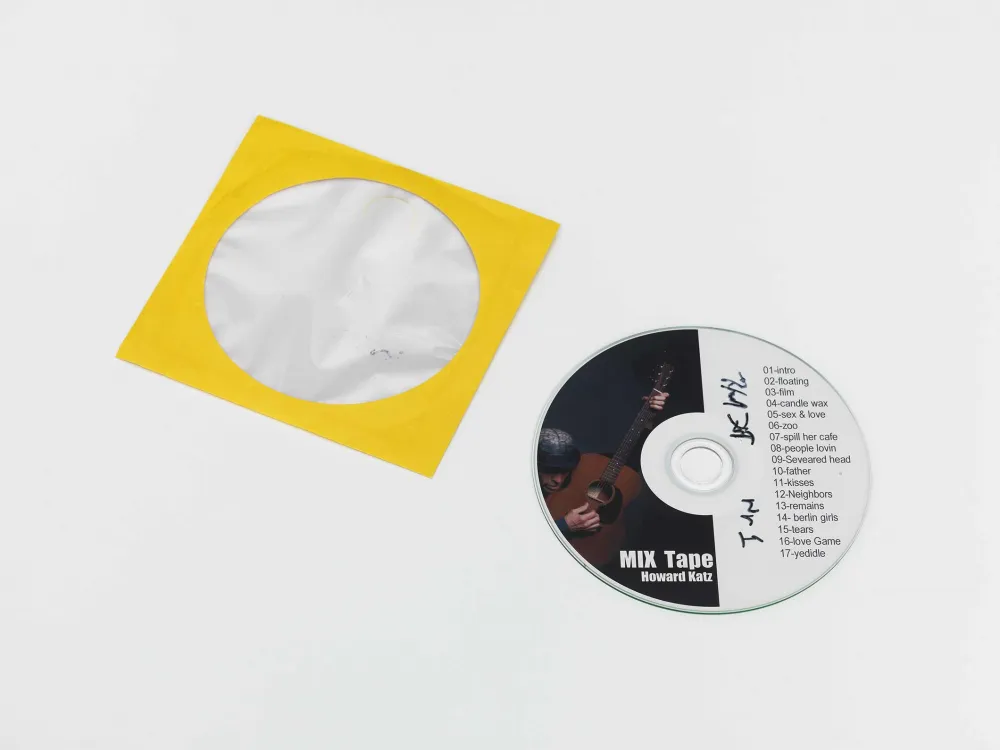
Howard Katz (born in New York, USA), MIX Tape, 2014; Jewish Museum Berlin, photo: Jens Ziehe.
Energy galore: encountering Howard Katz
It always goes by so quickly: in summer 2015, it felt as if the third round of the art vending machine in the Jewish Museum Berlin’s permanent exhibition had just started. But in fact it was already almost finished and sold out – 2,600 works! That was certainly enough reason to pop by to visit Howard Katz and ask him some questions, especially considering that he had been the first of the at the time 22 artists we’d featured to use music…
Dagmar Ganßloser: Howard, you work as an artist in many different genres. You’re a dancer, performer, and choreographer, but you’re also an active visual artist, and on top of that a singer-songwriter. Right now the art vending machine has your Mix Tape as well as 4 short films. How did you choose those?
Howard Katz: It was clear to me from the start that I wanted to present my music in the art vending machine. The 17 songs on Mix Tape came into being over the last twenty years plus and – the same as 4 short films – they’re mainly about experiences I’ve had since I’ve lived in Berlin, so since the mid-1990s. The production was uncomplicated and I made the selection intuitively, from the heart. I made the four videos for my songs completely on my own, with my telephone – it was an opportunity to try out something new.
Dagmar Ganßloser: On Mix Tape you talk directly to your potential listeners, asking them for feedback on your youtube channel and you categorize your manner as a “very Jewish way of storytelling”. What do you mean by that?
Howard Katz: I grew up in New York and as a Jew I belonged to one of many minorities, which was anything but conflict-free. When I came here I became much more conscious of being Jewish. My work was rejected a few times because it’s too personal and too emotional. One woman told me, It’s a bit embarrassing because it’s so emotional. We need distance.
For me, Jewish means: we’re pretty close to each other, sometimes it hurts, sometimes it sticks, sometimes there’s friction.
Dagmar Ganßloser: How long have you been writing songs?
Howard Katz: I wrote my first songs when I was 12 or 13. I still find the music I wrote back then charming and lovely, but it wasn’t until I was in my mid-40s that I really found my voice. I also write songs in German, by the way…
Dagmar Ganßloser: Along with dance and music you also do bodywork. Have you been doing that a long time?
Howard Katz: I’ve been interested in people since I was little and I always saw immediately if something in the quality of their movements or emotions was interesting. That’s my talent. So I always wanted to work with people, that was quite clear. When I was eight, I tried to talk my parents into letting me learn dance, but they didn’t allow it. I then waited a long time – another eight years! – but finally I began (he laughs): I moved out when I was 16, started my dance training, worked on the side, and at 17 I already had my own practice in a New York dance studio doing reflexology and other massage techniques.
Dagmar Ganßloser: What really struck me about the amplitude of your work is that there’s a huge range and yet it all reveals your particular ‘handwriting’. That’s not just true of your music but also your choreography. For instance, with Kata. And it’s also clear in the movement system that you developed, “5qualities”.
Howard Katz: My handwriting is always clearly visible. I can’t say exactly why that’s the case. Other people do exactly the same thing but you don’t see that it’s them, whereas in my work you always see it’s mine. My artistic and my therapeutic work are really one entity for me.
Dagmar Ganßloser: What is “5qualities” actually about? Are you trying to communicate a style of movement or is it something more?
Howard Katz: It began with my search for a system of movement that everyone could learn. Of course I started with many more qualities, with 122! But eventually I noticed that there are only five: carry, fall, flow, throw, put – the rest are really a mix of these five basic qualities. I found these five qualities in every style of dance and in every type of martial art as well. “5qualities” as a technique can help people to find their equilibrium and it can thus support the process of self-discovery or personal development. So, I’m not healing, it’s more about encouraging self-help.
Dagmar Ganßloser: What are you working on at the moment?
Howard Katz: My wife, Liz Williams, and I did our first cabaret show at the end of June, NOIR, MusicCircusTheater, with Berlin’s best artistes. They’re really fantastic! We’re doing some genuinely dangerous acts in the air. I’ve been learning this in the last few years and have gotten quite good. I made the music for NOIR as well, together with my band PostHolocaustPop – here under the name PostTraumaticPop. And we’ve started a company with the artistes so we’re going to keep doing more.
Dagmar Ganßloser, Digital & Publishing
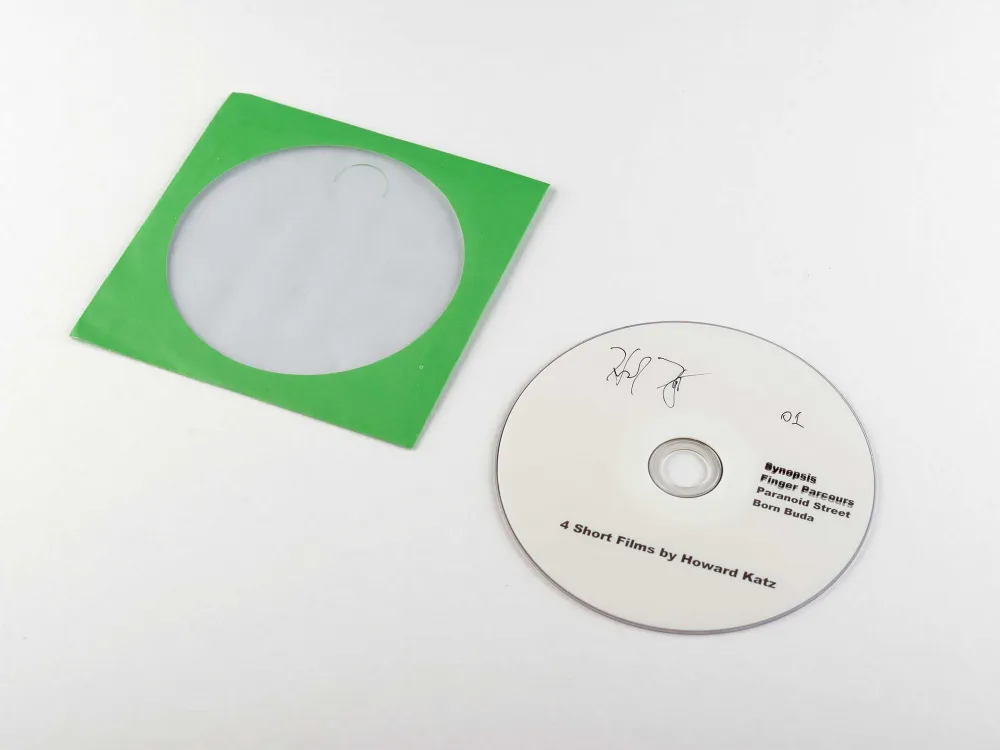
Howard Katz (born in New York, USA), 4 Short Films, 2015; Jewish Museum Berlin, photo: Jens Ziehe.
Energy galore: encountering Howard Katz
It always goes by so quickly: in summer 2015, it felt as if the third round of the art vending machine in the Jewish Museum Berlin’s permanent exhibition had just started. But in fact it was already almost finished and sold out – 2,600 works! That was certainly enough reason to pop by to visit Howard Katz and ask him some questions, especially considering that he had been the first of the at the time 22 artists we’d featured to use music…
Dagmar Ganßloser: Howard, you work as an artist in many different genres. You’re a dancer, performer, and choreographer, but you’re also an active visual artist, and on top of that a singer-songwriter. Right now the art vending machine has your Mix Tape as well as 4 short films. How did you choose those?
Howard Katz: It was clear to me from the start that I wanted to present my music in the art vending machine. The 17 songs on Mix Tape came into being over the last twenty years plus and – the same as 4 short films – they’re mainly about experiences I’ve had since I’ve lived in Berlin, so since the mid-1990s. The production was uncomplicated and I made the selection intuitively, from the heart. I made the four videos for my songs completely on my own, with my telephone – it was an opportunity to try out something new.
Dagmar Ganßloser: On Mix Tape you talk directly to your potential listeners, asking them for feedback on your youtube channel and you categorize your manner as a “very Jewish way of storytelling”. What do you mean by that?
Howard Katz: I grew up in New York and as a Jew I belonged to one of many minorities, which was anything but conflict-free. When I came here I became much more conscious of being Jewish. My work was rejected a few times because it’s too personal and too emotional. One woman told me, It’s a bit embarrassing because it’s so emotional. We need distance.
For me, Jewish means: we’re pretty close to each other, sometimes it hurts, sometimes it sticks, sometimes there’s friction.
Dagmar Ganßloser: How long have you been writing songs?
Howard Katz: I wrote my first songs when I was 12 or 13. I still find the music I wrote back then charming and lovely, but it wasn’t until I was in my mid-40s that I really found my voice. I also write songs in German, by the way…
Dagmar Ganßloser: Along with dance and music you also do bodywork. Have you been doing that a long time?
Howard Katz: I’ve been interested in people since I was little and I always saw immediately if something in the quality of their movements or emotions was interesting. That’s my talent. So I always wanted to work with people, that was quite clear. When I was eight, I tried to talk my parents into letting me learn dance, but they didn’t allow it. I then waited a long time – another eight years! – but finally I began (he laughs): I moved out when I was 16, started my dance training, worked on the side, and at 17 I already had my own practice in a New York dance studio doing reflexology and other massage techniques.
Dagmar Ganßloser: What really struck me about the amplitude of your work is that there’s a huge range and yet it all reveals your particular ‘handwriting’. That’s not just true of your music but also your choreography. For instance, with Kata. And it’s also clear in the movement system that you developed, “5qualities”.
Howard Katz: My handwriting is always clearly visible. I can’t say exactly why that’s the case. Other people do exactly the same thing but you don’t see that it’s them, whereas in my work you always see it’s mine. My artistic and my therapeutic work are really one entity for me.
Dagmar Ganßloser: What is “5qualities” actually about? Are you trying to communicate a style of movement or is it something more?
Howard Katz: It began with my search for a system of movement that everyone could learn. Of course I started with many more qualities, with 122! But eventually I noticed that there are only five: carry, fall, flow, throw, put – the rest are really a mix of these five basic qualities. I found these five qualities in every style of dance and in every type of martial art as well. “5qualities” as a technique can help people to find their equilibrium and it can thus support the process of self-discovery or personal development. So, I’m not healing, it’s more about encouraging self-help.
Dagmar Ganßloser: What are you working on at the moment?
Howard Katz: My wife, Liz Williams, and I did our first cabaret show at the end of June, NOIR, MusicCircusTheater, with Berlin’s best artistes. They’re really fantastic! We’re doing some genuinely dangerous acts in the air. I’ve been learning this in the last few years and have gotten quite good. I made the music for NOIR as well, together with my band PostHolocaustPop – here under the name PostTraumaticPop. And we’ve started a company with the artistes so we’re going to keep doing more.
Dagmar Ganßloser, Digital & Publishing
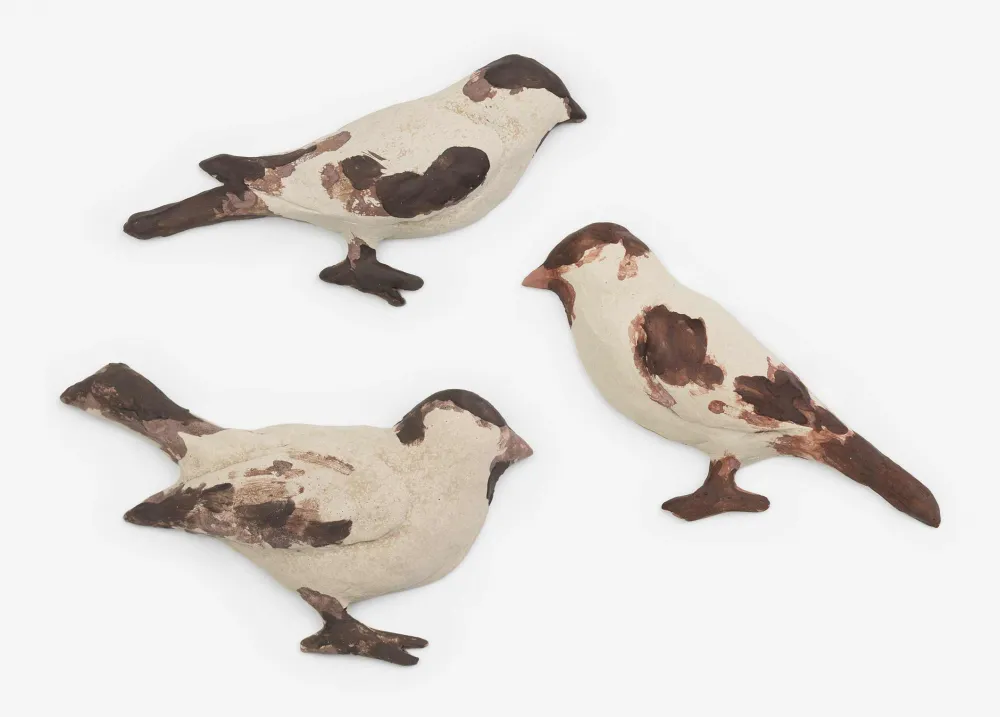
Maria und Natalia Petschatnikov (born in Leningrad, Soviet Union, today St. Petersburg, Russia, 1973), SPARROWS, Acrystal, 2014; Jewish Museum Berlin, photo: Jens Ziehe.
Sparrows, 4 Euro, and the Stuff of a City
The end of May 2015, as the first palpable rays of sun shone in Berlin, offered the perfect occasion for an outing to Berlin’s Kreuzberg neighborhood. There the artists Maria and Natalia Petschatnikov showed me their atelier and told me about Sparrows and 4 Euros, the two objects they made for the Jewish Museum Berlin’s art vending machine. They also talked about their current projects and responded with good humor to all of my questions above and beyond the subject of art.
Michaela Roßberg: You work together and you’re twins – identical twins. What is it like to work so closely? How do you develop ideas and work on projects? And does one or the other of you start with an image of the finished work in mind?
Maria: We do a lot through dialogue. It isn’t that one of us has an idea and, once a project is finished, could say: That was my idea.
Our work emerges from a joint process. For instance, we walk through the city and see interesting things that get us thinking. We talk about them, and together, start forming ideas.
Natalia: The urban environment is something that frequently inspires us. Because we spend a lot of time together in observation, a lot of our work features the so-called little things of everyday life, like animals or public transportation.
Michaela Roßberg: What did you think when the Jewish Museum Berlin asked you about participating in the new series for the art vending machine? Why did you decide to do it?
Natalia: First of all, we have a lot of respect for the institution of the museum. But also, the project gives us the chance to tell something about ourselves and our work. We produced 400 objects for the vending machine, which means that hopefully we are reaching 400 people with our art. The feeling that you reach people with your own work is very important for artists.
Maria: We find the idea very good, as well. Art is often elitist: we can’t afford our friends’ work and they can’t afford ours. The great thing about the art vending machine is that it builds a lovely bridge between art and the museum’s visitors. We don’t make a distinction between our work for 4 euros or 400 euros. We put the same effort into both. In addition, the appreciation and respect for us as artists was pleasing, along with the impressive amount of effort the people in charge of the project made, even though the works only cost 4 euros.
Michaela Roßberg: Normally an artist produces one, or perhaps a few, pieces of one artwork, not 200, as for the art vending machine. Doesn’t the sheer quantity get frustrating at some point?
Natalia: On the contrary, as you work on multiple pieces from the same model, your connection to the work changes. You start to play with it; you experience it differently.
Michaela Roßberg: Even when it’s the 150th time? (Both laugh)
Maria: It went really well with the Sparrows for the vending machine because we cast them. It was a lot of work, but not as much work as the paintings. But then even with the 4 Euros paintings, we had specific reasons for them: there was a conceptual level to them. For us that was really a commentary on what’s happening in our field. Who decides how much a work of art is worth? Who does the appraisal?
Natalia: So museum visitors will get a piece of art by us that costs 4 euros, and for this 4 euros, they receive 4 euros back, only now as a painting that shows the coins.
Michaela Roßberg: Together with every object in the art vending machine there’s a leaflet with information about the artists and the ideas behind the works. Accompanying yours, we read that – in your opinion – small things often reflect larger social and historical tendencies. I find that fascinating. Could you talk more about that?
Natalia: You can see the way this works in Berlin in particular with, for instance, public transportation like the tram. There haven’t been trams in West Berlin since the 70s because they were considered too loud, a disturbance. In the East though, the network of trams was extensively developed. After reunification, people noticed that the tram significantly improves the quality of life because you can get through city traffic much more easily by tram and it’s more environmentally friendly. Now the tram network is being expanded.
Maria: Or simply coffee-to-go. Not even in German, “zum Mitnehmen”, but “to go”. How have people or society itself developed such that suddenly we want to drink our coffee while moving? Why did no one think of that before – to walk down the street with his coffee in his hand? People used to sit quietly somewhere to drink their coffee. We try to carve out the remarkable little things that could seem trivial, but that we think demonstrate such tendencies. Like archeologists or anthropologists, we try to render these things perceptible. Imagine what will happen when someone finds a coffee-to-go cup hundreds of years from now. Researchers will probably try to draw conclusions about the society of 2015 from objects like these.
Michaela Roßberg: What are you working on at the moment? Is that a detail from the flea market at Berlin’s Mauerpark? At any rate I recognize the Jahn Stadium, being a soccer fan.
Natalia: Yes, we saw exactly this scene that you see on the wall, at the flea market. We took a photograph and then painted it in oils on a lot of little metal plates. We found the old pieces of furniture being sold there fascinating, together with their reflections in the puddles on the ground around them.
Maria: The work is part of a project called Berlin & Berlin. We showed this installation consisting of paintings and objects at the German Week in St. Petersburg last April. We find flea markets so interesting because they offer a likeness of society at this very moment and they bring so many things together that would never otherwise be together. Such as a Barbie doll with a Russian nesting doll. Both are emblematic of different worlds but now they’re for sale in the same box.
Michaela Roßberg: Most of your works have to do with Berlin. What does the city mean to you?
Maria: We try to investigate each place we live on a visual level. Berlin is special though: I find that this city has unbelievably many levels. They aren’t all happy or funny, but the deeper you go, the more stories open up.
Natalia: We aren’t politicians or historians. We observe the world on a different level, the visual one. When we moved here, it was clear that we needed to live in the East.
Maria: After reunification the Eastern part of the city was more exciting for artists and young people, much cheaper, and it offered more possibility. A lot of houses for artists emerged and people were able to found new galleries. We still feel this energy. But now we’re starting to discover West Berlin. You can find exciting angles on history and great places for art there. So – we will always have material for new projects in Berlin.
Michaela Roßberg, Exhibitions
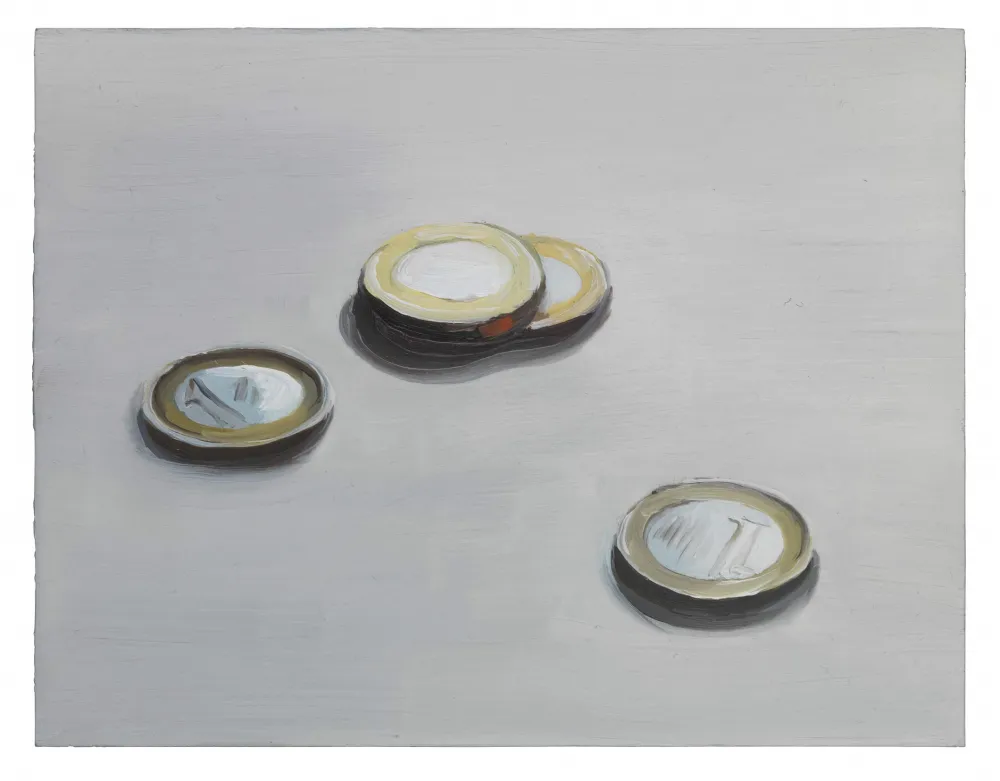
Maria und Natalia Petschatnikov (born in Leningrad, Soviet Union, today St. Petersburg, Russia, 1973), 4 Euros; Jewish Museum Berlin, photo: Jens Ziehe.
Sparrows, 4 Euro, and the Stuff of a City
The end of May 2015, as the first palpable rays of sun shone in Berlin, offered the perfect occasion for an outing to Berlin’s Kreuzberg neighborhood. There the artists Maria and Natalia Petschatnikov showed me their atelier and told me about Sparrows and 4 Euros, the two objects they made for the Jewish Museum Berlin’s art vending machine. They also talked about their current projects and responded with good humor to all of my questions above and beyond the subject of art.
Michaela Roßberg: You work together and you’re twins – identical twins. What is it like to work so closely? How do you develop ideas and work on projects? And does one or the other of you start with an image of the finished work in mind?
Maria: We do a lot through dialogue. It isn’t that one of us has an idea and, once a project is finished, could say: That was my idea.
Our work emerges from a joint process. For instance, we walk through the city and see interesting things that get us thinking. We talk about them, and together, start forming ideas.
Natalia: The urban environment is something that frequently inspires us. Because we spend a lot of time together in observation, a lot of our work features the so-called little things of everyday life, like animals or public transportation.
Michaela Roßberg: What did you think when the Jewish Museum Berlin asked you about participating in the new series for the art vending machine? Why did you decide to do it?
Natalia: First of all, we have a lot of respect for the institution of the museum. But also, the project gives us the chance to tell something about ourselves and our work. We produced 400 objects for the vending machine, which means that hopefully we are reaching 400 people with our art. The feeling that you reach people with your own work is very important for artists.
Maria: We find the idea very good, as well. Art is often elitist: we can’t afford our friends’ work and they can’t afford ours. The great thing about the art vending machine is that it builds a lovely bridge between art and the museum’s visitors. We don’t make a distinction between our work for 4 euros or 400 euros. We put the same effort into both. In addition, the appreciation and respect for us as artists was pleasing, along with the impressive amount of effort the people in charge of the project made, even though the works only cost 4 euros.
Michaela Roßberg: Normally an artist produces one, or perhaps a few, pieces of one artwork, not 200, as for the art vending machine. Doesn’t the sheer quantity get frustrating at some point?
Natalia: On the contrary, as you work on multiple pieces from the same model, your connection to the work changes. You start to play with it; you experience it differently.
Michaela Roßberg: Even when it’s the 150th time? (Both laugh)
Maria: It went really well with the Sparrows for the vending machine because we cast them. It was a lot of work, but not as much work as the paintings. But then even with the 4 Euros paintings, we had specific reasons for them: there was a conceptual level to them. For us that was really a commentary on what’s happening in our field. Who decides how much a work of art is worth? Who does the appraisal?
Natalia: So museum visitors will get a piece of art by us that costs 4 euros, and for this 4 euros, they receive 4 euros back, only now as a painting that shows the coins.
Michaela Roßberg: Together with every object in the art vending machine there’s a leaflet with information about the artists and the ideas behind the works. Accompanying yours, we read that – in your opinion – small things often reflect larger social and historical tendencies. I find that fascinating. Could you talk more about that?
Natalia: You can see the way this works in Berlin in particular with, for instance, public transportation like the tram. There haven’t been trams in West Berlin since the 70s because they were considered too loud, a disturbance. In the East though, the network of trams was extensively developed. After reunification, people noticed that the tram significantly improves the quality of life because you can get through city traffic much more easily by tram and it’s more environmentally friendly. Now the tram network is being expanded.
Maria: Or simply coffee-to-go. Not even in German, “zum Mitnehmen”, but “to go”. How have people or society itself developed such that suddenly we want to drink our coffee while moving? Why did no one think of that before – to walk down the street with his coffee in his hand? People used to sit quietly somewhere to drink their coffee. We try to carve out the remarkable little things that could seem trivial, but that we think demonstrate such tendencies. Like archeologists or anthropologists, we try to render these things perceptible. Imagine what will happen when someone finds a coffee-to-go cup hundreds of years from now. Researchers will probably try to draw conclusions about the society of 2015 from objects like these.
Michaela Roßberg: What are you working on at the moment? Is that a detail from the flea market at Berlin’s Mauerpark? At any rate I recognize the Jahn Stadium, being a soccer fan.
Natalia: Yes, we saw exactly this scene that you see on the wall, at the flea market. We took a photograph and then painted it in oils on a lot of little metal plates. We found the old pieces of furniture being sold there fascinating, together with their reflections in the puddles on the ground around them.
Maria: The work is part of a project called Berlin & Berlin. We showed this installation consisting of paintings and objects at the German Week in St. Petersburg last April. We find flea markets so interesting because they offer a likeness of society at this very moment and they bring so many things together that would never otherwise be together. Such as a Barbie doll with a Russian nesting doll. Both are emblematic of different worlds but now they’re for sale in the same box.
Michaela Roßberg: Most of your works have to do with Berlin. What does the city mean to you?
Maria: We try to investigate each place we live on a visual level. Berlin is special though: I find that this city has unbelievably many levels. They aren’t all happy or funny, but the deeper you go, the more stories open up.
Natalia: We aren’t politicians or historians. We observe the world on a different level, the visual one. When we moved here, it was clear that we needed to live in the East.
Maria: After reunification the Eastern part of the city was more exciting for artists and young people, much cheaper, and it offered more possibility. A lot of houses for artists emerged and people were able to found new galleries. We still feel this energy. But now we’re starting to discover West Berlin. You can find exciting angles on history and great places for art there. So – we will always have material for new projects in Berlin.
Michaela Roßberg, Exhibitions
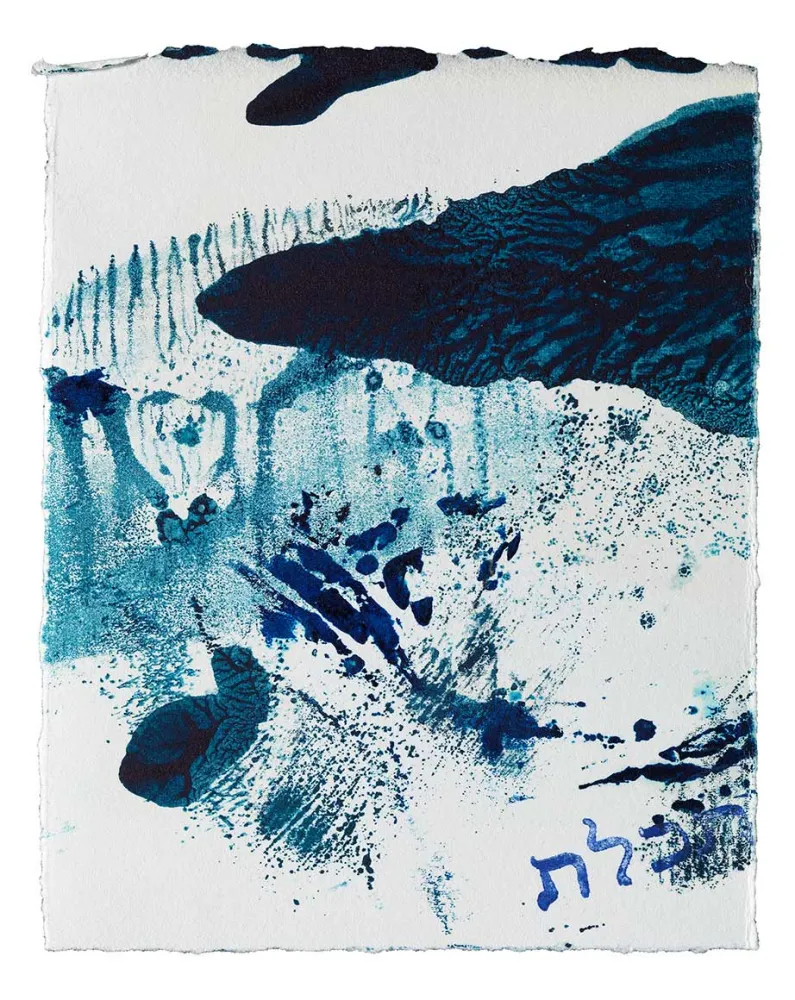
Deborah S. Phillips (lives and works in Berlin, Germany), T'chelet Fragments, lithograph, monotype & rubber stamp print, 2014; Jewish Museum Berlin, photo: Jens Ziehe.
The Colors of Light
A visit to Berlin-Neukölln, 2015, to the studio apartment of Deborah S. Phillips, who is dressed in blue today, except for her shoes, which are green. That the artist has spent the last five years examining the color blue and is only now gradually turning her attention to hues of green is reflected thus in her apparel as well as her art.
Red was the first color to which Deborah Phillips devoted herself with a passion. The Bible story she read aloud as a 12-year-old in the synagogue on the occasion of her Bat Mizwa was about the red cow—and it haunted her for ages. It was the tale of a strange animal that had to be sacrificed so people could use its ashes to cleanse themselves of sin. Only then would they be able to enter the temple in Jerusalem. Many years later, Deborah Phillip’s reflections on the color red and its cultural significance culminated in one of her enchanting works on paper, the Red Book, which is the fruit also of the artist’s extensive voyages in Iran, India and Central Asia, and her affinity with Islamic cultures.
The Fourth Book of Moses and the Blue Book
In the meantime there is a Blue Book too. On my visit I was allowed to leaf through the freshly finished art books, seven unique editions in all. Compiled therein are lithographs, monotypes, photo collages, lead-type-set text, block prints, and small drawings executed in nail varnish of every conceivable shade of blue.
Deborah Phillips’s fascination with the color blue is likewise of Biblical origin. The fourth Book of Moses bids the faithful to sew threads onto the four corners of their prayer cloak as a constant reminder of the Lord’s commandments. Some of the threads, it is said, should be dyed blue or tchelet, to use the Hebrew term. Since it was impossible to say exactly which shade of blue was meant, scholars later revoked this precept and ordained the use of white thread instead. Rabbinical discussions about tchelet occupied Deborah already when she was a girl. Nowadays, in Israel, the secular yet supernal term tchelet describes merely the color of the sky.
Artist, Spice Consultant
Colors and sounds, letters of the alphabet, spices and smells: all these flow together in Deborah Phillips’s artistic practice—and what may thereby eventually transpire is as much a mystery to her as to anyone. Her work on the Blue Book gave rise, quasi as a byproduct, to the monotypes which are available in our Art Vending Machine in the permanent exhibition at the Jewish Museum Berlin. On half of the small works-on-paper, the artist stamped a single Hebrew word, namely tchelet; on the others she stamped the word argaman. This second word means “purple,” a royal color once worn by priests in the ancient temples of Jerusalem.
In addition to her works on paper, Deborah Phillips creates films, installations and performances. She works as a translator, coordinates cultural projects, and is an excellent cook as well as a “spice consultant.”
By the way, not only colors play a major role in the (artistic) life of Deborah Phillips but also an infamous street in Neukölln, the Hermannstraße. For her mother’s maiden name was Hermann and the artist herself has lived in the Hermannstraße/ Hermannplatz neighborhood for many years. This coincidence prompted a project with the title HERMAN(N).
Colors, odors, voices and sounds, delicate, dazzling and wild, accompanied me on my way from Deborah’s studio apartment to the subway, down Hermannstraße.
Maren Krüger, Exhibitions
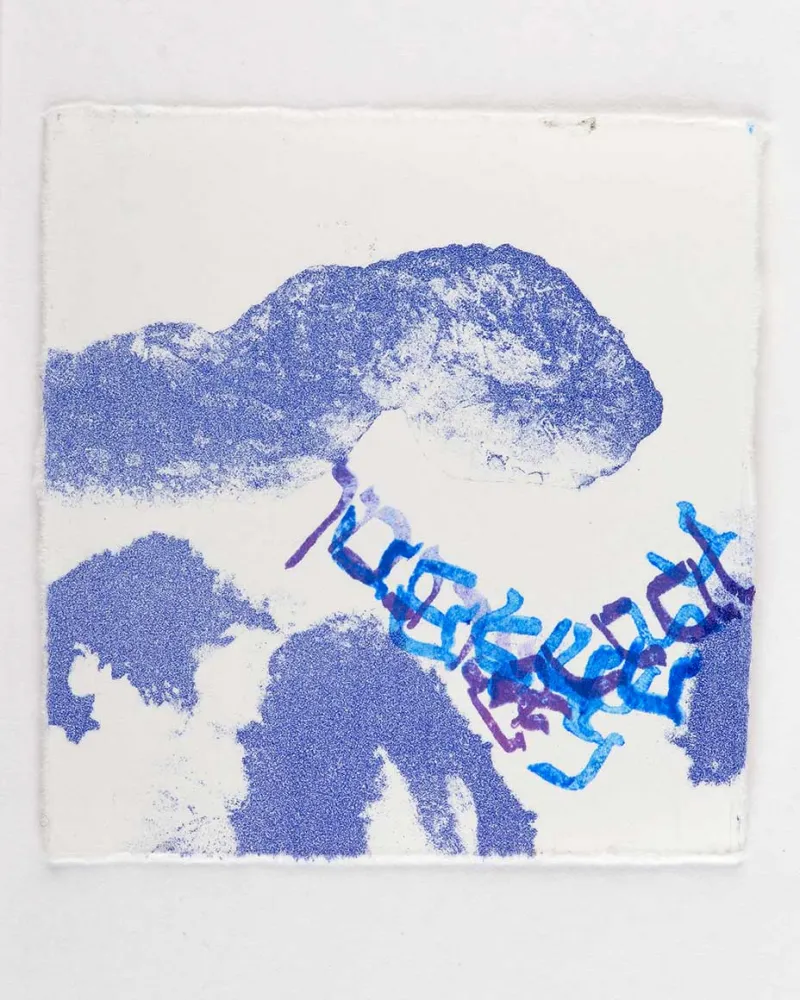
Deborah S. Phillips (lives and works in Berlin, Germany), T’chelet ve Argaman, lithograph & rubber stamp print, 2015; Jewish Museum Berlin, photo: Oliver Stratz.
The Colors of Light
A visit to Berlin-Neukölln, 2015, to the studio apartment of Deborah S. Phillips, who is dressed in blue today, except for her shoes, which are green. That the artist has spent the last five years examining the color blue and is only now gradually turning her attention to hues of green is reflected thus in her apparel as well as her art.
Red was the first color to which Deborah Phillips devoted herself with a passion. The Bible story she read aloud as a 12-year-old in the synagogue on the occasion of her Bat Mizwa was about the red cow—and it haunted her for ages. It was the tale of a strange animal that had to be sacrificed so people could use its ashes to cleanse themselves of sin. Only then would they be able to enter the temple in Jerusalem. Many years later, Deborah Phillip’s reflections on the color red and its cultural significance culminated in one of her enchanting works on paper, the Red Book, which is the fruit also of the artist’s extensive voyages in Iran, India and Central Asia, and her affinity with Islamic cultures.
The Fourth Book of Moses and the Blue Book
In the meantime there is a Blue Book too. On my visit I was allowed to leaf through the freshly finished art books, seven unique editions in all. Compiled therein are lithographs, monotypes, photo collages, lead-type-set text, block prints, and small drawings executed in nail varnish of every conceivable shade of blue.
Deborah Phillips’s fascination with the color blue is likewise of Biblical origin. The fourth Book of Moses bids the faithful to sew threads onto the four corners of their prayer cloak as a constant reminder of the Lord’s commandments. Some of the threads, it is said, should be dyed blue or tchelet, to use the Hebrew term. Since it was impossible to say exactly which shade of blue was meant, scholars later revoked this precept and ordained the use of white thread instead. Rabbinical discussions about tchelet occupied Deborah already when she was a girl. Nowadays, in Israel, the secular yet supernal term tchelet describes merely the color of the sky.
Artist, Spice Consultant
Colors and sounds, letters of the alphabet, spices and smells: all these flow together in Deborah Phillips’s artistic practice—and what may thereby eventually transpire is as much a mystery to her as to anyone. Her work on the Blue Book gave rise, quasi as a byproduct, to the monotypes which are available in our Art Vending Machine in the permanent exhibition at the Jewish Museum Berlin. On half of the small works-on-paper, the artist stamped a single Hebrew word, namely tchelet; on the others she stamped the word argaman. This second word means “purple,” a royal color once worn by priests in the ancient temples of Jerusalem.
In addition to her works on paper, Deborah Phillips creates films, installations and performances. She works as a translator, coordinates cultural projects, and is an excellent cook as well as a “spice consultant.”
By the way, not only colors play a major role in the (artistic) life of Deborah Phillips but also an infamous street in Neukölln, the Hermannstraße. For her mother’s maiden name was Hermann and the artist herself has lived in the Hermannstraße/ Hermannplatz neighborhood for many years. This coincidence prompted a project with the title HERMAN(N).
Colors, odors, voices and sounds, delicate, dazzling and wild, accompanied me on my way from Deborah’s studio apartment to the subway, down Hermannstraße.
Maren Krüger, Exhibitions
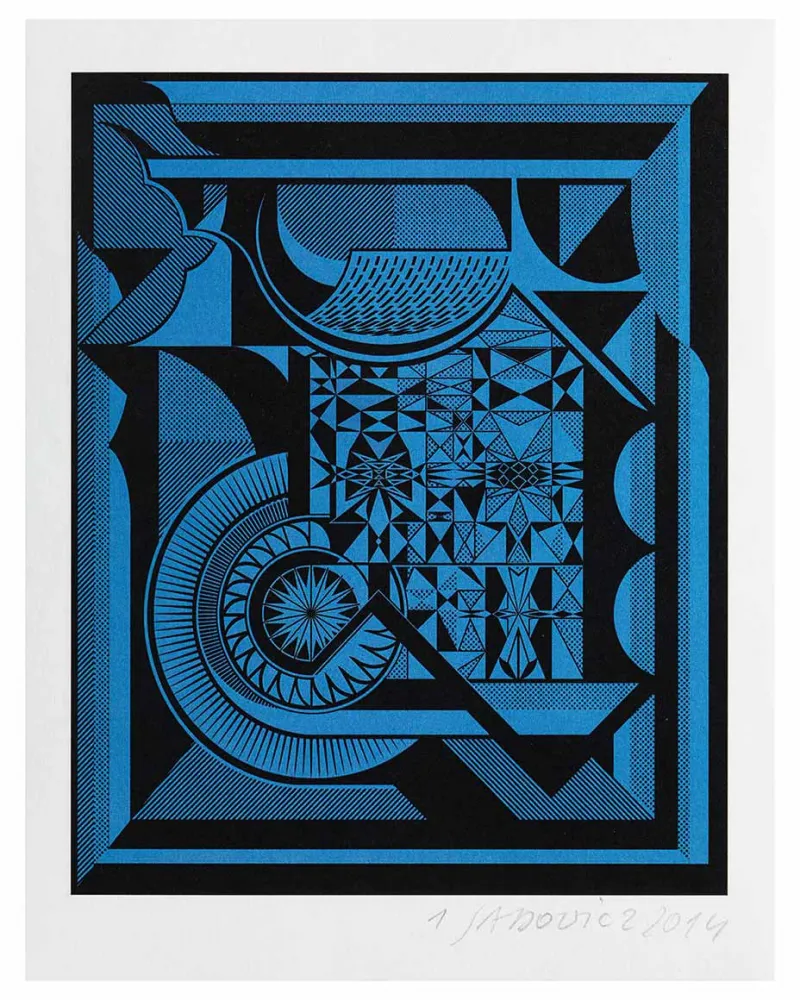
Georg Sadowicz (born in Legnica, Poland, 1972), The Mill, offset print, 2014; Jewish Museum Berlin, photo: Jens Ziehe.
Escaping the Escape Points
I’m meeting Georg Sadowicz in his atelier in Berlin-Hohenschönhausen. The Berlin-based artist was born in Liegnitz, Poland, on the German border. In 2015, two of his pieces – precursors to larger work – were made available to visitors as a limited run in the Jewish Museum Berlin’s art vending machine. They are titled, The Cantor and The Mill. Sadowicz’s atelier is a mere hundred meters from the grounds of a former Stasi detention center, now a memorial site. The sight of it troubles me, but the unease vanishes as soon as I step into Sadowicz’s atelier.
Georg Sadowicz has an eventful life story. When he was 16, his family moved from Poland to Nuremberg in West Germany. He went onto study visual arts in Dresden and was a protégé to Ralf Kerbach, who taught at the College of Visual Arts, Painting and Graphic Design there. Max Uhlig was also a major influence on Sadowicz, serving as his mentor and supporter. Moving to Berlin permanently around the year 2000, he found the artistic and financial possibilities he couldn’t in other cities.
Immediately following his studies, Sadowicz focused first on painting then on linoleum cuts. Each image in the creation of a linoleum cut goes through a complex production process from the first template to the negative cutter in the material to its final coloring. The result isn’t always predictable: “Some templates have been lying around my atelier for more than a year while others seem to fail through the course of printing. You could compare the emergence of my work to a game of chess. I plan the moves in advance and want to win. But they could be wrong. You don’t know until the end of the game,
” Sadowicz says about the difficulties inherent to the process, adding that he learns a great deal from failure.
Linoleum cuts inform his general approach to art. With the exception of the works made available for the art vending machine – offset prints based on smaller linoleum cuts – the artist mostly deals in large-format cuts. For Sadowicz, it’s important that the “common perspective of spatial constructs of classical art doesn’t apply when viewing it.
” He is constantly questioning the traditional separation of foreground, middle ground and background. This is evident in most of his work, in that it does not contain an escape point. “I organize all the elements in a rhythmic repeating interplay so space remains ambivalent. A great deal is happening at the same time on all three levels: fore, back and middle.
” This gives the appearance that many forms are part of a larger whole, which in turn seems to be further subdivided into more detailed scenes and symbols. Such is also the case with Sadowicz’s small-format works in the art vending machine.
My interesting visit to Sadowicz’s atelier lingers in my thoughts, not least of all because he’s given me insight into the precarious situation for many Berlin-based artists. Sadowicz told me of his former atelier in Kreuzberg, which over time became too expensive. His move to the factory building in Hohenschönhausen is emblematic of the relocation of Berlin’s artists from the center to its outskirts.
Kilian Gärtner, Jewish Places
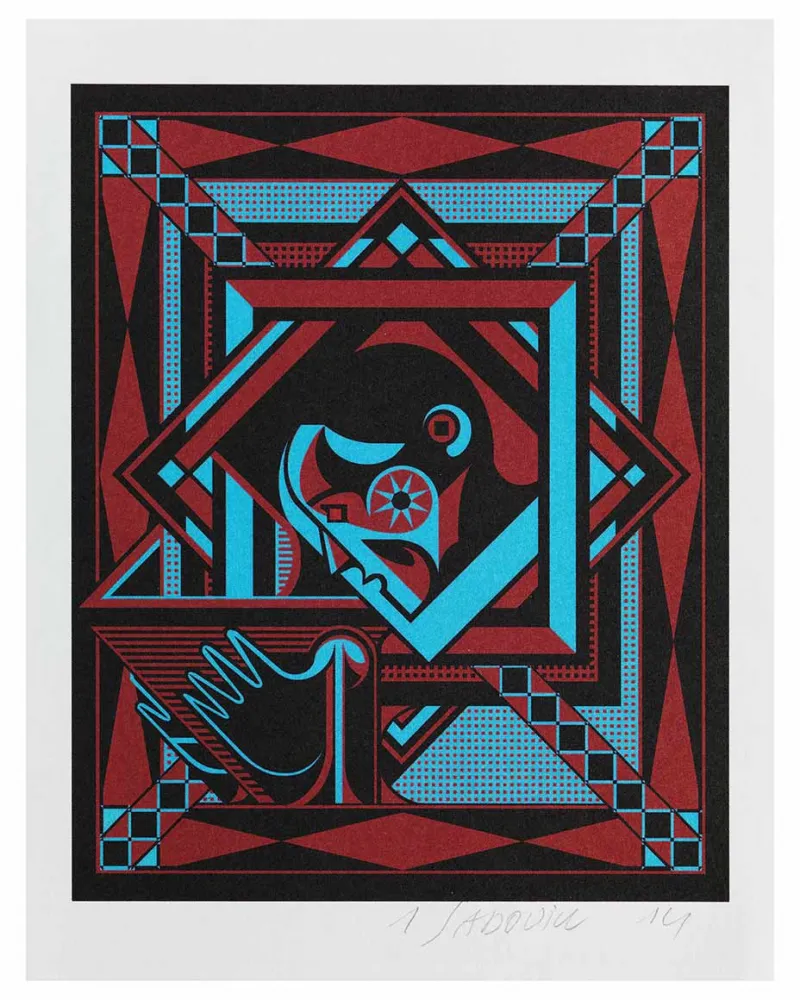
Georg Sadowicz (born in Legnica, Poland, 1972), The Prayer Leader, offset print, 2014; Jewish Museum Berlin, photo: Jens Ziehe.
Escaping the Escape Points
I’m meeting Georg Sadowicz in his atelier in Berlin-Hohenschönhausen. The Berlin-based artist was born in Liegnitz, Poland, on the German border. In 2015, two of his pieces – precursors to larger work – were made available to visitors as a limited run in the Jewish Museum Berlin’s art vending machine. They are titled, The Cantor and The Mill. Sadowicz’s atelier is a mere hundred meters from the grounds of a former Stasi detention center, now a memorial site. The sight of it troubles me, but the unease vanishes as soon as I step into Sadowicz’s atelier.
Georg Sadowicz has an eventful life story. When he was 16, his family moved from Poland to Nuremberg in West Germany. He went onto study visual arts in Dresden and was a protégé to Ralf Kerbach, who taught at the College of Visual Arts, Painting and Graphic Design there. Max Uhlig was also a major influence on Sadowicz, serving as his mentor and supporter. Moving to Berlin permanently around the year 2000, he found the artistic and financial possibilities he couldn’t in other cities.
Immediately following his studies, Sadowicz focused first on painting then on linoleum cuts. Each image in the creation of a linoleum cut goes through a complex production process from the first template to the negative cutter in the material to its final coloring. The result isn’t always predictable: “Some templates have been lying around my atelier for more than a year while others seem to fail through the course of printing. You could compare the emergence of my work to a game of chess. I plan the moves in advance and want to win. But they could be wrong. You don’t know until the end of the game,
” Sadowicz says about the difficulties inherent to the process, adding that he learns a great deal from failure.
Linoleum cuts inform his general approach to art. With the exception of the works made available for the art vending machine – offset prints based on smaller linoleum cuts – the artist mostly deals in large-format cuts. For Sadowicz, it’s important that the “common perspective of spatial constructs of classical art doesn’t apply when viewing it.
” He is constantly questioning the traditional separation of foreground, middle ground and background. This is evident in most of his work, in that it does not contain an escape point. “I organize all the elements in a rhythmic repeating interplay so space remains ambivalent. A great deal is happening at the same time on all three levels: fore, back and middle.
” This gives the appearance that many forms are part of a larger whole, which in turn seems to be further subdivided into more detailed scenes and symbols. Such is also the case with Sadowicz’s small-format works in the art vending machine.
My interesting visit to Sadowicz’s atelier lingers in my thoughts, not least of all because he’s given me insight into the precarious situation for many Berlin-based artists. Sadowicz told me of his former atelier in Kreuzberg, which over time became too expensive. His move to the factory building in Hohenschönhausen is emblematic of the relocation of Berlin’s artists from the center to its outskirts.
Kilian Gärtner, Jewish Places
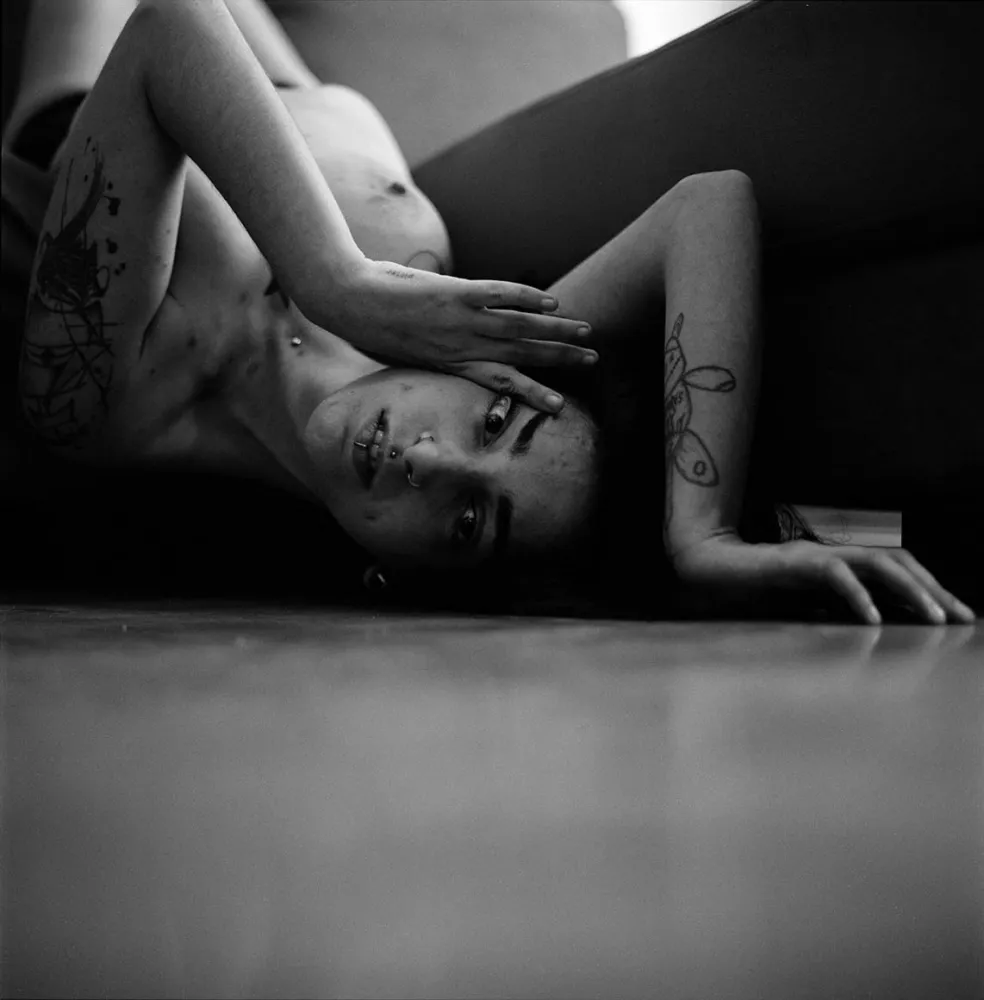
Hadas Tapouchi (born in Mosav Beit Nehemia, Israel, 1981), Daniel, Photograph from the series Third Generation, 2013, stamped; Jewish Museum Berlin.
Art Against Forgetting
History cannot be captured in a single form. Not in brass, not in metal. That is what Hadas Tapouchi says. The Berlin-based Israeli artist believes that monuments and inscriptions miss the actual sense of commemoration. This type of remembrance would be an inevitable path towards forgetting.
Undoubtedly, Hadas works against forgetting. Upon our first meeting at her Tel Aviv apartment around 2011, the artist’s rendered self-portrait in prisoner’s garb immediately jumped out at me. It was one of the precursors to her project, The Third Generation. A countless number of portraits since followed – portraits of mutual friends, the author himself, as well as young men and women between Berlin, Tel Aviv and Ramallah.
How We Look Back
Until today, Hadas’s high demand for memory is palpable in her work. Her earliest series, Transforming, focuses on NS forced labor in and around Berlin. There, along with the project’s supplementary website, she exposes an uncanny tension between the presence and absence of history. However, she does not want this work to be compared to Gunter Demnig’s well-known Stolperstein (stumbling stones) project. “This isn’t about a single stone!”
she answered me recently, in fiery English and with raised arms, at a joint event (in the Berlin gallery, Werkraum Bild & Sinn). This seems to be her main concern, the general focus of her work: Hadas wants nothing less than to change the very way we view the present as well as the future.
The foundation of this approach is instilled in The Third Generation. Instead of static commemoration, she puts faces in the foreground. “The two works complement each other,
” Hadas explained on the same evening. Further, it would be important to regard them as one. However, The Third Generation is far from completion. Tapouchi sees it as a “work in progress”.
Both projects begin with Hadas’s own biography. Her grandmother, a Shoah survivor from Poland, gave little account of those years. The shadow of this experience spread over the artist’s mother like a lead blanket. From an early age, Hadas understood her role as a representative of the third generation of victims of the Shoah.
The Mutual Pull of the Third Generation
The realization that there could also be a third generation in Germany – those of her age, affected by a similar type of silence about the past – didn’t occur to her until later. Then she began photographing people in Berlin about six years ago. “I was curious if the people there even saw themselves as a third generation,”
she recalled. She’s yet to find a clear answer to that question. The intense pull between young Germans and Israelis today is an indication for two generation’s bonds that can be extended to young Palestinians – those in Israel as well as in their Diaspora – too, Hadas says.
That those portrayed appear strangely familiar is what allows those contrasting histories to be assembled into a single collage. Clearly, the unifying factor is sexuality – that is, queer sexuality, which extends beyond the (hetero)norm. “The community I focus on in
The Third Generation
is influenced foremost by the queer community.
”
Similarities Rather than Differences
The historical background – the Shoah as it affects descendants of its victims and perpetrators, as well as the Nakba (the Arabic word for “catastrophe”, used for the Palestinian displacement at the time of the Israeli independence war) – is amended by personal histories and thereby undermines rigid narratives. “The camera’s changing resolution allows me to bring out their similarities rather than their differences,
” Hadas explains.
No doubt this is a controversial approach. If one wanted to describe the status quo of Israel’s commemoration policy in two words, it would be, “Al Tisch’we!” (don’t compare). In other words, the Shoah cannot be compared to any other historical event.“I hear this criticism all the time,
” Tapouchi complains. “But I was never after a comparison!
” Rather, her goal was to present what Israelis, Palestinians and Germans in the Third Generation have in common. Nevertheless, this strikes many as a radical statement. In Israel, Hadas says with a hint of resignation, commemoration first and foremost serves the national consciousness. Most people simply would not think.
Which Forms of Remembrance Are Allowed?
It’s an observation that could probably, to a certain degree, be applied to Germany, as well. Certainly, The Third Generation targets sensitive questions: What exactly does “remembrance” mean 70 years after the Shoah, and nearly 70 years after the foundation of the State of Israel and the Federal Republic of Germany? Who remembers and out of which motivation? How does remembrance change over time? Which forms of remembrance are allowed? Which are forbidden?
Today, Hadas is primarily eager to see how The Third Generation will develop. Sometimes she wonders if, 10 or 20 years from now, her project might seem ridiculous, even cliché. Or, on the contrary, if it might lead the way to a new type of commemoration. She is curious how the Shoah’s fourth generation will react, or the fifth; the series won’t lose its relevance anytime soon. That much is certain.
Hanno Hauenstein, Exhibitions
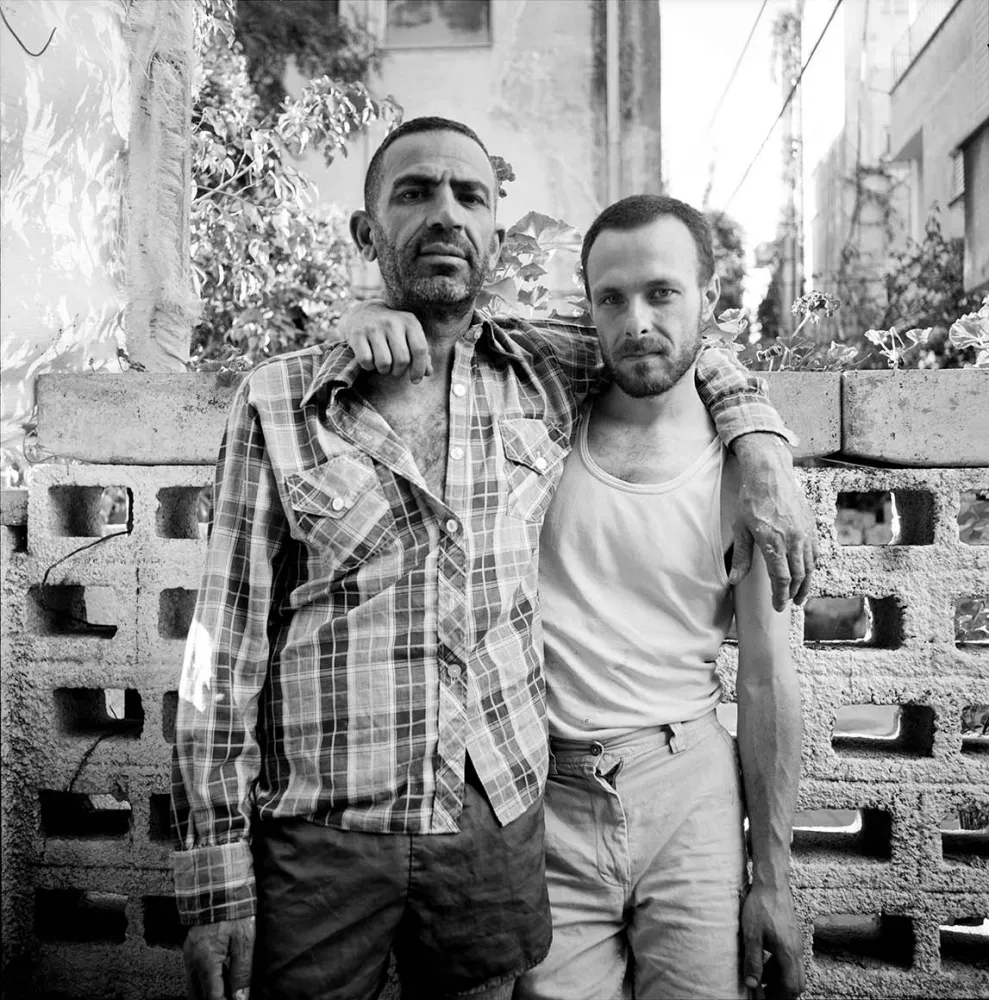
Hadas Tapouchi (born in Mosav Beit Nehemia, Israel, 1981), Tomer and Haled, Photograph from the series Third Generation, 2013, stamped; Jewish Museum Berlin.
Art Against Forgetting
History cannot be captured in a single form. Not in brass, not in metal. That is what Hadas Tapouchi says. The Berlin-based Israeli artist believes that monuments and inscriptions miss the actual sense of commemoration. This type of remembrance would be an inevitable path towards forgetting.
Undoubtedly, Hadas works against forgetting. Upon our first meeting at her Tel Aviv apartment around 2011, the artist’s rendered self-portrait in prisoner’s garb immediately jumped out at me. It was one of the precursors to her project, The Third Generation. A countless number of portraits since followed – portraits of mutual friends, the author himself, as well as young men and women between Berlin, Tel Aviv and Ramallah.
How We Look Back
Until today, Hadas’s high demand for memory is palpable in her work. Her earliest series, Transforming, focuses on NS forced labor in and around Berlin. There, along with the project’s supplementary website, she exposes an uncanny tension between the presence and absence of history. However, she does not want this work to be compared to Gunter Demnig’s well-known Stolperstein (stumbling stones) project. “This isn’t about a single stone!”
she answered me recently, in fiery English and with raised arms, at a joint event (in the Berlin gallery, Werkraum Bild & Sinn). This seems to be her main concern, the general focus of her work: Hadas wants nothing less than to change the very way we view the present as well as the future.
The foundation of this approach is instilled in The Third Generation. Instead of static commemoration, she puts faces in the foreground. “The two works complement each other,
” Hadas explained on the same evening. Further, it would be important to regard them as one. However, The Third Generation is far from completion. Tapouchi sees it as a “work in progress”.
Both projects begin with Hadas’s own biography. Her grandmother, a Shoah survivor from Poland, gave little account of those years. The shadow of this experience spread over the artist’s mother like a lead blanket. From an early age, Hadas understood her role as a representative of the third generation of victims of the Shoah.
The Mutual Pull of the Third Generation
The realization that there could also be a third generation in Germany – those of her age, affected by a similar type of silence about the past – didn’t occur to her until later. Then she began photographing people in Berlin about six years ago. “I was curious if the people there even saw themselves as a third generation,”
she recalled. She’s yet to find a clear answer to that question. The intense pull between young Germans and Israelis today is an indication for two generation’s bonds that can be extended to young Palestinians – those in Israel as well as in their Diaspora – too, Hadas says.
That those portrayed appear strangely familiar is what allows those contrasting histories to be assembled into a single collage. Clearly, the unifying factor is sexuality – that is, queer sexuality, which extends beyond the (hetero)norm. “The community I focus on in
The Third Generation
is influenced foremost by the queer community.
”
Similarities Rather than Differences
The historical background – the Shoah as it affects descendants of its victims and perpetrators, as well as the Nakba (the Arabic word for “catastrophe”, used for the Palestinian displacement at the time of the Israeli independence war) – is amended by personal histories and thereby undermines rigid narratives. “The camera’s changing resolution allows me to bring out their similarities rather than their differences,
” Hadas explains.
No doubt this is a controversial approach. If one wanted to describe the status quo of Israel’s commemoration policy in two words, it would be, “Al Tisch’we!” (don’t compare). In other words, the Shoah cannot be compared to any other historical event.“I hear this criticism all the time,
” Tapouchi complains. “But I was never after a comparison!
” Rather, her goal was to present what Israelis, Palestinians and Germans in the Third Generation have in common. Nevertheless, this strikes many as a radical statement. In Israel, Hadas says with a hint of resignation, commemoration first and foremost serves the national consciousness. Most people simply would not think.
Which Forms of Remembrance Are Allowed?
It’s an observation that could probably, to a certain degree, be applied to Germany, as well. Certainly, The Third Generation targets sensitive questions: What exactly does “remembrance” mean 70 years after the Shoah, and nearly 70 years after the foundation of the State of Israel and the Federal Republic of Germany? Who remembers and out of which motivation? How does remembrance change over time? Which forms of remembrance are allowed? Which are forbidden?
Today, Hadas is primarily eager to see how The Third Generation will develop. Sometimes she wonders if, 10 or 20 years from now, her project might seem ridiculous, even cliché. Or, on the contrary, if it might lead the way to a new type of commemoration. She is curious how the Shoah’s fourth generation will react, or the fifth; the series won’t lose its relevance anytime soon. That much is certain.
Hanno Hauenstein, Exhibitions
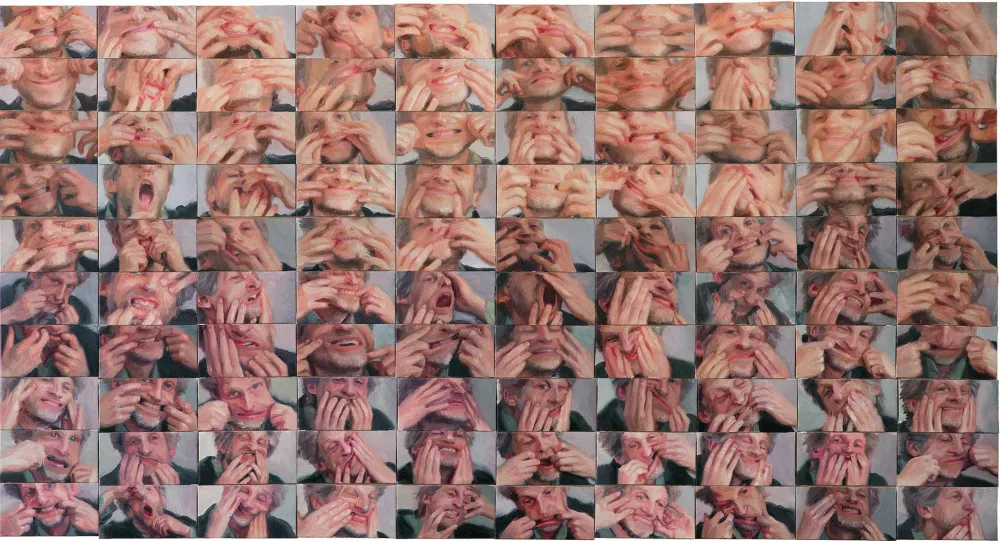
Daniel Wiesenfeld (born in Buffalo, NY, USA, 1969), SMILE, 2014; photo: Detlef Baltrock.
A Conversation with Daniel Wiesenfeld, August 2015
During July and August 2015, as people everywhere were sizzling in the summer sun, Daniel Wiesenfeld was ‘baking’ a hundred new works of art for our art vending machine. What good luck, as meanwhile the machine is nearly sold out!
Daniel presented the Jewish Museum Berlin with what was already the third series of works for the vending machine, all three of which are incomparable. In April we received a hundred oil paintings with self-portraits of the artist bearing a variety of poignant grimaces, along with a hundred charcoal drawings featuring a number of different motifs. For this new series, Daniel decided on a technique that’s new not only for him but for the vending machine as well: stained glass.
Working With Glass in Tempelhof
For this interview I visited Daniel in Berlin’s Tempelhof neighborhood. He was able to use an electric kiln (indispensible for glass) here at the workshop of someone he knows. You have to heat the glass up incrementally to 650°C (1202°F) in order to fire it with colors, which Daniel had told me beforehand. It was an oppressively warm morning, so I was relieved when he said that he only runs the oven at night. The nightly firing was just finished and I could see the ‘freshly baked’ glass plates cooling off in the oven. More small glass panes were spread across a table. They feature views into dark interiors, a living room, a kitchen, a bedroom. In some of the pictures you can also see single objects or pieces of furniture: a rocking chair, a side table with a flower vase, and a stately canopy bed. There are no people. A bed, a chair, a table is the title of this series of unique handmade works.
Light and Black Stain
There’s a sealed jar with black powder on the table. The label on it shows a skull and crossbones and other warning symbols. Daniel produces his stained glass art out of conventional windowpane glass, which he paints with black stain. Black stain is a dye powder that contained lead oxide in its original form and was already being used for stained glass in the medieval period. It’s seldom used today, however, and Daniel had to search long and hard to find a lead-free formula.
The aesthetic effect of the black stain is revealed by the light. The rooms on the glass look to me like images from another era – like old, slightly-faded, black and white photographs. This association is intentional. Daniel consciously turned for motifs to historical interior views with echoes of the Belle Époque. And not only the motifs come from the past; the artificial ‘weathering process’ he puts the images through add to the effect. With a variety of techniques, Daniel generates the result that the rooms look mysterious, almost ghostly, as if behind a fine veil.
Human Presence in the "Glass Interior"
As we spoke, he explained that it’s particularly important to him that the rooms look lived-in but don’t reveal any actual people. “The people aren’t there anymore, but these rooms allow you to surmise something about their different stories. The presence of people still reverberates in the rooms like an echo.”
The human presence in a painting is a central theme in Daniel Wiesenfeld’s work. Not surprising, when you recall that he’s primarily known as a portrait painter. Many of his portraits were commissioned, a selection can be seen on his homepage. Daniel states: “Portraits have fascinated me since childhood – paintings that respond to your gaze, with a likeness that seems to offer you an animated counterpart. With my own portraits it’s important to me, beyond the superficial rendering of resemblance, to allow a deeper insight into the character of my subject.”
The Artist's Background
Daniel was born in the USA and grew up in Bavaria. He studied art, with an emphasis on painting, at the Academy of Fine Arts in Munich and at Queens College in New York. He has lived with his family since 2000 in Berlin. While working on this collection, he’s been in close contact with the curators of the permanent exhibition where the art vending machine can be found. “A project like the art vending machine prompts you to grapple with the work more intensively,”
Daniel thinks. And so one project leads to another. Inspired by the first glass panes of the series A bed, a chair, a table, Daniel created an installation of the same name which became part of the exhibition Black & White at HilbertRaum. The “glass interiors” were attached to a table on nylon threads hanging from the ceiling overhead. Like glass wind chimes that, depending on the incidence of light, reveal to the viewer another room altogether.
Before leaving Daniel and stepping out into the broiling midday sun, I get to hear about his latest project, a combination of oil painting and stained glass. He names some of the key points: three-dimensionality, perspective, lighting effects. It sounds really interesting. “I have very many ideas,”
he says. “I think it has a lot of potential.”
Anna Golus, Collection Management
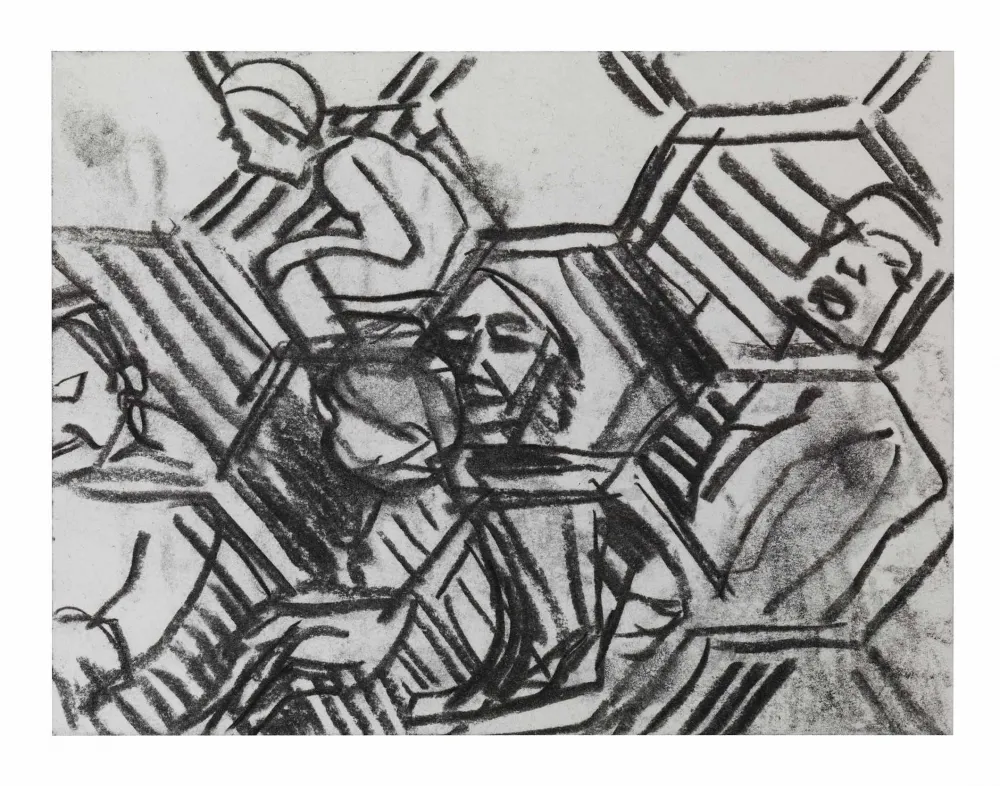
Daniel Wiesenfeld (born in Buffalo, NY, USA, 1969), Charcoal drawings, drawing with charcoal on both sides of the pages of small sketchbooks, 2014; Jewish Museum Berlin, photo: Jens Ziehe.
A Conversation with Daniel Wiesenfeld, August 2015
During July and August 2015, as people everywhere were sizzling in the summer sun, Daniel Wiesenfeld was ‘baking’ a hundred new works of art for our art vending machine. What good luck, as meanwhile the machine is nearly sold out!
Daniel presented the Jewish Museum Berlin with what was already the third series of works for the vending machine, all three of which are incomparable. In April we received a hundred oil paintings with self-portraits of the artist bearing a variety of poignant grimaces, along with a hundred charcoal drawings featuring a number of different motifs. For this new series, Daniel decided on a technique that’s new not only for him but for the vending machine as well: stained glass.
Working With Glass in Tempelhof
For this interview I visited Daniel in Berlin’s Tempelhof neighborhood. He was able to use an electric kiln (indispensible for glass) here at the workshop of someone he knows. You have to heat the glass up incrementally to 650°C (1202°F) in order to fire it with colors, which Daniel had told me beforehand. It was an oppressively warm morning, so I was relieved when he said that he only runs the oven at night. The nightly firing was just finished and I could see the ‘freshly baked’ glass plates cooling off in the oven. More small glass panes were spread across a table. They feature views into dark interiors, a living room, a kitchen, a bedroom. In some of the pictures you can also see single objects or pieces of furniture: a rocking chair, a side table with a flower vase, and a stately canopy bed. There are no people. A bed, a chair, a table is the title of this series of unique handmade works.
Light and Black Stain
There’s a sealed jar with black powder on the table. The label on it shows a skull and crossbones and other warning symbols. Daniel produces his stained glass art out of conventional windowpane glass, which he paints with black stain. Black stain is a dye powder that contained lead oxide in its original form and was already being used for stained glass in the medieval period. It’s seldom used today, however, and Daniel had to search long and hard to find a lead-free formula.
The aesthetic effect of the black stain is revealed by the light. The rooms on the glass look to me like images from another era – like old, slightly-faded, black and white photographs. This association is intentional. Daniel consciously turned for motifs to historical interior views with echoes of the Belle Époque. And not only the motifs come from the past; the artificial ‘weathering process’ he puts the images through add to the effect. With a variety of techniques, Daniel generates the result that the rooms look mysterious, almost ghostly, as if behind a fine veil.
Human Presence in the "Glass Interior"
As we spoke, he explained that it’s particularly important to him that the rooms look lived-in but don’t reveal any actual people. “The people aren’t there anymore, but these rooms allow you to surmise something about their different stories. The presence of people still reverberates in the rooms like an echo.”
The human presence in a painting is a central theme in Daniel Wiesenfeld’s work. Not surprising, when you recall that he’s primarily known as a portrait painter. Many of his portraits were commissioned, a selection can be seen on his homepage. Daniel states: “Portraits have fascinated me since childhood – paintings that respond to your gaze, with a likeness that seems to offer you an animated counterpart. With my own portraits it’s important to me, beyond the superficial rendering of resemblance, to allow a deeper insight into the character of my subject.”
The Artist's Background
Daniel was born in the USA and grew up in Bavaria. He studied art, with an emphasis on painting, at the Academy of Fine Arts in Munich and at Queens College in New York. He has lived with his family since 2000 in Berlin. While working on this collection, he’s been in close contact with the curators of the permanent exhibition where the art vending machine can be found. “A project like the art vending machine prompts you to grapple with the work more intensively,”
Daniel thinks. And so one project leads to another. Inspired by the first glass panes of the series A bed, a chair, a table, Daniel created an installation of the same name which became part of the exhibition Black & White at HilbertRaum. The “glass interiors” were attached to a table on nylon threads hanging from the ceiling overhead. Like glass wind chimes that, depending on the incidence of light, reveal to the viewer another room altogether.
Before leaving Daniel and stepping out into the broiling midday sun, I get to hear about his latest project, a combination of oil painting and stained glass. He names some of the key points: three-dimensionality, perspective, lighting effects. It sounds really interesting. “I have very many ideas,”
he says. “I think it has a lot of potential.”
Anna Golus, Collection Management
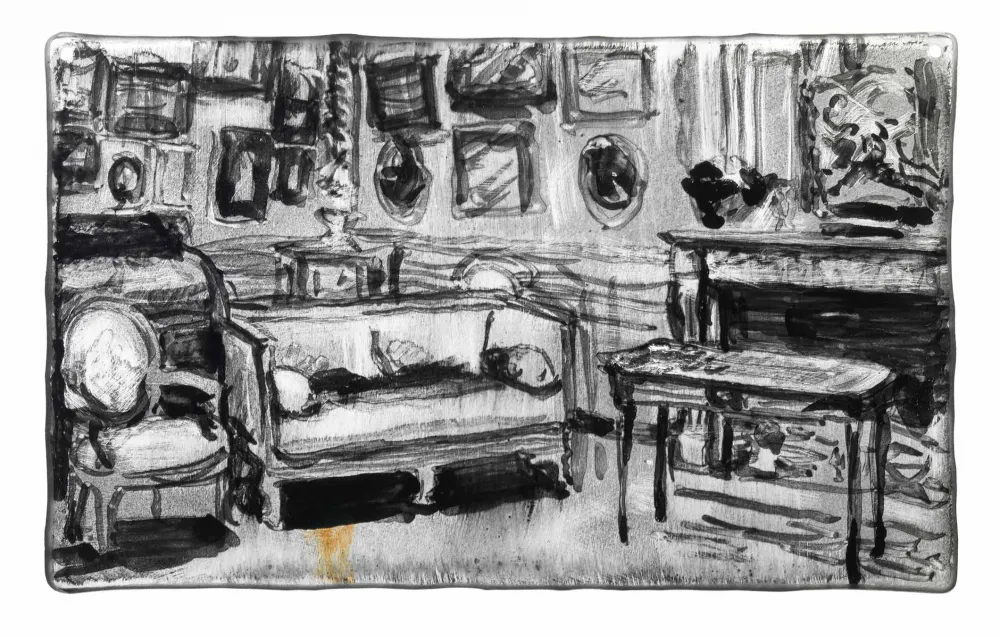
Daniel Wiesenfeld (born in Buffalo, NY, USA, 1969), A Bed, a Chair, a Table; Jewish Museum Berlin, photo: Jens Ziehe With Daniel Wiesenfeld's third series for the art vending machine A Bed, a Chair, a Table
A Conversation with Daniel Wiesenfeld, August 2015
During July and August 2015, as people everywhere were sizzling in the summer sun, Daniel Wiesenfeld was ‘baking’ a hundred new works of art for our art vending machine. What good luck, as meanwhile the machine is nearly sold out!
Daniel presented the Jewish Museum Berlin with what was already the third series of works for the vending machine, all three of which are incomparable. In April we received a hundred oil paintings with self-portraits of the artist bearing a variety of poignant grimaces, along with a hundred charcoal drawings featuring a number of different motifs. For this new series, Daniel decided on a technique that’s new not only for him but for the vending machine as well: stained glass.
Working With Glass in Tempelhof
For this interview I visited Daniel in Berlin’s Tempelhof neighborhood. He was able to use an electric kiln (indispensible for glass) here at the workshop of someone he knows. You have to heat the glass up incrementally to 650°C (1202°F) in order to fire it with colors, which Daniel had told me beforehand. It was an oppressively warm morning, so I was relieved when he said that he only runs the oven at night. The nightly firing was just finished and I could see the ‘freshly baked’ glass plates cooling off in the oven. More small glass panes were spread across a table. They feature views into dark interiors, a living room, a kitchen, a bedroom. In some of the pictures you can also see single objects or pieces of furniture: a rocking chair, a side table with a flower vase, and a stately canopy bed. There are no people. A bed, a chair, a table is the title of this series of unique handmade works.
Light and Black Stain
There’s a sealed jar with black powder on the table. The label on it shows a skull and crossbones and other warning symbols. Daniel produces his stained glass art out of conventional windowpane glass, which he paints with black stain. Black stain is a dye powder that contained lead oxide in its original form and was already being used for stained glass in the medieval period. It’s seldom used today, however, and Daniel had to search long and hard to find a lead-free formula.
The aesthetic effect of the black stain is revealed by the light. The rooms on the glass look to me like images from another era – like old, slightly-faded, black and white photographs. This association is intentional. Daniel consciously turned for motifs to historical interior views with echoes of the Belle Époque. And not only the motifs come from the past; the artificial ‘weathering process’ he puts the images through add to the effect. With a variety of techniques, Daniel generates the result that the rooms look mysterious, almost ghostly, as if behind a fine veil.
Human Presence in the "Glass Interior"
As we spoke, he explained that it’s particularly important to him that the rooms look lived-in but don’t reveal any actual people. “The people aren’t there anymore, but these rooms allow you to surmise something about their different stories. The presence of people still reverberates in the rooms like an echo.”
The human presence in a painting is a central theme in Daniel Wiesenfeld’s work. Not surprising, when you recall that he’s primarily known as a portrait painter. Many of his portraits were commissioned, a selection can be seen on his homepage. Daniel states: “Portraits have fascinated me since childhood – paintings that respond to your gaze, with a likeness that seems to offer you an animated counterpart. With my own portraits it’s important to me, beyond the superficial rendering of resemblance, to allow a deeper insight into the character of my subject.”
The Artist's Background
Daniel was born in the USA and grew up in Bavaria. He studied art, with an emphasis on painting, at the Academy of Fine Arts in Munich and at Queens College in New York. He has lived with his family since 2000 in Berlin. While working on this collection, he’s been in close contact with the curators of the permanent exhibition where the art vending machine can be found. “A project like the art vending machine prompts you to grapple with the work more intensively,”
Daniel thinks. And so one project leads to another. Inspired by the first glass panes of the series A bed, a chair, a table, Daniel created an installation of the same name which became part of the exhibition Black & White at HilbertRaum. The “glass interiors” were attached to a table on nylon threads hanging from the ceiling overhead. Like glass wind chimes that, depending on the incidence of light, reveal to the viewer another room altogether.
Before leaving Daniel and stepping out into the broiling midday sun, I get to hear about his latest project, a combination of oil painting and stained glass. He names some of the key points: three-dimensionality, perspective, lighting effects. It sounds really interesting. “I have very many ideas,”
he says. “I think it has a lot of potential.”
Anna Golus, Collection Management
August–October 2014
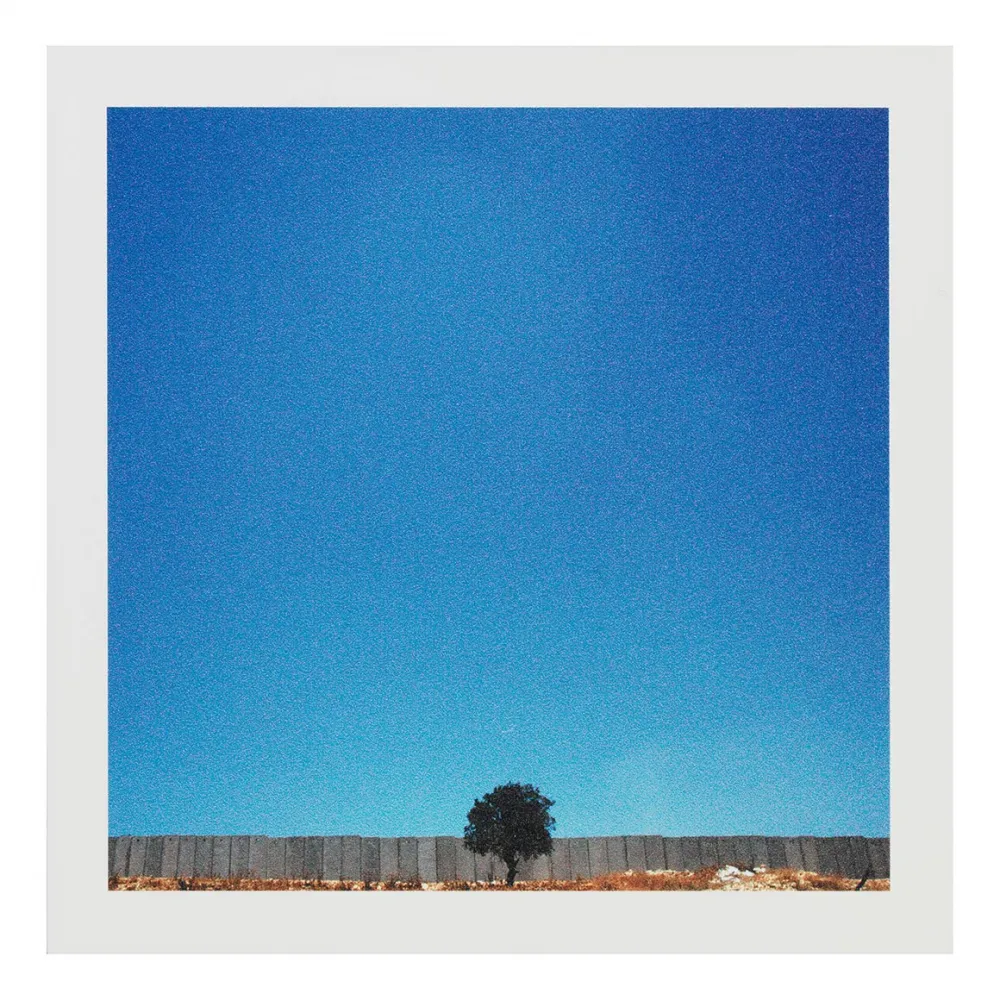
Ruthe Zuntz (born in Haifa, Israel, 1971), 9 m from the PHOTOMAT: Challenging WallMAT series, Israel/Berlin, photoprint on aluminium Dibond, 2013-2014; Jewish Museum Berlin.
Photographs that peel away the masks – A conversation with Ruthe Zuntz
In December 2014, less than three months after our art vending machine was filled with another 1,400 commissioned art objects, it was already sold out. Visitors to the museum might have pulled a picture by Ruthe Zuntz from the machine. Pieces from her PHOTOMAT: Challenging WallMAT series, as the photographer entitled her square Dibond aluminum prints which cover ten different motifs, could be sparkling in many new households – like Ruthe herself whom I recently met.
Alice Lanzke: Ruthe, you’re actually known for large, space-filling installations. And yet, for the art vending machine you produced a series of small photo prints. How did that happen?
Ruthe Zuntz: I found the project really exciting because it matches one of my basic philosophies: art can do so much to move and help change things. Because of the art vending machine, people now have the chance to take a fragment of my work home with them – a piece of “takeout” art.
Alice Lanzke: The pictures in your series for the art vending machine, PHOTOMAT: Challenging WallMAT, originated from your 2007 project, Challenging Walls, where you projected photographs from Israel, Palestine, Northern Ireland, Cyprus, and Germany onto a piece of the wall that separates Israel from the West Bank. Could you tell our readers something about that project? We have some experience with walls here in Germany…
Ruthe Zuntz: I was here in Berlin for the first time shortly before the Wall fell, prior to moving here permanently in 1991. At that time I thought the era of walls was finally over – I was so glad! And then in 2003 the wall in Israel was built. One can see it as protection, but one can also read it differently: it separates people from one another, friends and enemies both. Together with other artists, I played with the wall, using it as a ‘silver screen’. This is another connection to the pictures I created for the art vending machine! They’re printed on silver plates – like the silver screen. (Laughs.)
Alice Lanzke: What did you want to achieve with Challenging Walls?
Ruthe Zuntz: The idea for the project occurred to me first in 2003, at a time when there were a number of terror attacks in my home country, Israel. I was already living in Berlin, but friends from Israel called me often, sounding more and more desperate. I couldn’t just stand by and watch anymore. I wondered what I, as one little artist, could do to create a spark of hope and peace. Gradually I developed Challenging Walls: it was about showing what everyday life looks like for people who are separated by walls. Artists from Israel and Palestine shot photos of completely everyday scenes on each side of the wall, and in this way opened up a window. To give a more universal perspective, artists from Europe (Northern Ireland, Cyprus, and Germany) were also invited to contribute their views on walls and how we live life with them.
Alice Lanzke: The result was an enormous multimedia production on a segment on the wall…
Ruthe Zuntz: …when I saw it for the first time, after all the long hard work involved, I was very moved. Many people told me beforehand that the project would fail, that I wouldn’t get the necessary permits let alone find a Palestinian photographer. But everything worked! The Palestinian photographer has even become a good friend of mine – he lives across the street from me now. So we really did break down walls. (Laughs.)
Alice Lanzke: In the ten photos from Israel that you chose for the art vending machine, the diversity of your motifs is striking: there are pictures that come across as very melancholy, almost mournful, and then there are some that show their own kind of sparkling wit…
Ruthe Zuntz: These are the various sides of the country. When you talk about melancholy, you must mean the picture with the old woman sitting in the hair salon…This woman really touched me – she looks like she’s been waiting for years for something to happen, but it hasn’t.
Alice Lanzke: What’s the significance of the picture of the laundry blowing in the wind?
Ruthe Zuntz: Laundry is an interesting subject for me. The first summer I spent in Berlin, I was fascinated by people’s behavior here: there were people lying in the sun in a park in the middle of the big city – naked. Israelis and Palestinians would never do that. Instead though, we hang our most intimate laundry outside to dry.
Alice Lanzke: What was it like for you, aside from the nudity, to move to Berlin?
Ruthe Zuntz: Coming here, I basically brought my father’s life full circle. On my paternal side I’m 16th generation German. My grandfather sent my father to Palestine in 1939, but he himself wanted to stay in Germany. When my father visited me in Berlin, he spoke German for the first time in decades. My being here allowed him to make his peace with Germany. All the better that these Israeli and Palestinian fragments could come to Berlin with PHOTOMAT: Challenging WallMAT. That’s exactly the idea of a “united world”…
Alice Lanzke: …meanwhile, the art vending machine is already sold out…
Ruthe Zuntz: Really? That’s great! That means these pieces are already at home with people, spreading their aura.
Alice Lanzke, Marketing & Communications
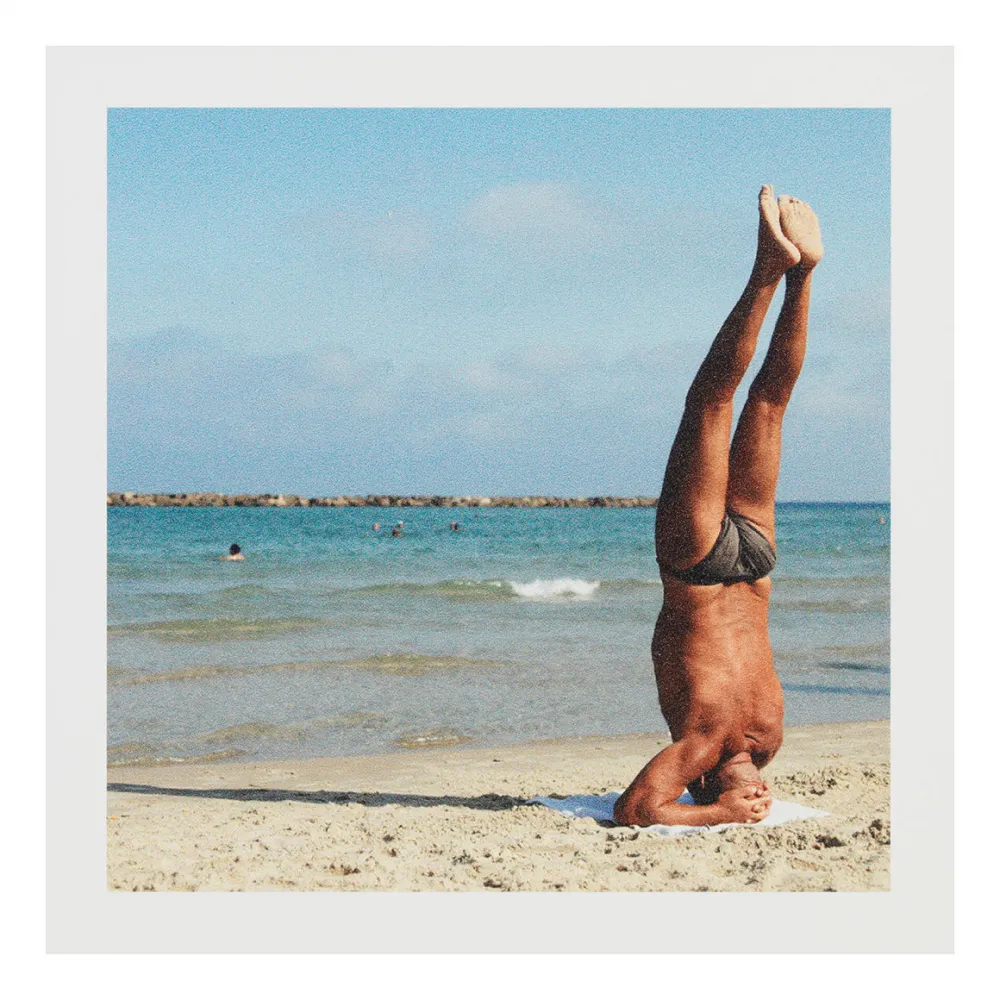
Ruthe Zuntz (born in Haifa, Israel, 1971), Tel Aviv II from the PHOTOMAT: Challenging WallMAT series, Israel/Berlin, photoprint on aluminium Dibond, 2013-2014; Jewish Museum Berlin.
Photographs that peel away the masks – A conversation with Ruthe Zuntz
In December 2014, less than three months after our art vending machine was filled with another 1,400 commissioned art objects, it was already sold out. Visitors to the museum might have pulled a picture by Ruthe Zuntz from the machine. Pieces from her PHOTOMAT: Challenging WallMAT series, as the photographer entitled her square Dibond aluminum prints which cover ten different motifs, could be sparkling in many new households – like Ruthe herself whom I recently met.
Alice Lanzke: Ruthe, you’re actually known for large, space-filling installations. And yet, for the art vending machine you produced a series of small photo prints. How did that happen?
Ruthe Zuntz: I found the project really exciting because it matches one of my basic philosophies: art can do so much to move and help change things. Because of the art vending machine, people now have the chance to take a fragment of my work home with them – a piece of “takeout” art.
Alice Lanzke: The pictures in your series for the art vending machine, PHOTOMAT: Challenging WallMAT, originated from your 2007 project, Challenging Walls, where you projected photographs from Israel, Palestine, Northern Ireland, Cyprus, and Germany onto a piece of the wall that separates Israel from the West Bank. Could you tell our readers something about that project? We have some experience with walls here in Germany…
Ruthe Zuntz: I was here in Berlin for the first time shortly before the Wall fell, prior to moving here permanently in 1991. At that time I thought the era of walls was finally over – I was so glad! And then in 2003 the wall in Israel was built. One can see it as protection, but one can also read it differently: it separates people from one another, friends and enemies both. Together with other artists, I played with the wall, using it as a ‘silver screen’. This is another connection to the pictures I created for the art vending machine! They’re printed on silver plates – like the silver screen. (Laughs.)
Alice Lanzke: What did you want to achieve with Challenging Walls?
Ruthe Zuntz: The idea for the project occurred to me first in 2003, at a time when there were a number of terror attacks in my home country, Israel. I was already living in Berlin, but friends from Israel called me often, sounding more and more desperate. I couldn’t just stand by and watch anymore. I wondered what I, as one little artist, could do to create a spark of hope and peace. Gradually I developed Challenging Walls: it was about showing what everyday life looks like for people who are separated by walls. Artists from Israel and Palestine shot photos of completely everyday scenes on each side of the wall, and in this way opened up a window. To give a more universal perspective, artists from Europe (Northern Ireland, Cyprus, and Germany) were also invited to contribute their views on walls and how we live life with them.
Alice Lanzke: The result was an enormous multimedia production on a segment on the wall…
Ruthe Zuntz: …when I saw it for the first time, after all the long hard work involved, I was very moved. Many people told me beforehand that the project would fail, that I wouldn’t get the necessary permits let alone find a Palestinian photographer. But everything worked! The Palestinian photographer has even become a good friend of mine – he lives across the street from me now. So we really did break down walls. (Laughs.)
Alice Lanzke: In the ten photos from Israel that you chose for the art vending machine, the diversity of your motifs is striking: there are pictures that come across as very melancholy, almost mournful, and then there are some that show their own kind of sparkling wit…
Ruthe Zuntz: These are the various sides of the country. When you talk about melancholy, you must mean the picture with the old woman sitting in the hair salon…This woman really touched me – she looks like she’s been waiting for years for something to happen, but it hasn’t.
Alice Lanzke: What’s the significance of the picture of the laundry blowing in the wind?
Ruthe Zuntz: Laundry is an interesting subject for me. The first summer I spent in Berlin, I was fascinated by people’s behavior here: there were people lying in the sun in a park in the middle of the big city – naked. Israelis and Palestinians would never do that. Instead though, we hang our most intimate laundry outside to dry.
Alice Lanzke: What was it like for you, aside from the nudity, to move to Berlin?
Ruthe Zuntz: Coming here, I basically brought my father’s life full circle. On my paternal side I’m 16th generation German. My grandfather sent my father to Palestine in 1939, but he himself wanted to stay in Germany. When my father visited me in Berlin, he spoke German for the first time in decades. My being here allowed him to make his peace with Germany. All the better that these Israeli and Palestinian fragments could come to Berlin with PHOTOMAT: Challenging WallMAT. That’s exactly the idea of a “united world”…
Alice Lanzke: …meanwhile, the art vending machine is already sold out…
Ruthe Zuntz: Really? That’s great! That means these pieces are already at home with people, spreading their aura.
Alice Lanzke, Marketing & Communications
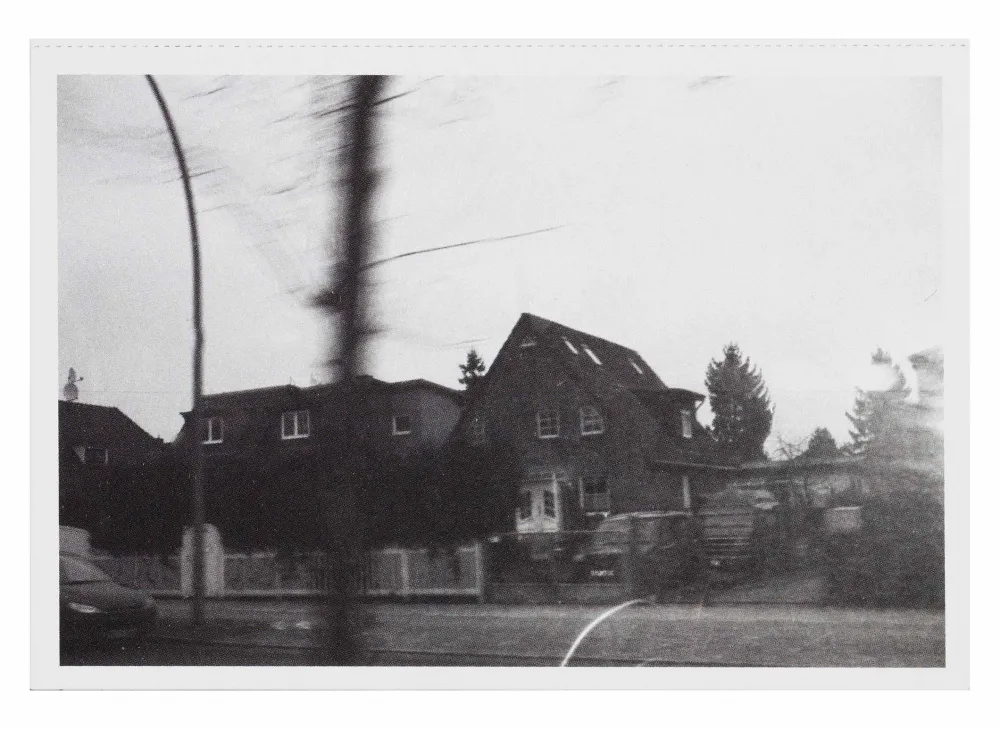
Daphna Westerman (born in Tel Aviv, Israel, 1979), Highway, Berlin, 2011, Postcard from the Film In and Between the Cities, 2010-2012; Jewish Museum Berlin.
A Film Still in the Mail Box: Daphna Westerman’s Postcards in Motion
Did you find a postcard like this one in your mail box as well? Or have you even pulled the entire road movie by Daphna Westerman out of our Art Vending Machine? By now the Machine is sold out completely. But no need to stop the movie! Let’s just rewind a little… Before the work of the Israeli artist ended up in the museum’s Art Vending Machine in 2014, I had received a postcard with a black and white photograph. Except for my address and the title, U-Bahn Berlin. From In and between the cities, 2011. A film by Daphna Westerman, there was nothing more to it. A few days later more cards were in the mail. Time to phone Daphna.
Lisa Albrecht: Daphna, why didn’t you write anything on the postcards that you sent me?
Daphna Westerman: I did not write anything on the postcards because I feel that the image speaks for itself. It does not need anything to be added. If I were to write something personal, this would be the main issue of the postcard instead of the postcard itself. I wanted the image itself to be the important thing. I wanted people to see the image, read the title and figure out what they want from it.
Lisa Albrecht: The cards show shots of Tel Aviv and Berlin in the years 2010 and 2011. What does the title In and between the Cities/a film by Daphna Westerman have to do with this?
Daphna Westerman: When I began the project in 2010, I traveled a lot, mainly in Israel but also to Berlin, Germany, because of my work, my parents, and my friends. I carried my 35 mm camera with me wherever I went and documented every place. I took photos on the road, and in the cities, I took photos basically all the time. My first idea was to create a film out of these stills. I really love road movies. Particularly the road movies by Wim Wenders were an inspiration for this project – these journeys, during which his protagonists move around from one city to another, documenting what they see and never settling in one place.
Lisa Albrecht: You ultimately didn’t make a film but rather a photo-series. How did that happen?
Daphna Westerman: When I looked at the photos during the work process something in the pictures made me think they were already part of an existing film. Every image is part of a bigger story, so that when you put all the images together you get the whole picture. For me, it is exactly like taking a frame out of a film. So I decided that it would not be necessary to make a real film of those pictures, when I can create a fictional one.
Lisa Albrecht: And why did you make post cards out of the photos?
Daphna Westerman: The best way to conceptually continue my journey was to distribute the photos, to turn them into postcards and to send them to people. In doing so, the whole project developed into an existing film that gave people a sense of how it is like to be on a journey. I consider the post as a public space but at the same time as an intimate one. It is important for me to approach people directly with my art. When people go to a gallery, they usually see pictures on a wall. I think there is a certain distance there that says: Now you are in a museum, now you are in a gallery. And that is much less personal than when you get work of art in your mailbox and it is addressed to you.
Lisa Albrecht: Visitors of the Jewish Museum Berlin did not necessarily find your post cards in their mailboxes, but they might have retrieved something from the Art Vending Machine: what was that?
Daphna Westerman: It is a small notebook with ten postcards from Tel Aviv and Berlin. I invited the visitors who got the postcards to be a part of my art, to continue it, to use it as they want. In this case, it is not just my personal journey anymore; I am combining it with the journeys of the museum’s visitors.
Lisa Albrecht: What exactly should our visitors then do with the post cards?
Daphna Westerman: Send them, of course! The postcards are not just to be hung on the wall! Pick a postcard, fill it out, put on a stamp, and go and put it in a mailbox. I wish that people will really address this work to someone. That way, they continue it. I mean: Just take it and do something with it!
Lisa Albrecht: And therefore one could understand your post card series as an interactive movie. What else are you working on? And which themes are important to you?
Daphna Westerman: I am usually interested in the urban situation, the city life and how it affects us. In every project I do, I address this issue in a different way, from a different angle ‒ as I did for the art vending machine. But I think this project is not just about traveling the cities, it is also about the lack of roots and the feeling of not belonging to one place, the feeling of movement.
Lisa Albrecht: Where are you living right now and what are you currently working on?
Daphna Westerman: I am working on a video piece that takes place in my studio in Tel Aviv which is actually a bunker. I’ve been renting this space from the municipality for low cost. It is a big space, and it has all kind of systems against chemical bombings and stuff like that. I guess it sounds strange but unfortunately for me it’s everyday life.
A while after we spoke on the phone, Daphna had to clear everything out of her studio in the bunker. She wrote me: “The video work is called
Four hours
and deals with the current situation. In case of war, I as an artist who’s using this space as a studio have only four hours to leave it and evacuate all my equipment, so that the people who live in the area can use it as a bunker. And that is what happened during the making of this piece, when another war in Gaza started.
Daphna Westerman could have returned to her studio by now, but in October she began a Master’s Program in Weimar. Much success, Daphna!
Lisa Albrecht, Marketing & Communications
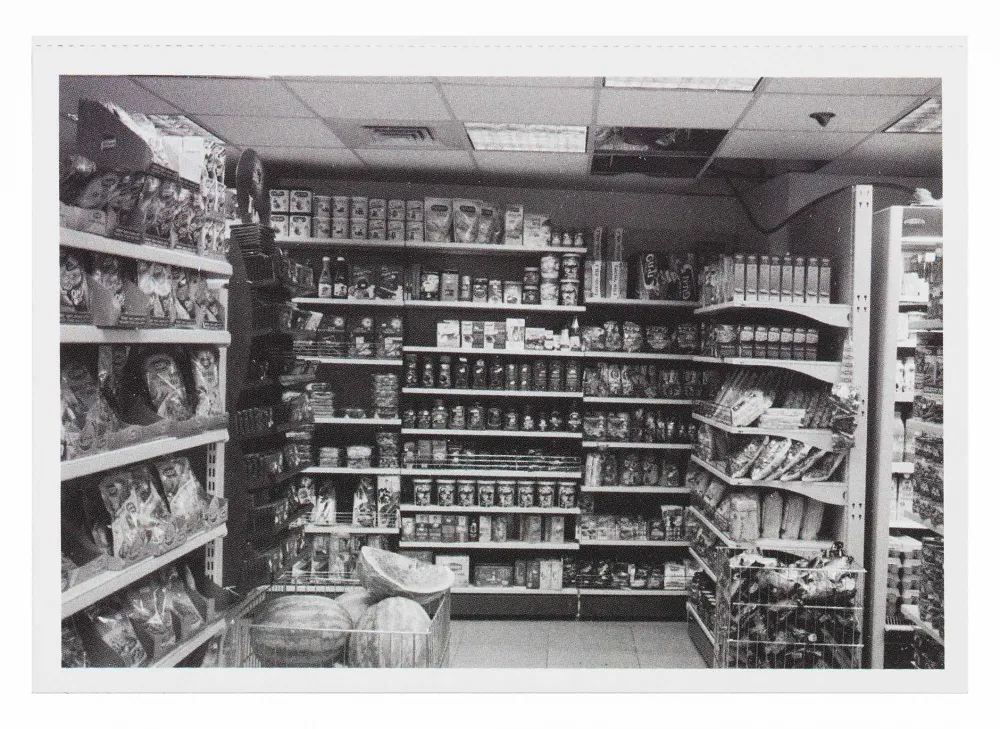
Daphna Westerman (born in Tel Aviv, Israel, 1979), Supermarket, Frishman St. Tel Aviv, 2010, Postcard from the Film In and Between the Cities, 2010-2012; Jewish Museum Berlin.
A Film Still in the Mail Box: Daphna Westerman’s Postcards in Motion
Did you find a postcard like this one in your mail box as well? Or have you even pulled the entire road movie by Daphna Westerman out of our Art Vending Machine? By now the Machine is sold out completely. But no need to stop the movie! Let’s just rewind a little… Before the work of the Israeli artist ended up in the museum’s Art Vending Machine in 2014, I had received a postcard with a black and white photograph. Except for my address and the title, U-Bahn Berlin. From In and between the cities, 2011. A film by Daphna Westerman, there was nothing more to it. A few days later more cards were in the mail. Time to phone Daphna.
Lisa Albrecht: Daphna, why didn’t you write anything on the postcards that you sent me?
Daphna Westerman: I did not write anything on the postcards because I feel that the image speaks for itself. It does not need anything to be added. If I were to write something personal, this would be the main issue of the postcard instead of the postcard itself. I wanted the image itself to be the important thing. I wanted people to see the image, read the title and figure out what they want from it.
Lisa Albrecht: The cards show shots of Tel Aviv and Berlin in the years 2010 and 2011. What does the title In and between the Cities/a film by Daphna Westerman have to do with this?
Daphna Westerman: When I began the project in 2010, I traveled a lot, mainly in Israel but also to Berlin, Germany, because of my work, my parents, and my friends. I carried my 35 mm camera with me wherever I went and documented every place. I took photos on the road, and in the cities, I took photos basically all the time. My first idea was to create a film out of these stills. I really love road movies. Particularly the road movies by Wim Wenders were an inspiration for this project – these journeys, during which his protagonists move around from one city to another, documenting what they see and never settling in one place.
Lisa Albrecht: You ultimately didn’t make a film but rather a photo-series. How did that happen?
Daphna Westerman: When I looked at the photos during the work process something in the pictures made me think they were already part of an existing film. Every image is part of a bigger story, so that when you put all the images together you get the whole picture. For me, it is exactly like taking a frame out of a film. So I decided that it would not be necessary to make a real film of those pictures, when I can create a fictional one.
Lisa Albrecht: And why did you make post cards out of the photos?
Daphna Westerman: The best way to conceptually continue my journey was to distribute the photos, to turn them into postcards and to send them to people. In doing so, the whole project developed into an existing film that gave people a sense of how it is like to be on a journey. I consider the post as a public space but at the same time as an intimate one. It is important for me to approach people directly with my art. When people go to a gallery, they usually see pictures on a wall. I think there is a certain distance there that says: Now you are in a museum, now you are in a gallery. And that is much less personal than when you get work of art in your mailbox and it is addressed to you.
Lisa Albrecht: Visitors of the Jewish Museum Berlin did not necessarily find your post cards in their mailboxes, but they might have retrieved something from the Art Vending Machine: what was that?
Daphna Westerman: It is a small notebook with ten postcards from Tel Aviv and Berlin. I invited the visitors who got the postcards to be a part of my art, to continue it, to use it as they want. In this case, it is not just my personal journey anymore; I am combining it with the journeys of the museum’s visitors.
Lisa Albrecht: What exactly should our visitors then do with the post cards?
Daphna Westerman: Send them, of course! The postcards are not just to be hung on the wall! Pick a postcard, fill it out, put on a stamp, and go and put it in a mailbox. I wish that people will really address this work to someone. That way, they continue it. I mean: Just take it and do something with it!
Lisa Albrecht: And therefore one could understand your post card series as an interactive movie. What else are you working on? And which themes are important to you?
Daphna Westerman: I am usually interested in the urban situation, the city life and how it affects us. In every project I do, I address this issue in a different way, from a different angle ‒ as I did for the art vending machine. But I think this project is not just about traveling the cities, it is also about the lack of roots and the feeling of not belonging to one place, the feeling of movement.
Lisa Albrecht: Where are you living right now and what are you currently working on?
Daphna Westerman: I am working on a video piece that takes place in my studio in Tel Aviv which is actually a bunker. I’ve been renting this space from the municipality for low cost. It is a big space, and it has all kind of systems against chemical bombings and stuff like that. I guess it sounds strange but unfortunately for me it’s everyday life.
A while after we spoke on the phone, Daphna had to clear everything out of her studio in the bunker. She wrote me: “The video work is called
Four hours
and deals with the current situation. In case of war, I as an artist who’s using this space as a studio have only four hours to leave it and evacuate all my equipment, so that the people who live in the area can use it as a bunker. And that is what happened during the making of this piece, when another war in Gaza started.
Daphna Westerman could have returned to her studio by now, but in October she began a Master’s Program in Weimar. Much success, Daphna!
Lisa Albrecht, Marketing & Communications
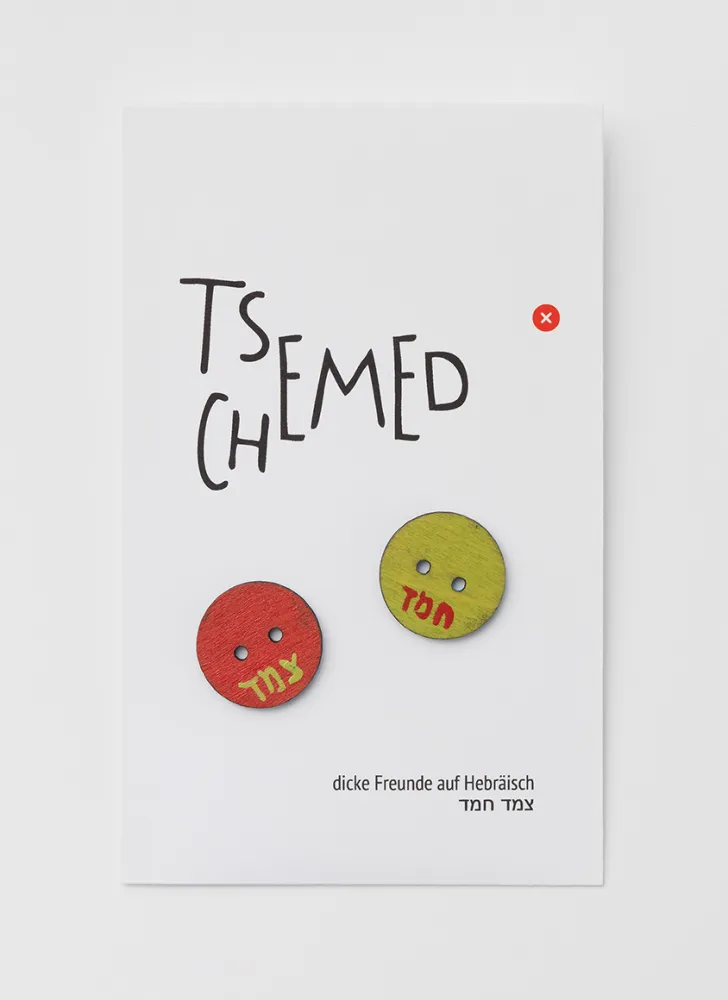
Lina Khesina (born in Pensa, Soviet Union, today: Russia, 1983), Tsemed Chemed – "Fast Friends." Two colorful buttons to strengthen the bonds of friendship, wooden buttons, painted and inscribed by hand, 2013; Jewish Museum Berlin, photo: Jens Ziehe The main idea by artist Lina Khesina behind this object called Tsemed Chemed – "Fast Friends" is to show the beauty of the Hebrew language, to examine this beauty in playful ways and to transport it into everyday life – or, more specifically, to wear it.
Friendship You Can Touch: An Interview with Lina Khesina
30 July is International Friendship Day. But how do we commemorate friendship? Or how do we make it visible? We consulted with communications designer Lina Khesina to find out. She devised a pair of ‘friendship buttons’ for the art vending machine in our permanent exhibition. One of them features the word “Tsemed” in Hebrew script, and the other one the word “Chemed.”
Lisa Albrecht: Lina, why did you develop this item in particular for the art vending machine?
Lina Khesina: I had the idea of showing the beauty of the Hebrew language and transmitting it in an everyday way. I don’t actually speak Hebrew myself, but purely from a musical perspective I find it and Spanish the two most beautiful languages. So I really wanted to discover Hebrew for myself and find a constellation of words in the language that I could play with. That’s how these buttons with the wordplay emerged.
How did the wordplay occur to you?
In Russian, best friends are often called “nje rasléj wodá”, which more or less means “even water cannot destroy this bond.” I did some research on whether there’s such an idiom in Hebrew as well and thus learned about “Tsemed Chemed.” Translated literally, it means “sweet entanglement” or “fine pair”, and is an expression for ‘close friends.’
What do these two words have to do with the buttons?
Buttons get sewed on with a thread and become then ‘entangled,’ or interwoven, with the material. Close friends experience something similar, even when they live thousands of kilometers apart. Like the buttons, they’re connected to each other by the thread and the adage.
How important to you is a connection over a great distance?
I think these days we all have friends on other continents, whom we don’t see very often. We have the connection now via the internet of course. But we could also feel the connection to a friend just by touching a button. That has something personal, something beautiful – as long as you don’t immediately lose the button!
How did you get the idea to design buttons? You usually work as an illustrator, right?
Buttons can be a symbol for connecting one thing with another. Strictly speaking, this is their only function. And though I chose buttons, I actually stayed with the medium of illustration or graphic design – just on a different material. But it’s really the same thing: it’s applied art, not just another souvenir that gets put on a shelf somewhere. This has a purpose and the capacity to remain meaningful and alive.-
How exactly did you produce the buttons?
They were cut out with a laser and had a very pleasant wood smell at the beginning. Then I dyed one side, and then the other. And finally I added the words – two hundred times. I always double-checked them to be sure I was writing them correctly, because the only difference between “Tsemed” and “Chemed” is the first letter. At the end I varnished the buttons and then packaged them.
What should our visitors do with the buttons?
Visitors who get these two buttons will either have a friend standing next to them – because you usually don’t go to a museum alone – or they’ll have someone in mind, their connection with whom they’d like to intensify. They can each sew the button onto a piece of clothing, in a book, or on a backpack, so they always have it with them.
Do you carry one of your buttons too?
Sadly I gave them all away. But if I still had one copy I would carry it with me.
To whom would you give the second button?
I can think of a number of people. But then in a way it’s already missing the point: you really need to find exactly the right friend, the one person you want to have it, because you only have the one button. I think I would send the second button to a friend in Belarus who has inspired me in many ways. She’s a musician and puppet theater director. We’re creating a little puppet theater piece together at the moment.
Apropos the right friendship: what is the mark of a true ‘close friend’ for you?
With the right friend, you can be just as you are – and not someone else, as we sometimes wish we were. Having friends is important for staying true to yourself.
Thank you for talking to us, Lina!
Lisa Albrecht, Media
For more by and about Lina Khesina, check out her website www.flyingfly.de.
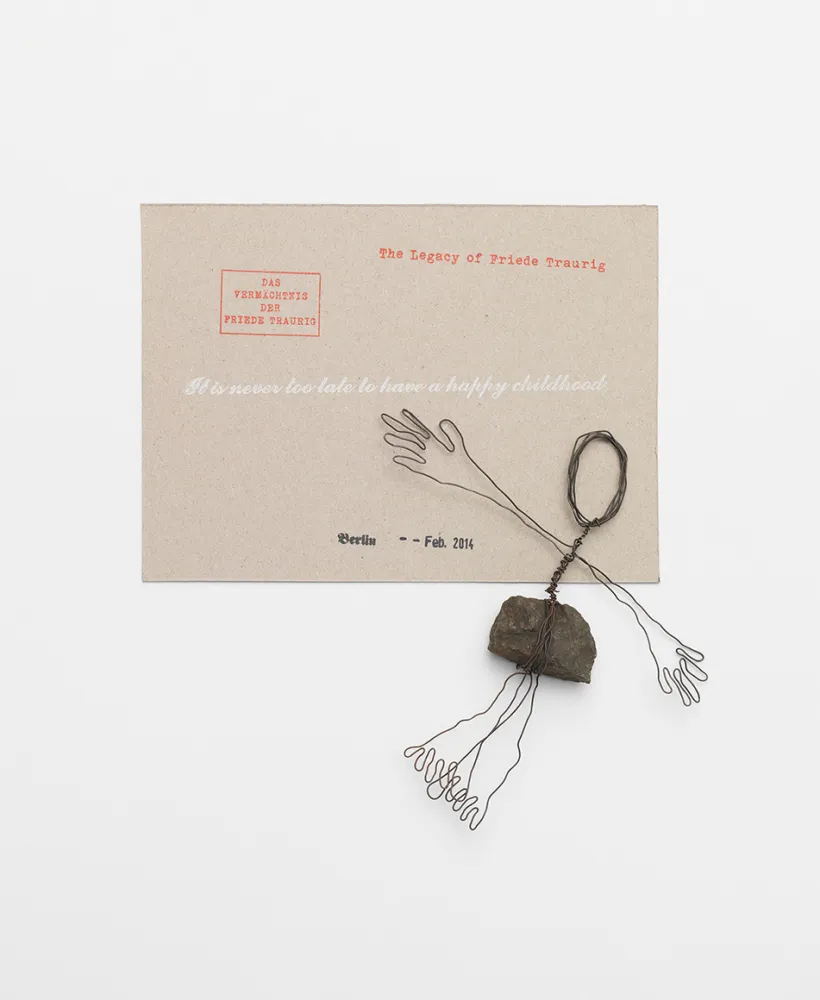
Deborah Wargon (born in Melbourne, Australia, 1962), Das Vermächtnis der Friede Traurig / The Legacy of Friede Traurig. It's never too late to have a happy childhood, wire wrapped around rail track gravel, February 2014; Jewish Museum Berlin, photo: Jens Ziehe As "executrix," Deborah Wargon grapples with the treasures and dark mysteries of legacies.
Perplexing legacy: With her works for our art vending machines, Deborah Wargon exposes things that got swept under the rug
A cordial welcome, the wafting flavors of a freshly-cooked meal, a light-drenched room with a high ceiling, full of brightly-colored books and pictures, and a piano with a sign-post ‘to Australia’ sitting on it… My first encounter with Deborah Wargon in her live-in atelier in Berlin’s Prenzlauer Berg neighborhood is a far cry from the rather severe, somber associations that the term ‘testament enforcer’ brings up for me. Wargon – a musician as well as visual and theater artist born in Melbourne in 1962 – describes herself this way on the package insert that comes with the small-scale artworks that she created for the art vending machine in our permanent exhibition. Those artworks bear the title The Legacy of Friede Traurig – where Friede Traurig doubles as a proper name and, in German, to mean peace sorrowful. And Deborah Wargon, who is best known for her paper cuttings inside former insect cases, says that she would rather be sorrowful.
With a little good luck, you may get one of her works from the vending machine: for instance, a little human figurine made of rail track ballast (gravel), wire, and newspaper. Aside from the expressive name Friede Traurig, the materials invoke woeful stories of train transports and barbed wire fences, particularly because the newspapers she used are from the Second World War. But for the artist, it’s clearly not only about the specific time the Nazis were in power and the Shoah. It’s also about the legacies, the inheritance, the stories that we all carry with us. She explains her choice of materials:
“For me, wire is a fascinating material. It’s also used for cages. So you can use to suggest the ways that we’re all captive.”
The rail track gravel, which normally lies on the ground, relates for Wargon to the ground that we all walk on, as descendants of the people who came before us.
“Besides, in both German and English there’s the expression ‘to sweep something under the rug’”.
The gravel, or grit, that we bring into the house on the soles of our shoes, and then sweep under the rug, stands for something that we don’t want to face and deal with.
The gravel stone that’s incorporated into the figurines thus also represents the burden of legacies. The individually-made pieces each show that this burden can appear all over, in a person’s head, their heart, stomach or belly. Each figurine is provided with the cheerful tongue-in-cheek suggestion “It’s never too late to have a happy childhood.”
I was convinced immediately that the artist, who gives an infectious fun-loving impression, does hope to build something unique and life-affirming on these bewildering layers of history and legacy.
To accompany the pieces in the art vending machine, Wargon wrote a fairy tale – that also ends by awakening hope and is teeming with ideas from the discourse on memory. Her great-great-grandmother was in fact named Friede Traurig. In the same way that the name sounds like an allegory, she uses the form of a fairy tale to validate the artwork beyond her own biography, unlocking her interpretations of the art for others. For example, from my own reading of it, I could see in the motif of giving birth as a metaphor, among other things, for the creative process of an artist:
“A long, long time ago, time came to the womb and spoke to it, saying that now was the right time to give birth. And so it happened that the water broke and the womb brought legacy into the world.”
It was in face like this for her, answered the artist to this inquiry: she always finds herself ‘pregnant’ with ideas for artworks before she brings them into the world. All told, she is surprised when some people here in Germany tell her that her art is so ‘feminine’. After all she works with human bodies in her paper cutting – masculine as well as feminine forms.
I glanced at a paper cutting on the wall, a picture of two babies still connected to their mother by their umbilical cords. Wargon tells me that her artistic preoccupation with motherhood also has something to do with her Jewish identity, which she’s grappled with intensively in the last few years. Motherhood (especially of children who didn’t come) was already an important issue for biblical matriarchs like Sara and Rebecca.
Wargon’s second piece for the art vending machine also emerges from her addressing her Jewish identity. This one has the title Eye of God and it’s a piece of rail track ballast wrapped in a thicker and shinier wire, that sort of brings to mind a model of an atom.
“I wasn’t raised religious and I don’t believe in God. When I read the ten commandments, they seem rather vain and patriarchal – and have something of Big Brother about them. So God also belongs to the gravel-ground on which I’ve built my identity as a modern Jew – only, like the singular self-contained atom, he stays inaccessible to me.”
Mirjam Bitter, Media
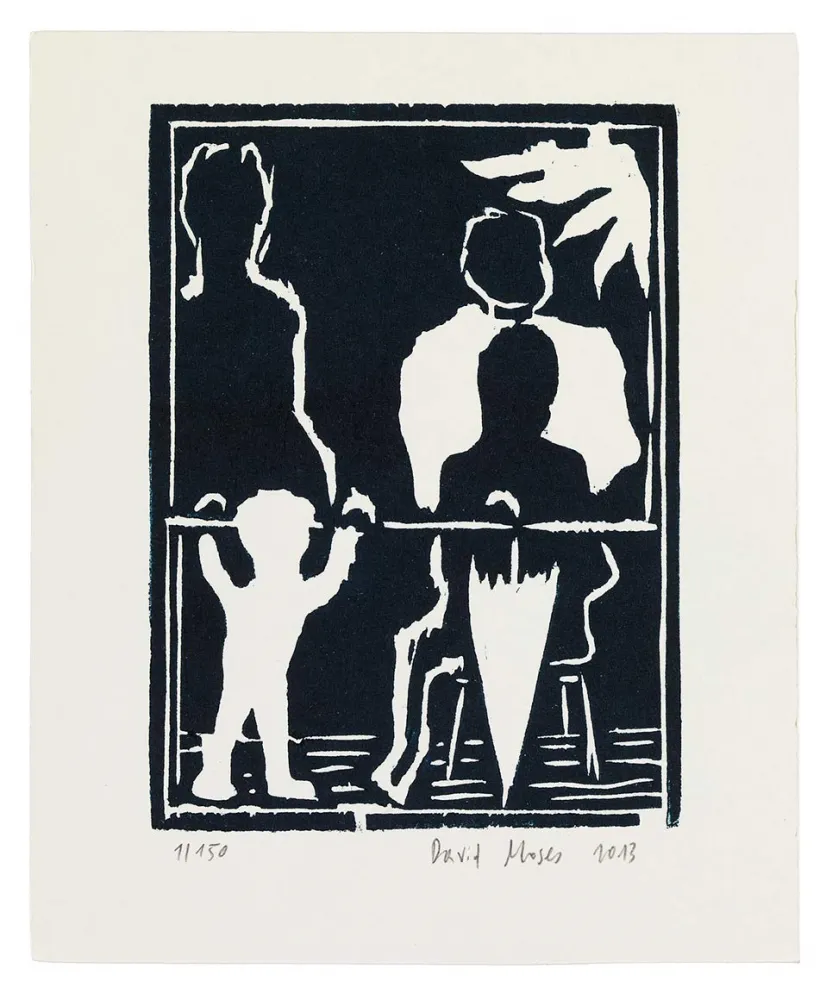
David Moses (born in Bonn, Germany, 1983), The Balcony – 2013.DG.HD.13.9.0001, woodcut in an edition of 150, 2013; Jewish Museum Berlin, photo: Jens Ziehe The work The Balcony by David Moses is based on an etching by his grandfather who made his orginal print based on impressions of a trip to Berlin in 1963-64.
Three Images, Two Artists and One Wall
The construction and the fall of the Berlin Wall have occupied two generations of artists in the Moses family: in 1963/64 Manfred Heinz Moses created “The Balcony,” an etching on which, fifty years down the line, his grandson David Moses was to base a woodcut and polychrome etching. The latter works are likewise called “The Balcony” and they number among the unique pieces developed by seven artists resident in Berlin for the art vending machine on display in our permanent exhibition. A total stock of 1,400 artworks has been sold since early summer.
Grandpa Moses created his etching when still reeling from the shock of a trip to Berlin shortly after the Wall was built. It shows a seemingly resigned family, standing on a balcony.
The artist and lecturer Manfred Heinz Moses was born in Marienwerder, East Prussia, in 1917 and migrated to Palestine in 1937. When his kibbutz gave him a grant to study at the Amsterdam Academy of Art in 1963/64, he seized the chance to visit the divided city, too.
His 31-year-old grandson David Moses now lives as an artist in Berlin. He manages the artistic legacy of Manfred Heinz, which is the only means he has ever had to get to know him. I interviewed David about why he had based his work for the art vending machine on his grandfather’s Berlin motif. He told me: “I believe the division of Germany deeply affected my grandfather and he expressed this in an unusual way. Without background info, one would never know the family in the etching is standing on a balcony in East Berlin. And yet the image evokes a disturbing and oppressive atmosphere.”
David works primarily as a painter and printmaker, following in his grandfather’s footsteps. In his art, he explains, he explores “past traces and fragments in space.” And looking at his abstract images makes this patently clear: the interplay of colors, structures and layers lends his works a novel depth and timelessness. Yet there is also something palpable, immediate and vibrant about them. In comparison, the work of Heinz Manfred Moses is much more realistic.
“These are incredibly good etchings. He worked quite differently than I do. In only a few strokes, he brought objects and people to life, created something hugely expressive.”
For the art vending machine David chose to make his own interpretation of a family in the divided Berlin. Unlike in his grandfather’s work, the figures here vanish almost beyond recognition. In particular the many fine lines and intricate details in Heinz Manfred’s artwork posed a challenge for David when developing his woodcut. He created several versions and was satisfied only with the fourth. For the print he made ten plates, then experimented with various color combinations and sequences. When commissioned to produce work for the Jewish Museum Berlin, he settled finally on two plates: one with only sketchy outlines and, by way of contrast, a more figurative one.
On 9 November 1989, David was only 6-years-old. Nonetheless, the fall of the Berlin Wall has left a deep impression on him.
“I’ve lived in Berlin for eight years now and the 9 November is always a special day for me, year after year.”
Stephanie Alberding, Press and Public Relations
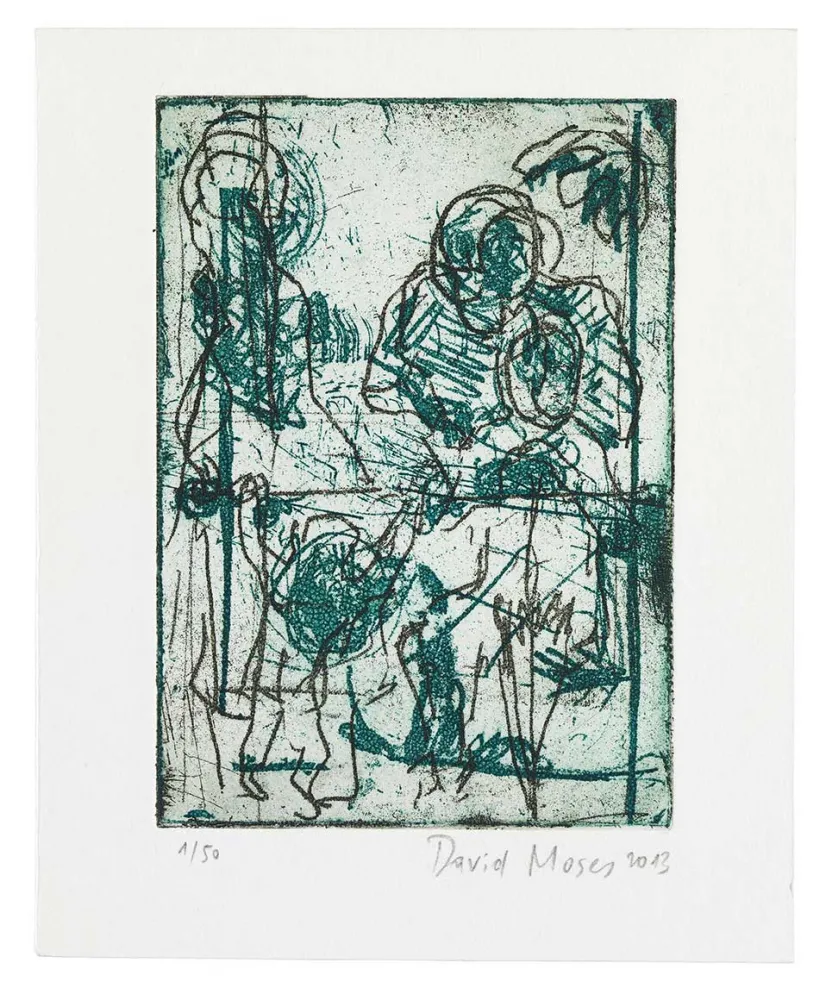
David Moses (born in Bonn, Germany, 1983), The Balcony – 2013.DG.TD.13.9.0001, color etching from two plates in an edition of 50, 2013; Jewish Museum Berlin, photo: Jens Ziehe
Three Images, Two Artists and One Wall
The construction and the fall of the Berlin Wall have occupied two generations of artists in the Moses family: in 1963/64 Manfred Heinz Moses created “The Balcony,” an etching on which, fifty years down the line, his grandson David Moses was to base a woodcut and polychrome etching. The latter works are likewise called “The Balcony” and they number among the unique pieces developed by seven artists resident in Berlin for the art vending machine on display in our permanent exhibition. A total stock of 1,400 artworks has been sold since early summer.
Grandpa Moses created his etching when still reeling from the shock of a trip to Berlin shortly after the Wall was built. It shows a seemingly resigned family, standing on a balcony.
The artist and lecturer Manfred Heinz Moses was born in Marienwerder, East Prussia, in 1917 and migrated to Palestine in 1937. When his kibbutz gave him a grant to study at the Amsterdam Academy of Art in 1963/64, he seized the chance to visit the divided city, too.
His 31-year-old grandson David Moses now lives as an artist in Berlin. He manages the artistic legacy of Manfred Heinz, which is the only means he has ever had to get to know him. I interviewed David about why he had based his work for the art vending machine on his grandfather’s Berlin motif. He told me: “I believe the division of Germany deeply affected my grandfather and he expressed this in an unusual way. Without background info, one would never know the family in the etching is standing on a balcony in East Berlin. And yet the image evokes a disturbing and oppressive atmosphere.”
David works primarily as a painter and printmaker, following in his grandfather’s footsteps. In his art, he explains, he explores “past traces and fragments in space.” And looking at his abstract images makes this patently clear: the interplay of colors, structures and layers lends his works a novel depth and timelessness. Yet there is also something palpable, immediate and vibrant about them. In comparison, the work of Heinz Manfred Moses is much more realistic.
“These are incredibly good etchings. He worked quite differently than I do. In only a few strokes, he brought objects and people to life, created something hugely expressive.”
For the art vending machine David chose to make his own interpretation of a family in the divided Berlin. Unlike in his grandfather’s work, the figures here vanish almost beyond recognition. In particular the many fine lines and intricate details in Heinz Manfred’s artwork posed a challenge for David when developing his woodcut. He created several versions and was satisfied only with the fourth. For the print he made ten plates, then experimented with various color combinations and sequences. When commissioned to produce work for the Jewish Museum Berlin, he settled finally on two plates: one with only sketchy outlines and, by way of contrast, a more figurative one.
On 9 November 1989, David was only 6-years-old. Nonetheless, the fall of the Berlin Wall has left a deep impression on him.
“I’ve lived in Berlin for eight years now and the 9 November is always a special day for me, year after year.”
Stephanie Alberding, Press and Public Relations
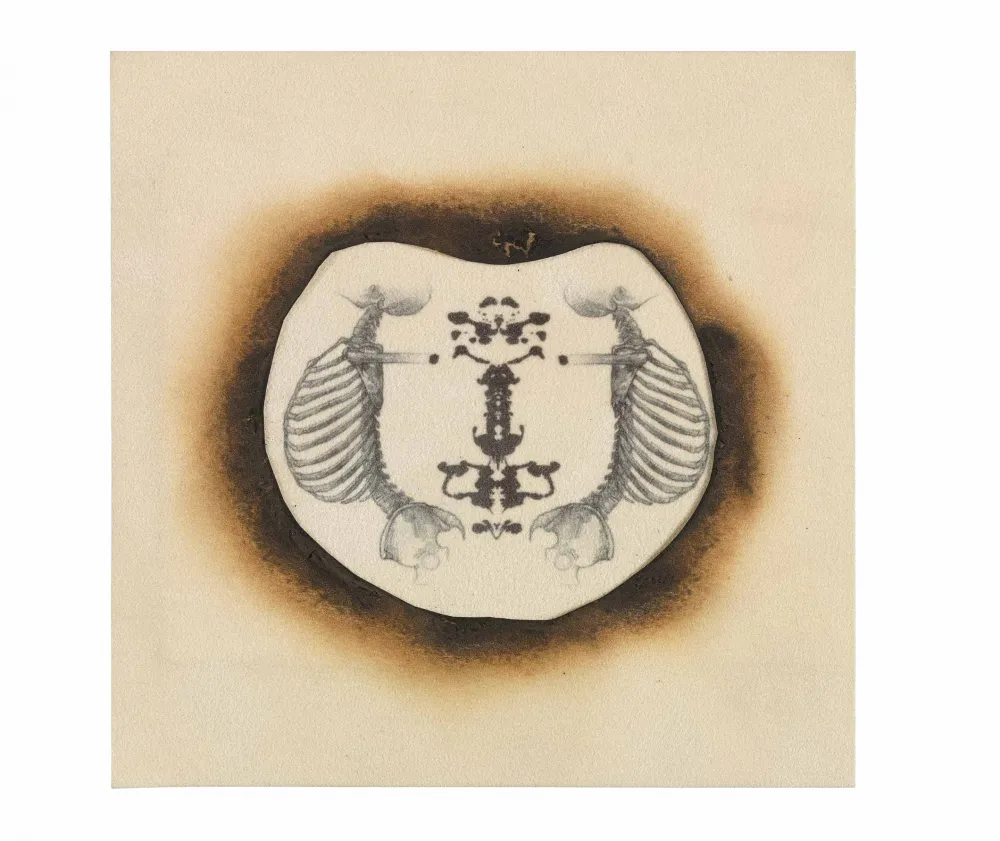
Victor Alaluf (born in Posadas, Argentina, 1976), Essence, ink screen-printing on hand-burned velvet, 2013; Jewish Museum Berlin, photo: Jens Ziehe The artwork seeks to express both the sense of destruction and that of rebirth, both death and life, structure and fragility.
Barefoot in the Dark
A retro-style armoire with a skull sitting on top of it—a piece from the collection of Victor Alaluf, an artist with Argentinian roots whom I interviewed recently in his studio in Berlin-Friedrichshain.
In his work—installations, mainly, comprised of drawings, collage, sculpture, video art and everyday objects—Alaluf addresses the existential issues raised by our experience of death, pain, and the ephemeral and fragile nature of all living creatures. His choice both of material and objects is decisive. He frequently chooses brittle materials, such as glass or ceramics, as well as organic matter, such as human hair and blood. Alaluf has a particular penchant for damaged or “useless” materials. Thus the wood used to frame some of his more recent artworks is timber flooring salvaged from a local building under refurbishment. Alaluf takes such finds home for use in his art and so saves them from disappearance. He also trawls flea markets for objects he can integrate in his work because he is fascinated by the patina of old wooden clocks, furniture and the like: the artist is drawn to the traces of time and to the human stories behind them. He regards this as “essence.”
It seems to me that Alaluf’s art somehow reflects his own biography—the leukemia he once suffered but managed to overcome. As he explained to me, the medical needles he once used to affix silhouettes to a backdrop point to that experience. Alaluf pays reference to physical sickness and processes of healing likewise in “Barefoot in the Dark,” a video piece from 2014, which portrays a man tortured by pain who is undergoing treatment. Pulsating MRT scans of the human brain are intercut with other footage. Iconographic motifs such as the thorn of crowns come into play when it seems as if all possible evil will be visited on this man. Ultimately, however, the image of a brilliant blue sky conjures rebirth and life and a flutter of butterflies—a symbol of hope for the artist—decoratively weaves its way across the screen.
Victor Alaluf created numerous editions of his work series Essence for the art vending machine in our permanent exhibition. They were first available for purchase in early summer this year and have unfortunately already sold out.
Each work consisted of two pieces of velvety paper stuck together, one atop the other. A round area at the center of the upper layer had been sufficiently charred to reveal the lower layer to which three different motifs had been applied using the silkscreen method. One motif in luminous color was reminiscent of human lungs or possibly of butterfly wings; another showed a finely sketched, stylized human skeleton; the third a human embryo in its amniotic sac. The combination of soft velvety paper, coats of translucent color and fine spidery lines conjured the impression of something fragile yet vital. At the same time, the charred area made it easy to imagine how quickly flames might engulf these things and destroy them.
In Essence, Alaluf juxtaposes apparent opposites—life and death, birth and extinction. He simultaneously suggests through his art that these realms are not opposites but irrevocably intertwined. Wherever a flame had been put to work, new images had emerged and new layers had been exposed. And yet the two pieces of paper remained in communication with one another, and interwoven: the dark brown lines extending from the embryo ended at the edges of the charred paper and merged there with its similar hue.
“The viewer should be able to see into the past as well as into the future, should be able to deal with things flooded with light as well as with darkness,”
wrote Alaluf in a commentary on his work.
“It is impossible for a young Jew living in Berlin today to evade such complex perceptions. Berlin is a city that inspires hope and the subject of this artwork is precisely that. It gives expression to a firm inner conviction that something new and vital can arise from the ashes of destruction.
Denis Grünemeier, curator of the exhibition Bedřich Fritta: Drawings from the Theresienstadt Ghetto
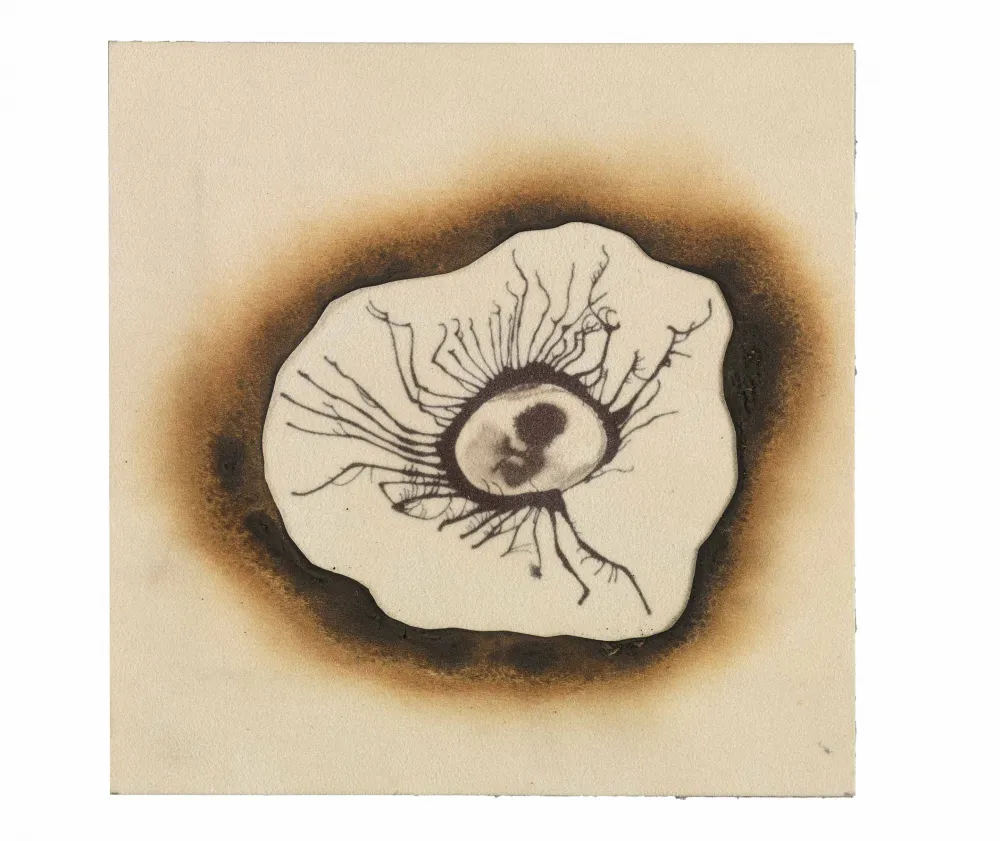
Victor Alaluf (born in Posadas, Argentina, 1976), Essence, ink screen-printing on hand-burned velvet, 2013; Jewish Museum Berlin, photo: Jens Ziehe
Barefoot in the Dark
A retro-style armoire with a skull sitting on top of it—a piece from the collection of Victor Alaluf, an artist with Argentinian roots whom I interviewed recently in his studio in Berlin-Friedrichshain.
In his work—installations, mainly, comprised of drawings, collage, sculpture, video art and everyday objects—Alaluf addresses the existential issues raised by our experience of death, pain, and the ephemeral and fragile nature of all living creatures. His choice both of material and objects is decisive. He frequently chooses brittle materials, such as glass or ceramics, as well as organic matter, such as human hair and blood. Alaluf has a particular penchant for damaged or “useless” materials. Thus the wood used to frame some of his more recent artworks is timber flooring salvaged from a local building under refurbishment. Alaluf takes such finds home for use in his art and so saves them from disappearance. He also trawls flea markets for objects he can integrate in his work because he is fascinated by the patina of old wooden clocks, furniture and the like: the artist is drawn to the traces of time and to the human stories behind them. He regards this as “essence.”
It seems to me that Alaluf’s art somehow reflects his own biography—the leukemia he once suffered but managed to overcome. As he explained to me, the medical needles he once used to affix silhouettes to a backdrop point to that experience. Alaluf pays reference to physical sickness and processes of healing likewise in “Barefoot in the Dark,” a video piece from 2014, which portrays a man tortured by pain who is undergoing treatment. Pulsating MRT scans of the human brain are intercut with other footage. Iconographic motifs such as the thorn of crowns come into play when it seems as if all possible evil will be visited on this man. Ultimately, however, the image of a brilliant blue sky conjures rebirth and life and a flutter of butterflies—a symbol of hope for the artist—decoratively weaves its way across the screen.
Victor Alaluf created numerous editions of his work series Essence for the art vending machine in our permanent exhibition. They were first available for purchase in early summer this year and have unfortunately already sold out.
Each work consisted of two pieces of velvety paper stuck together, one atop the other. A round area at the center of the upper layer had been sufficiently charred to reveal the lower layer to which three different motifs had been applied using the silkscreen method. One motif in luminous color was reminiscent of human lungs or possibly of butterfly wings; another showed a finely sketched, stylized human skeleton; the third a human embryo in its amniotic sac. The combination of soft velvety paper, coats of translucent color and fine spidery lines conjured the impression of something fragile yet vital. At the same time, the charred area made it easy to imagine how quickly flames might engulf these things and destroy them.
In Essence, Alaluf juxtaposes apparent opposites—life and death, birth and extinction. He simultaneously suggests through his art that these realms are not opposites but irrevocably intertwined. Wherever a flame had been put to work, new images had emerged and new layers had been exposed. And yet the two pieces of paper remained in communication with one another, and interwoven: the dark brown lines extending from the embryo ended at the edges of the charred paper and merged there with its similar hue.
“The viewer should be able to see into the past as well as into the future, should be able to deal with things flooded with light as well as with darkness,”
wrote Alaluf in a commentary on his work.
“It is impossible for a young Jew living in Berlin today to evade such complex perceptions. Berlin is a city that inspires hope and the subject of this artwork is precisely that. It gives expression to a firm inner conviction that something new and vital can arise from the ashes of destruction.
Denis Grünemeier, curator of the exhibition Bedřich Fritta: Drawings from the Theresienstadt Ghetto
August 2013–July 2014
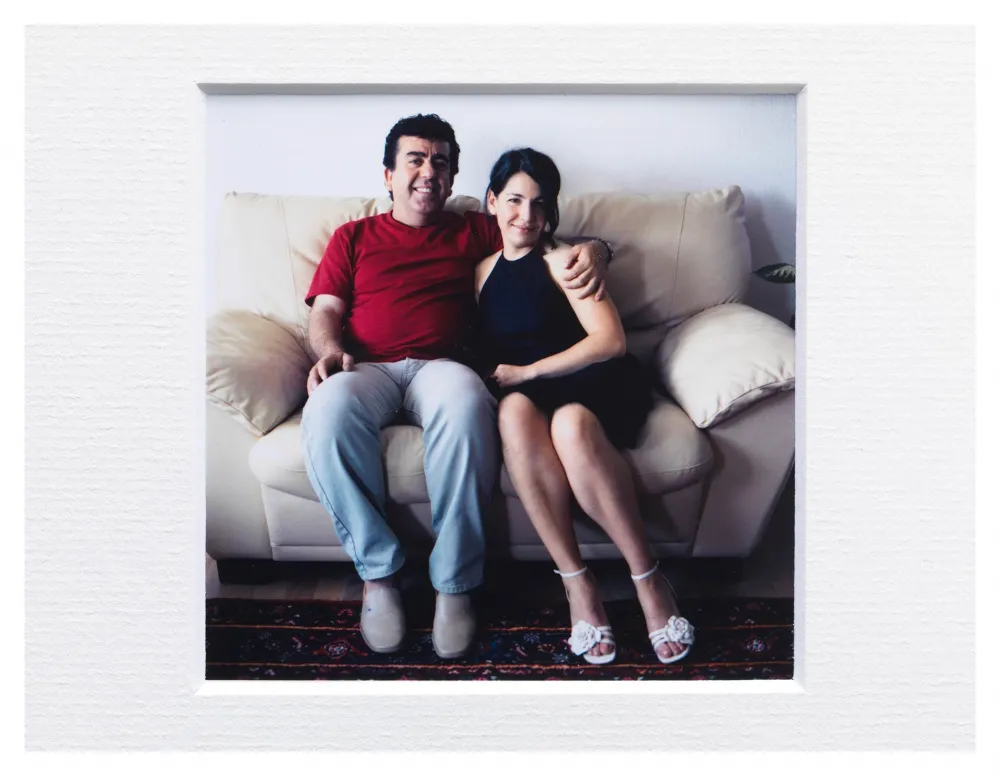
Mascha Danzis (born in Leningrad, Soviet Union, today: St. Petersburg, Russia, 1972), In Their Fathers’ Arms, photo series with 9 photos, 8 cm x 8 cm, framed behind a passepartout, 2013, original Series: 90 cm x 86 cm, framed, 2007; Jewish Museum Berlin
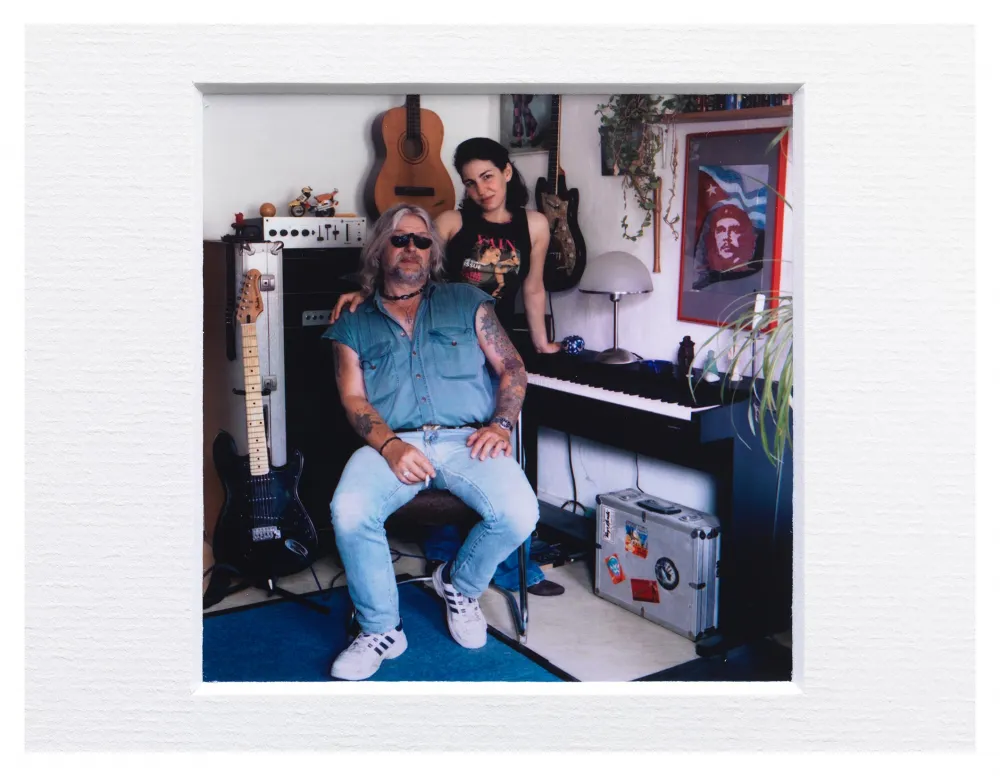
Mascha Danzis (born in Leningrad, Soviet Union, today: St. Petersburg, Russia, 1972), In Their Fathers’ Arms, photo series with 9 photos, 8 cm x 8 cm, framed behind a passepartout, 2013, original Series: 90 cm x 86 cm, framed, 2007; Jewish Museum Berlin
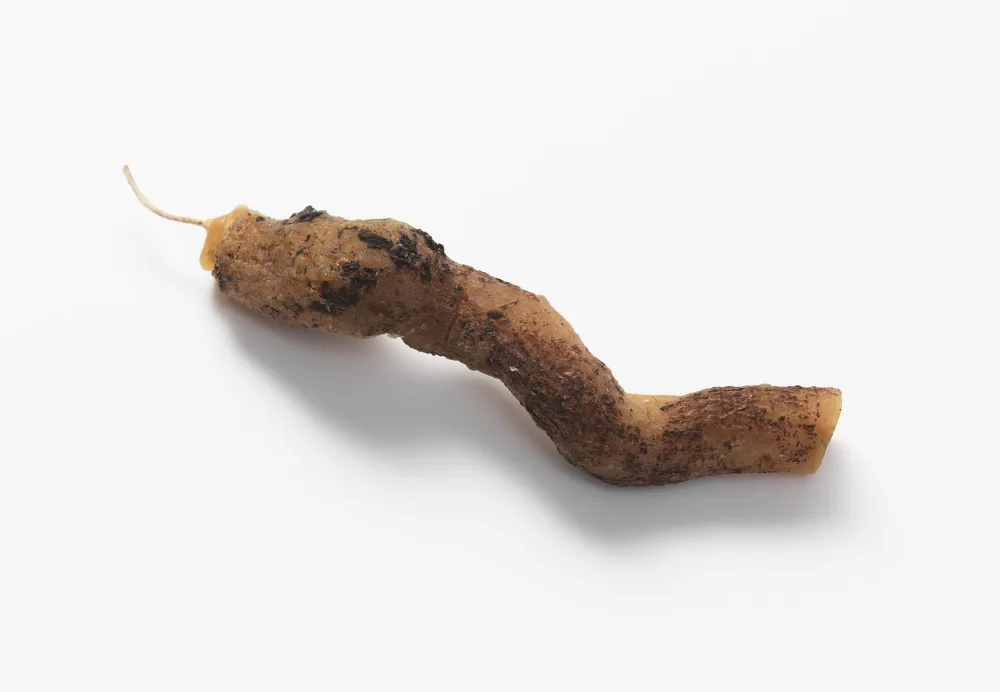
Alexis Hyman Wolff (born in Los Angeles, USA, 1982), Root Candle, beeswax, wick, 2013; Jewish Museum Berlin, photo: Jens Ziehe
Bees, Candles, Roots, and Remembrance: Interview with Alexis Hyman Wolff
One of the works in our art vending machine is a candle shaped like a root, made by the artist and curator Alexis Hyman Wolff. In this interview, she offers insight into the development of the work:
Christiane Bauer: Why did you make a candle for the art vending machine?
Alexis Hyman Wolff: Thinking about the small size of the objects and the temporary home they would find in the vending machine, I wanted to reflect on the idea of the souvenir, a central theme in museums. Candles are used for memorial in many cultures. In Jewish tradition, a yortsayt candle is lit to remember a loved one on the anniversary of their death.
What is special about the material you used?
The candles are made out of beeswax from a beekeeping supplier in Berlin. I understand that beeswax is one of the few materials that burn without producing black smoke, which could explain the belief that burning beeswax candles is good for the air. According to a European folk custom, when someone dies, a member of the family must go to the hive and “tell the bees,” and also invite them to the funeral. This tradition suggests a link between bees and the spirit world.
How important is the aspect of “remembrance” in your work?
I understand remembrance to be directly linked to loss and how we cope with it. In a world marked by transience and mortality, work in museums attempts to give knowledge, objects and stories a longer life, or a second life, in the service of generations to come. Remembrance, and finding ways to honor and understand the past, is at the core of this work.
How does the candle you created for the art vending machine take part in discussions on “remembrance” and “memorabilia”?
The candle is a small and modest object, which has enormous symbolic power: creating light in the darkness and harnessing fire. In the past, in medieval churches for example, candles were used to measure time. I like the idea that the candle opens up a period of time that is dedicated to remembering. The wax is transformed and eventually consumed as it carries out its work, and in the end all that remains is memory. Plato wrote about memory being like a wax tablet upon which our experiences are impressed, if only for a brief time. All of these aspects make the candle a complex object.
Furthermore, the candles in the art vending machine are shaped like roots, so that they might be able to help us to reflect on our origins, our ancestors, and the things that are “under the ground” or remain unseen. How do we remember what we cannot see? This question fascinates me.
You found the roots that shaped the candles in the vicinity of Los Angeles. How did you choose them, and how did you cast them as candles?
Finding the roots was a great adventure and very surprising. I thought that the roots in the forest would look just like taper candles, perhaps a bit curvier, but they were wildly different: some looked like knots, others more like branches or lightning bolts. After I had chosen six different roots that had the right size, a dear friend and expert mold-maker at the Museum of Jurassic Technology in Los Angeles showed me how to mount the roots and wrap them in silicone-dipped gauze strips. We then sliced the molds to extract the original roots. For each candle, the molds had to be tied up with string and nestled in sand before the melted wax could be poured in. Then the candles had to be extracted at just the right temperature for them to keep their shape, without getting brittle. My kitchen in Berlin was a candle production headquarters for several weeks. That was a nice winter activity!
What should our visitors do with the root candle?
I leave it up to the individual to decide whether they will burn the root candle or not, and hope that either way it might be a good reminder to those who take it home.
Thank you very much, Alexis.
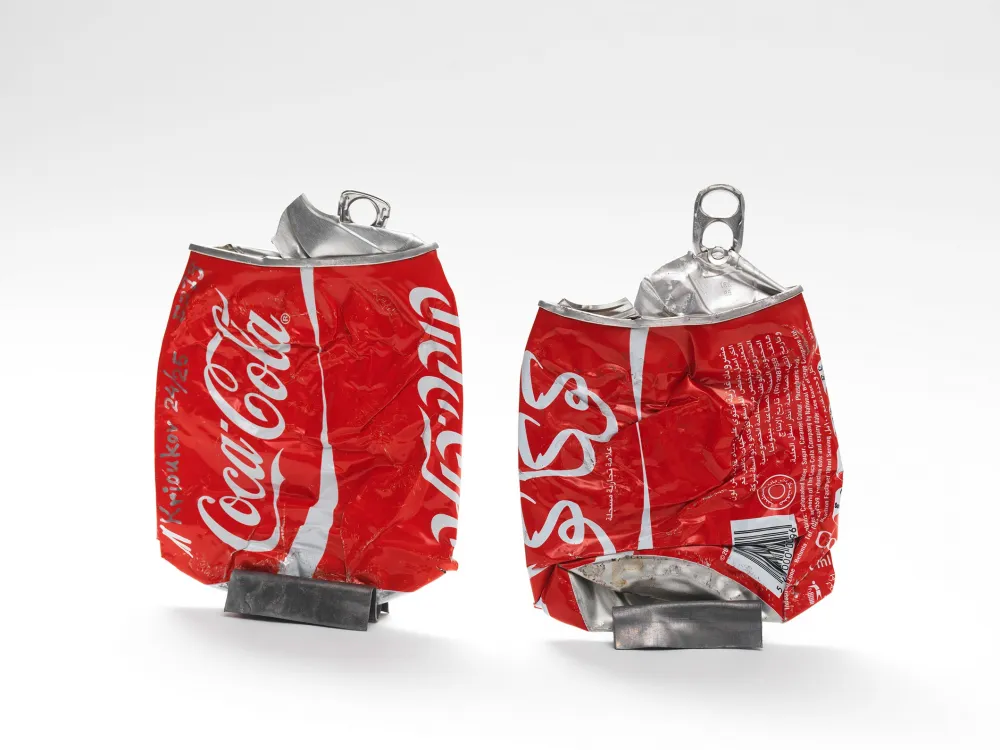
Andrei Krioukov (born in Moscow, Soviet Union, today: Russia, 1959), CocaCola, Aluminium can, crushed, signed, 2013; Jewish Museum Berlin, photo: Jens Ziehe
Art, Trash, and One-Way Realism: A Conversation with Andrei Krioukov
As a contribution to our art vending machine, Andrei Krioukov treated and crushed Coca-Cola cans with Hebrew and Arabic labels. I met him and his wife Rita at their art school on Immanuelkirchstraße in Berlin. This is where Andrei teaches international students, who both study and take their state-recognized exams with him.
In our discussion Andrei talks about his fascination with the design of the famous cans and explains the elements of both trash and art they represent.
Christiane Bauer: Andrei, what fascinates you about the Coca-Cola can?
Andrei Krioukov: These cans are typical of our lives today. You can find them everywhere, but hardly anyone notices them. For me, the discrepancy between art and trash is an exciting subject: if a can is lying on the street, it’s trash. But if I pick it up and contemplate it, and I ponder what I can do with it, it turns into art.
An artist from the 19th century could paint garlic, an onion, or a pitcher of water. Today our lives are full of Coca-Cola cans.
The pitcher appeared in still life paintings as an object from everyday life. What significance does the can have? Do you see a can of Coke as a disposable article or as a modern cultural artifact?
Some people think that I paint the Coca-Cola brand. I don’t paint Coca-Cola, but rather, the typical trash of today that you find lying on the street everywhere – in Israel, Palestine, America, or China. You could look at the crushed can of Coke as an icon of globalization.
Does the crushed Coca-Cola can convey an element of criticism?
There’s no criticism intended. Coca-Cola is just a very strong brand. And that’s not a bad thing. We all use and exploit that. Aside from being an icon of globalization, to buy and enjoy a can of Coke gives us a brief feeling of happiness… The can itself has an interesting shape. First of all, it’s a classic cylinder. But when it’s crushed, it takes on a new, much more interesting, shape. From a graphic perspective it generates a whole new pattern.
Do you have a standard method of crushing cans?
Before each treatment, I look very closely at the can and consider what shape would be interesting and what pattern could emerge from it. As such, I’m not actually crushing cans but creating a little sculpture. Crushing the cans can generate a pattern of folds, with the underside and top of the can, the label and barcode: it should end up being an interesting object. Practically speaking, I work like a sculptor. I rely on my artistically trained eye and my understanding of form. Even while painting, I don’t simply make a copy of the can but rather, look at it very closely and think about how to bring the rhythm of the can onto the flat surface of the painting.
How long have you been working with this form?
For about four years. We came to Berlin from Kassel and I was looking for something new.
We had our art school at the Kulturbrauerei (culture-brewery) in those days. On Fridays and Saturdays a lot of people would party in the big clubs there. On Sundays the ground would be covered with cans, beer bottles, and bottle caps. And suddenly I realized: “This is my subject!” I stumbled across it, so to speak.
Would you tell me more about the form you developed of ‘one-way realism?’ What is it exactly and how did you arrive at this concept?
‘One-way realism’ is a term that I coined myself, because the objects that I work with are disposable. We use them once. That’s not a tragedy because we also live just once. Everything that happens in our lives happens only once. That’s a schema that the Coca-Cola can expresses for me. We use it, drink the contents, and then throw it away.
Do you remember the first Coca-Cola that you drank?
The first time I saw Coca-Cola was in Bulgaria. In 1986.
The Bulgarians had a different attitude towards life than the Russians. Bulgaria was warm and interesting. I’d often been to the Black Sea on the Russian coast, but the sea on the Bulgarian side had a completely different color! On the Russian side you always looked towards the sun, so you couldn’t see any color. The Bulgarian side is further West, so when I looked at the sea the sun wasn’t blinding.
Bulgaria also had pizzerias. I saw this all for the first time and drank my very first Coca-Cola there. (He laughs.)
Thank you for the conversation!
For further information on Andrei Krioukov visit his website at www.krioukov.de or that of Andrei and Rita Krioukov’s “School for Visual Art and Design” at www.kunstschuleberlin.de.
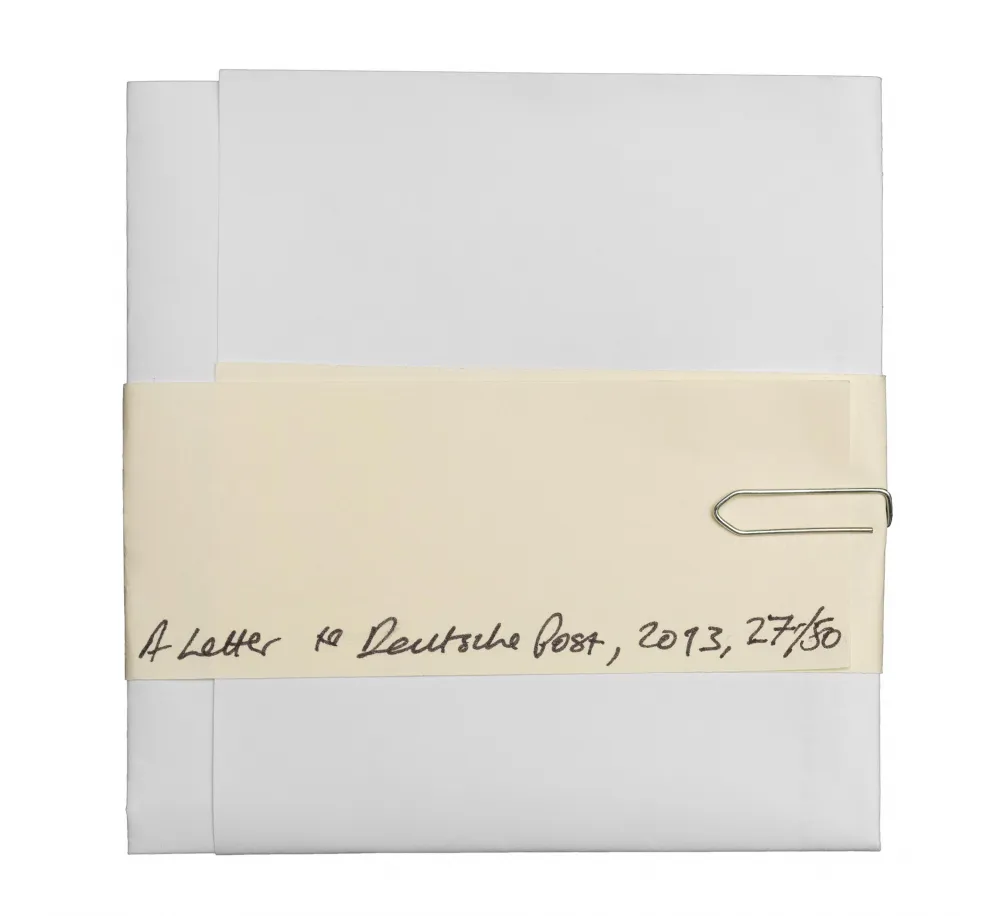
Alex Martinis Roe (born in Melbourne, Australia, 1982), A Letter to Deutsche Post, A4 colour inkjet print, 2013; Jewish Museum Berlin, photo: Jens Ziehe
A Letter from the Museum: An Interview with Alex Martinis Roe
To obtain a letter from a vending machine – even from an art vending machine – is rather unusual. In this interview, Australian artist Alex Martinis Roe explains what motivated her to create the artwork A Letter to Deutsche Post.
Christiane Bauer: Alex, you drafted a letter to Deutsche Post, asking the officers to reissue stamps depicting Rahel Varnhagen and Hannah Arendt. When our visitors purchase the letter, are they supposed to send it to Deutsche Post?
Alex Martinis Roe: I don’t expect visitors to send the letter to Deutsche Post, because I didn’t ask them to. They can do whatever they like with it. If they send it off, I’m happy. If they keep it, I’m also happy. (laughs) What I hope, is that they read the letter and become interested in the story.
Why did you choose to make a letter for the art vending machine?
I chose a letter because it fits inside the drawer of the art vending machine. I didn’t want to make a miniature, but instead work with something already that size. And I liked the idea of integrating this particular story about Hannah Arendt and Rahel Varnhagen into the Jewish Museum. I don’t have the resources to convince Deutsche Post to reissue the stamps, but I thought that the proposal itself is interesting.
Tell us about Arendt’s biography of Varnhagen, and why it should be a part of the Jewish Museum Berlin?
The story I would like to present at the Jewish Museum is one of two kindred spirits. Arendt wrote a biography of Varnhagen, a well-respected writer, who, like herself, was driven out of Berlin due to anti-Semitic persecution. Arendt draws a parallel implicitly, not explicitly, between her own life and the life of Varnhagen, conjuring up a relationship of a very important kind. In forming a link between herself and a female Jewish intellectual from another time, Arendt creates a matrilineal forebear, or genealogical link, to a Jewish woman, rather than – as is common among professional women seeking validation – to a man. She affirms her femininity and Jewishness, without defecting to the dominant culture of white, Christian men.
What topics are important for you in your work?
I’m interested in continental feminist philosophy as it interfaces with contemporary artists and art practices. They seek to build sexuate systems of meaning and validation – by that I mean cultures that are neither presumed to be universal, nor presumed to be made by or relevant to “anyone,” but rather are addressed to specific people. I don’t mean that these cultures are only for women, I mean that they take the difference of each person’s sexual embodiment into account. And right now, more specifically, I am interested in ways of creating connections and networks across time and space, and in troubling the nature-culture binary, which continues to be a source of violence against various differences, among them, sexual difference.
Since people may have diverging definitions of feminism, can you describe what the term “feminism” means for you?
I consider feminism the most peaceful revolution to occur and to continue occurring. Feminism changes the most fundamental way that societies are structured and the deepest, most intimate way people relate to one-another.
What are you currently working on?
Right now I’m making a map, or rather: a web of relations, between different feminist collectives involved, in one way or another, with publishing in Europe. My project is neither a survey nor a documentary, but a specific network of relationships between individual people. It is historic and contemporary at the same time. It spans a period from the early 1970s to the present. Making this map involves working with collectives, negotiating which stories should be told, and fostering a real relationship with the people I meet.
What is the link between your interest in feminist and feminine cultural production and your letter for the art vending machine?
The most important link between the aspects of feminism I mentioned and my letter for the art vending machine is the relationship between Hannah Arendt and Rahel Varnhagen as an example of my interest in genealogies of feminist practices. This term I coined implies being aware of the fact that my generation is indebted to previous generations of feminist activism. Previous activists remain alive in our actions. It’s a way to understand time and foster our relationships with older generations.
Many thanks for the interview, Alex!
Further information about the artist and her work can be found at her website: alexmartinisroe.com.
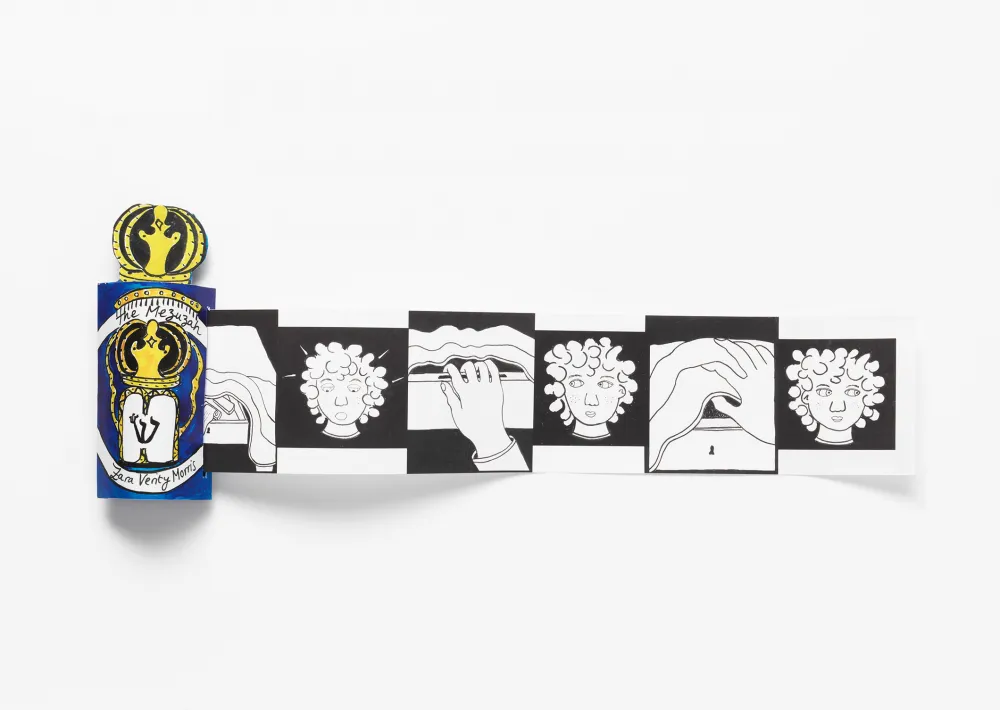
Zara Verity Morris (born in London, Great Britain, 1983), The Mezuzah, comic, digital print, 2013; Jewish Museum Berlin, photo: Jens Ziehe
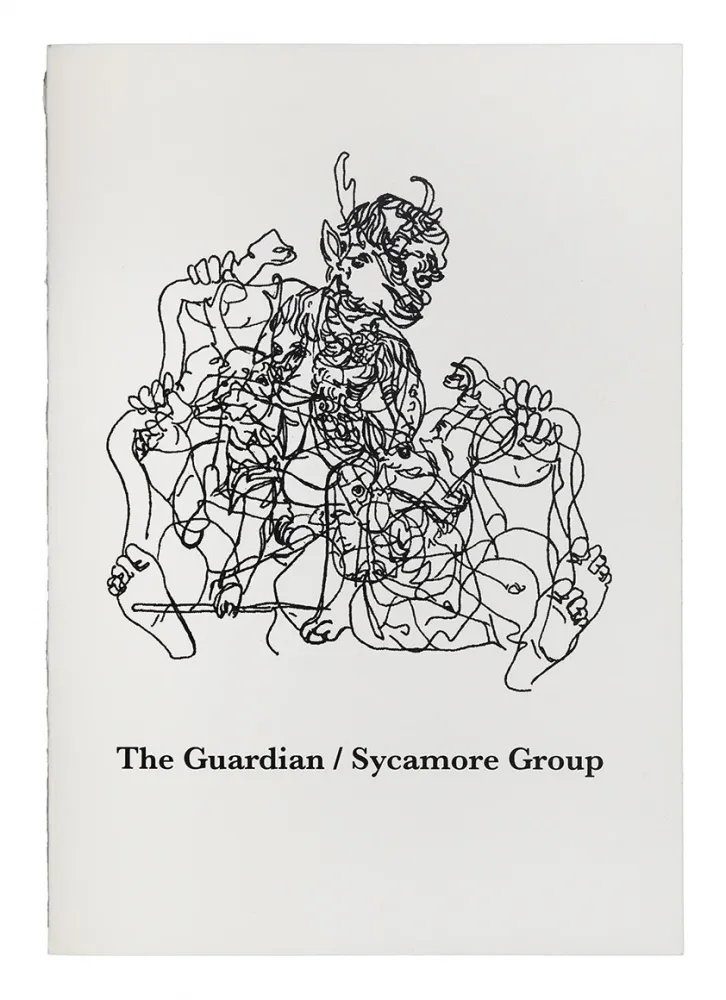
Atalya Laufer (born in Kibbutz Hazorea, Israel, 1979), The Guardian/Sycamore Group, 2013; Jewish Museum Berlin, photo: Jens Ziehe
A Story from the Kibbutz
One of the works in our art vending machine is a booklet which provides an insight into the inner-workings of many of the Israeli Kibbuzim. With sober drawings and a text that is based on archival documents, artist Atalya Laufer (b. 1979) exposes a particular aspect of growing up on a Kibbutz. As one of the last generation of children to be raised in communal children’s houses (Batei Yeladim), she takes us on a journey through time and into the passing world of the Kibutzim.
The text in the booklet is based on protocols of night shifts that were taken in the early 1970s. In these protocols incidents and particularities in every house, during every night shift, had been recorded. Owing to these we can readily reconstruct the daily life in children’s houses.
“I simply do not know what it is like to live with my parents. I find it fascinating that as a child, if I were woken up by a bad dream, I would have had to get out of bed and into the hallway where I could cry onto a small reciever hung up high on the wall with the hope that someone (the person on a night shift) would come. Today, this seems really odd to me.“
The names in the booklet have been translasted quite freely. As often the case with Israeli names, they are names of animals, trees or have biblical origin. The translation allows a distance from the original material, and at the same time, creates an enigmatic narrative, somewhere between a straightforward childrens tale and a surrealistic, dark but humorous one.
In turn, the drawings play with the text and the names associatively. They are based on photographs from the kibbutz as well as on paintings by Pieter Bruegel. The connection between Flemish history, genre painting and life on the Kibbutz is also somewhat puzzling. Atalya explains:
“To me, there is a clear link between Brueghel and the Kibbutz. If my memory doesnt fail me, there were often framed reproductions on the walls of the children houses or, my parents may have had a book of his prints. But, of course, perhaps needless to say, Breughel is regarded today for his detailed representation of ‘mysterious’ peasant life. The comparison between Kibbutz and rural life is relevant, at least on the level of ‘mysterious’ innate structures, traditions, languages and rituals that for an ‘outsider’ may be difficult to understand but at the same time likely to find fascinating.”
For Laufer the process of artistic appropriation of a particular reference material begins often with drawing from a reproduction of the original. After this relatively direct transformation, she develops the image into a complex of lines and motifs through layering several drawings on top of each other until. Similarly, the text is also a collage of several text extracts.
Laufer refers to her works as “appropriated readymades”. The book is neither biographical nor fictitious and can be neither easily pigeonholed or taken out of a particular drawer. Nevertheless, with a bit of luck on your next visit to the museum, you could pull out one of the booklets from the art vending machine. Flipping through a few pages of the booklet offers an impression of Atalya Laufer’s artwork.
Christiane Bauer, Exhibitions
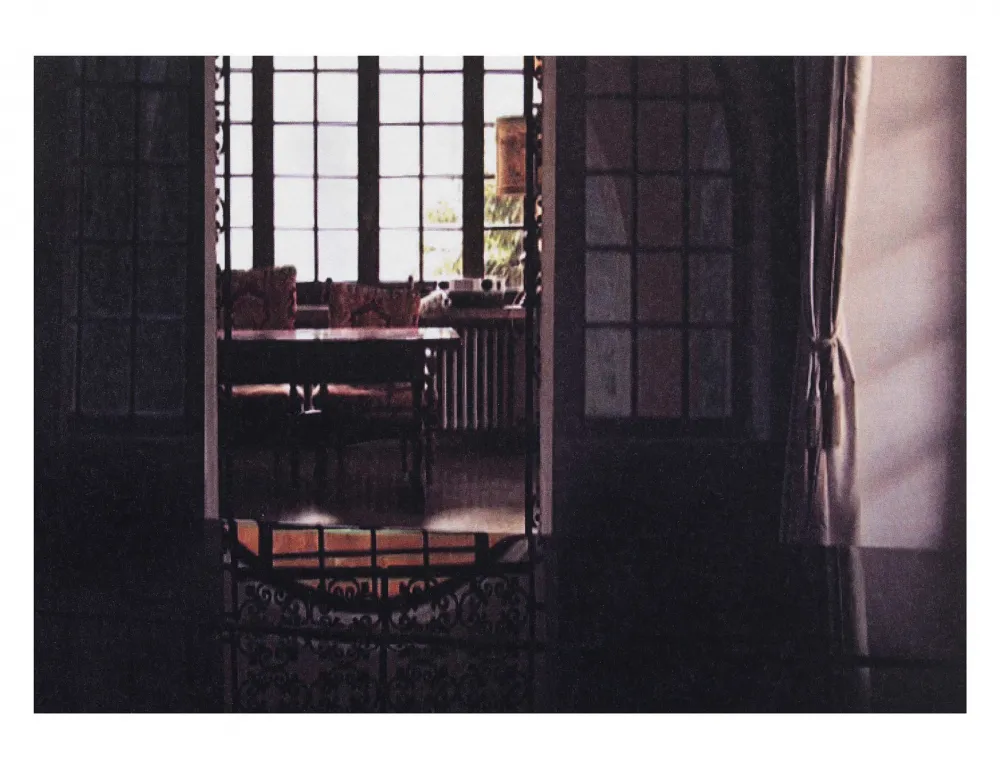
Daniel Laufer (born in Hanover, Germany, 1975), Black Pitch, video still from the movie The Fourth Wall, inkjet print 2013, signed; Jewish Museum Berlin
The Fourth Wall: An Interview with Daniel Laufer
The card shows a film still from the video, The Fourth Wall (at 08:13 min). The story is based on an Hasidic parable about two men who are supposed to design one half of a house. While the first man does his work with zeal, the second delays, uninspired. The second man, who is certain that he won’t come up with a better idea than his rival, decides to coat his work with black bitumen. The material will reflect the other half of the house like a mirror. Thus he discovers a good solution to avoid defeat. The film was shown this year at the 14th Videonale at the Bonn Art Museum.
In the following interview, Daniel Laufer talks about the genesis and message of his postcard.
Christiane Bauer: Daniel, you work mostly in video form. Yet you produced a postcard for the art vending machine. Why did you choose this format?
Daniel Laufer: A postcard is something mobile that you can take with you. It connects you to something: it provides information and contains a message. It can be a souvenir – but with a statement. And I also like the fact that you can hang it on the wall.
The original work of art is an entire film. Why did you choose this particular shot as a motif for the postcard?
The scene shows innumerable mirrors. At first glance they’re only vaguely perceptible, and it’s hard to differentiate reality from reflection. In the end everything might be a reflection. Look at the black surface in the foreground: that’s a grand piano reflecting the window, which you can also see reflected by the mirror on the wall. There are two places in the film where you see these mirror surfaces for what they are. Otherwise you can’t tell them apart from reality. The postcard shows the point in the film where you realize: from this moment on, everything could be a reflection. This one film still captures the essence of the entire parable.
What gave you the idea of turning this Hasidic parable into a film?
I liked the parable because you can adapt it to the subject of the reception of art. Many people would probably think that the man who really struggled and worked hard should get paid for it. And the man who just covered his side with shiny black material to reflect the other half, he achieved less and should leave empty-handed. Looking at this assumption can sensitize the audience to the question, “What do we consider art?” Although it’s less work to create this mirror from black bitumen, we shouldn’t underestimate the mental and creative work involved: the mirror reflects everything in the other room, not only now but in the future. In this way it becomes a perfect work of art. Not even a very beautiful painting can achieve this because it always only shows what was. It will never be able to depict anything more.
I also find the parable significant, because its author, rabbi Nachman, has been an important inspiration to me. Rabbi Nachman, the grandson of Baal Shem Tov, wrote a number of stories that can be read as spiritual vehicles. Traditionally they’re told aloud, and as you listen and think about them you enter into a spiritual process. Usually the stories offer different approaches to life that exceed religious structures. This fascinates me.
How did you put the film together?
I work with two media jointly: painting and film. For my films – and also for my installations – I work with the principle of “Matte Painting,” which is to say, I place a transparent glass frame in front of a background, such as a landscape, and I paint additional elements on the glass. Then I film through the sheets of glass that I’ve layered on top of each other. The painted and real parts blend together into one picture. I’ve been developing this technique further and now always work with an installation consisting of film and very large glass frames.
Where can we see your work in the future?
I have a catalogue presentation at art cologne this coming year (from 9 to 13 April 2014) and three solo exhibitions:
- Glasmoog KHM, Cologne, 14 March to 4 May 2014
- Kunstverein Harburger Bahnhof, Hamburg, end of October 2014
- KM Galerie, Berlin, middle of November 2014
Thank you, Daniel, for the discussion and best wishes on your next projects!
Christiane Bauer, Exhibitions
